
- Testimonials

73 Silly & Wild 3rd Grade Story Prompts!
by Royd Hatta
May 21, 2023
Exercises, Reluctant Writer, Story Writing, Writing Prompts, Young Writers
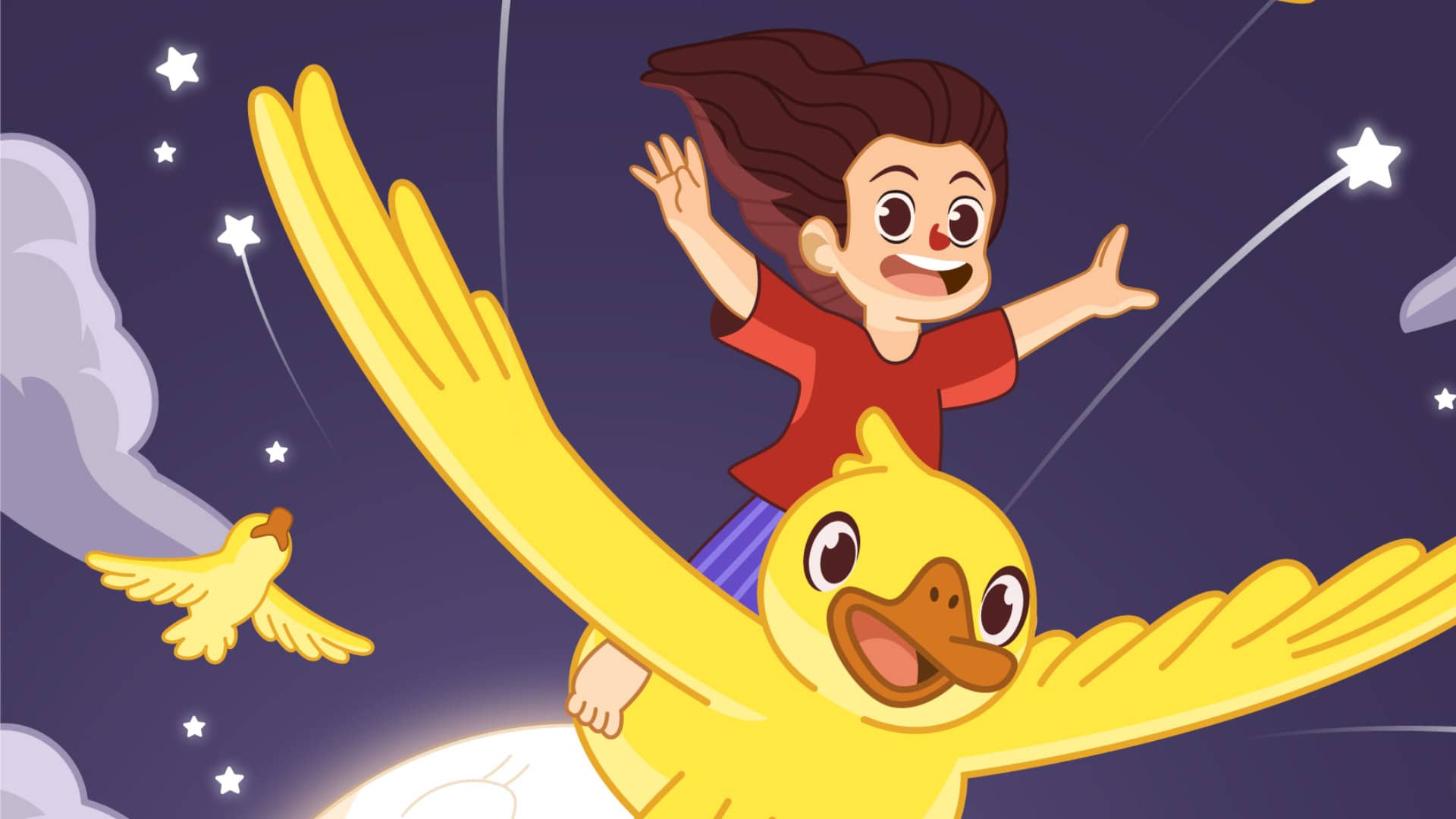
Here's a list of our 3rd Grade Story Prompts that will inspire your 3rd grader to pick up a pencil or pen and let the words flow!
Parents and kids, if you can think of a fun prompt that you want to share here, feel free to contact me at our Contact page !
If it's a good fit for this list, we'll include it along with your first name and last name's initial.
Oh, and if you have a story that you wrote based on these crazy prompts, no matter how short or long, I'd love to read it! Maybe we'll post it on this blog!
Finally, for basic Story tips that we use to begin OR add to your rollicking tales, scroll to the bottom and use what works for you.
Okay! Now " knock OUR socks off with your story!" That is, go wild and impress us with a fun hero on a silly and wild adventure. We can't wait to read it!
Writing Coach
Fantasy • Story Prompts
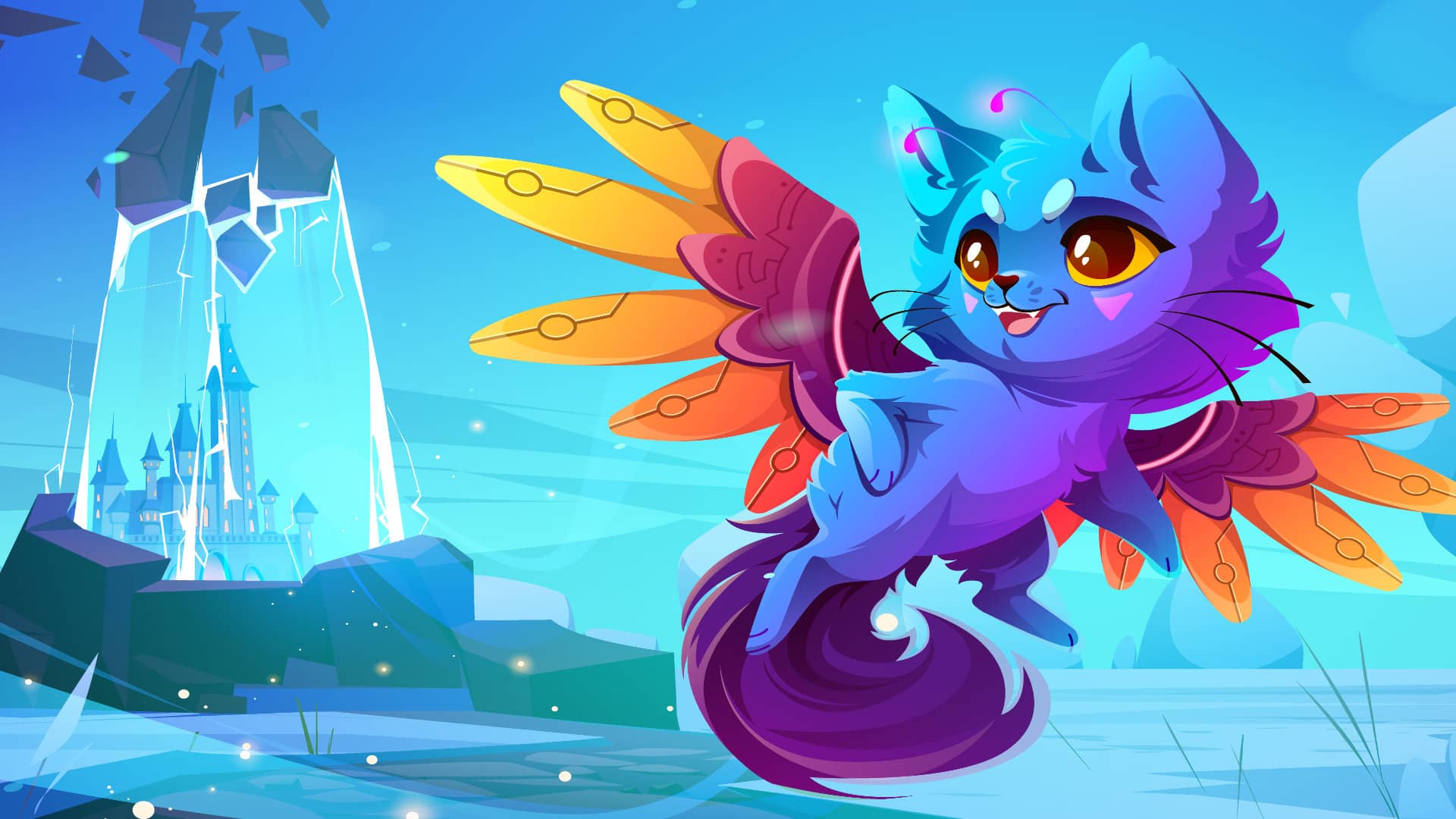
Image by upklyak on Freepik
- A magical key opens doors to different worlds every time it is turned.
- A friendly monster lives in a book and helps children fall asleep at night.
- A fairy plays pranks on humans until she learns the importance of kindness.
- Sea creatures have to work together to save a mermaid trapped in a shipwreck.
- A boy finds a talking rock that grants wishes.
- What if you found a secret door in your house that leads to a magical world?
- What if you discovered a portal that takes you to the land of giants?
- What if you found a mysterious potion that can make you invisible?
- What if you had a magic wand that could grant three wishes?
- A group of toys come to life and go on an adventure to find their missing friend.
- What if a group of magical creatures help a prince find his princess?
- What if a cat with wings was a legendary hero that fought evil kings?
- What if you could ride on an enormous pet bird to a magical world? (by Y.H)
Silly Animals • Story Prompts

Image by Freepik
- A gathering of pets have to find the perfect outfit to wear to the fancy animal ball.
- An adventurous rabbit goes on a journey to find the biggest carrot in the world.
- A wise old owl helps a lost baby mouse find its way back home.
- A snowman who wants to be a firefighter.
- A crab that dreams of being a ballerina.
- A horse who learns how to play the guitar.
- A lion who wants to be a vegetarian.
- A penguin who becomes a famous artist.
- A fish who wants to fly.
- A turtle who becomes a ninja.
- A spider who wants to be a fashion designer.
- A koala who wants to be a professional wrestler.
- A butterfly helps a group of flowers find their missing colors.
- A cat becomes a fashion designer and creates trendy outfits for other animals.
- A lion becomes a painter and creates beautiful works of art.
- A caterpillar eats in a magic garden and turns into a magic butterfly.
- A sneaky squirrel steals all the nuts from the other animals in the forest.
- A bear who learns how to ride a bike.
- An elephant who wants to be a singer.
- A snake who wants to be a magician.
- A giraffe becomes a detective and solves a mystery in the savanna.
- A crab learns how to surf and becomes a champion.
- A kangaroo becomes a basketball player and leads his team to victory.
- A worm becomes a scientist and discovers a new species of insect.
- A worm becomes a superhero and saves the day.
- What if a dolphin learns how to play the piano and becomes a famous musician?
- A group of animals have to plan the ultimate surprise party for their best friend.
- A team of birds build the biggest nest to win the annual birdhouse competition.
- A sea creature team must compete in the Ocean Olympics to win the gold medal.
- Animal detectives must solve the mystery of a missing cake from a bake sale.
- Silly insects must form a band at the bug music festival.
- Hamsters build their own amusement park for their friends to enjoy.
- Neighborhood animals create their own superhero team to save their city.
- Furry creature friends plan the best birthday party ever for their friend in the forest.
- A band of animals invent their own toys to sell at the animal toy store.
- Animals plant their own garden to make the best salad for the annual food festival.
Science Fiction • Story Prompts

- A superhero dog saves the day and becomes the town's beloved hero.
- What if you woke up with the power to talk to animals?
- What if you exited a building and found yourself in the time of the dinosaurs?
- What if you were granted the power to time travel?
- What if a robot learns how to play soccer and leads his team to victory?
- What if a group of ants builds a rocket ship to explore outer space?
- A robot must create new gadgets for itself to win the obstacle course championships.
- An alien learns about Earth and makes new friends at an outdoor summer camp.
- Three kids must design and build a cool new vehicle to travel to Mars.
- A robot creates new strange recipes that kids want to eat.
- What if a kid inventor builds a pet robot that can almost do anything!
Adventure • Story Prompts
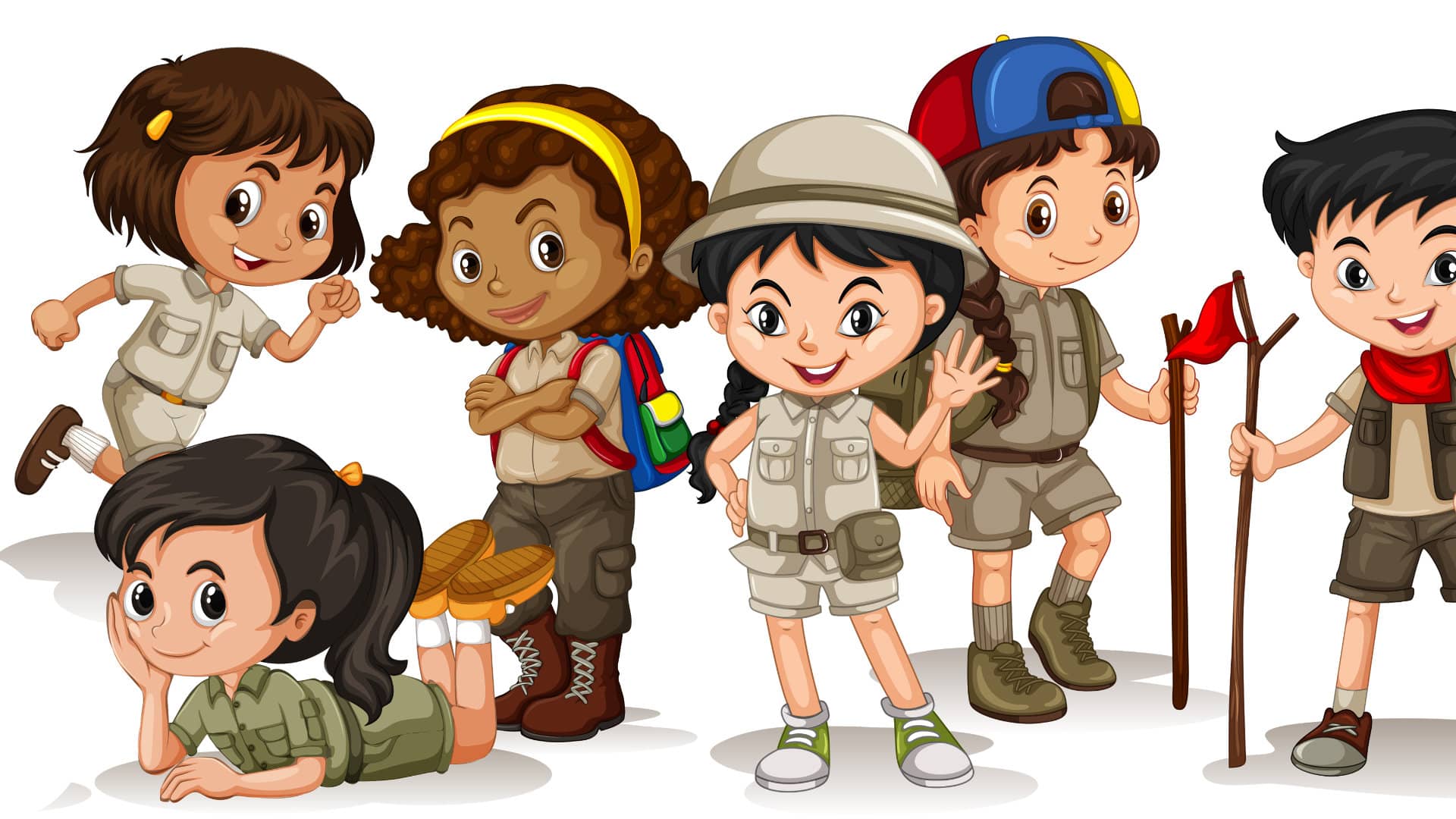
- A group of kids discover a lost treasure in an old abandoned amusement park.
- Four friends design and build the fastest roller coaster in the world.
- Three friends design and build their own crazy treehouse for their club meetings.
- A brave firefighter saves a cat from a burning building.
- A group of kids build their own pirate ship and go on an adventure to find treasure.
- Kids put on a talent show to raise money for their local animal shelter.
- What if you discovered a hidden world inside your closet?
- What if you found a genie in a bottle?
- What if you found a map that leads to a lost city of gold?
- What if you discovered a talking tree in the forest?
- What if you found a book that can transport you to other worlds?
- What if you discovered a secret lab hidden beneath your school?
- What if a group of penguins go on a mission to find a lost treasure in Antarctica?
- What if a little girl discovers a secret garden filled with talking animals?
Beyond the Box Writing Tips:
- Make us Worry
- Make us Care
- Create a Strong Want for your Hero. What Must they do?
- Focus on your character’s relationships or tension with others .
- Find your flow! “Just get into the Story” and walk in your hero’s shoes .
- Observations (Nuggets of Wisdom)
- Description
Check the articles below
March 13, 2024
Forgotten Wolves
March 12, 2024
The Princess Witch
It was a normal day for flora.

30 Fun And Creative Writing Prompts For 3rd Grade

Writing prompts can be incredibly beneficial for third-grade students as they not only stimulate their imaginations but also enhance their critical thinking and writing skills. By presenting them with different scenarios, characters, and situations, writing prompts encourage children to delve deep into their creativity and explore various narrative possibilities.
As a teacher, the key to activating third-grade students’ imaginations is to give them fun writing prompts to get them excited about writing. Below you’ll find 30 fun and creative writing prompts for 3rd-grade students that are guaranteed to spark your students’ imaginations and get their creative juices flowing.
Writing Prompts For Third Grade

- Imagine you wake up one morning to find out you’ve become a superhero. What are your powers and how would you use them?
- Write a story about a magical tree that grows in your backyard. What is special about it?
- What would you do if you could fly for a day? Describe your journey in detail.
- If animals could talk, what would your pet or a favorite animal say? Write a conversation you might have.
- Imagine that you have been given the task of redesigning your school. What changes would you make and why?
- Write a story about a character who lives in a world where colors have been lost. How do they restore colors back to their world?
- Write a letter to your future self. What advice would you give?
- Imagine that you found a door in your house that you’ve never seen before. Where does it lead to?
- Write about a day in the life of your favorite dessert. Make it as fun and wacky as possible.
- Write a story from the perspective of a raindrop on a rainy day.
- You have been given a magical pen that makes everything you draw come to life. What do you draw first and why?
- Imagine you are an astronaut exploring a new planet. Describe what you see, hear, and feel.
- If you could be any mythical creature for a day, what would you be and why? Describe your day.
- Write a story about a mischievous ghost who lives in your school.
- You’re a detective and you’ve been assigned to solve the case of the missing cookies. Who are your suspects?
- Your favorite toy comes to life! What adventures do you two have together?
- What if you woke up one day and everything was upside down? Write about your day.
- Write a story about a magical flower that only blooms once every hundred years. What happens when it blooms?
- If you had a pet dragon, what would a day in your life look like?
- Write a story about an adventure in a submarine deep under the sea. What creatures do you see?
- Imagine you could swap places with your teacher for a day. What would you do?
- Your shoes suddenly gain the ability to talk. What stories do they tell you about where they’ve been?
- Write a diary entry for a pirate sailing the seven seas in search of treasure.
- If you could invent a new holiday, what would it be, and how would people celebrate it?
- You find a magic pebble that grants you three wishes. What do you wish for and why?
- Write a story about a visit to a planet made of candy.
- What would it be like if animals were in charge and humans were pets?
- Write about a day in the life of a coin. Where does it go? What does it see?
- You have been chosen to host a party for all the fairytale characters. How would you plan and organize it?
- Imagine you could breathe underwater. Write about your adventures under the sea.
Tips For Using These Writing Prompts In Class

As a third-grade teacher, you are likely aware that merely providing students with a writing prompt may not yield the most effective outcomes. To help students fully tap into their creative writing abilities, consider these actionable strategies.
Offer Clear Instructions
Make sure to explain the prompt clearly and in a way that your students understand. If the prompt is complex, break it down into smaller parts. Ensure they understand the task at hand before they start writing.
Create a Safe Environment
Encourage creativity and originality. Let your students know that it’s okay to make mistakes and they should not be afraid of expressing their unique ideas.
Provide Examples
Sometimes, students may find it challenging to start. Providing an example or two can help them understand the prompt better and stimulate their own ideas.
Use Prompts as Conversation Starters
Discuss the writing prompts in class before students start writing. This will help stimulate ideas, and hearing their peers’ thoughts can inspire students who may be having difficulty.
Use Visual Aids
For younger students, visual aids can be really helpful. Draw a picture, show a video or use storyboards to help illustrate the prompt and get their creative juices flowing.
Allow Choices
If possible, offer more than one writing prompt at a time. Giving students the ability to choose their writing topic can make the task more engaging and personal for them.
Encourage Peer Reviews
After students have written their pieces, encourage them to exchange their stories with their classmates for peer review. This can help students learn from each other and also improve their editing and critiquing skills.
Provide Constructive Feedback
Giving feedback is crucial. Praise students for their efforts and provide constructive criticism to guide them on how to improve their writing.
Include Prompts Related to Current Lessons
While creative prompts are excellent, try to include some prompts that relate to what students are learning. For example, if they’re learning about animals’ habitats, include a prompt about it.
Schedule Regular Writing Time
Make writing a regular activity. Consistency can help students get into the habit of writing and improve their skills over time.
More Writing Prompts
Thanks for reading! I hope your students have lots of fun creating awesome stories using these writing prompts. Before you go, check out these related articles for writing prompt ideas: 1st Grade Writing Prompts 4th Grade Writing Prompts Adventure Writing Prompts Fantasy Writing Prompts
- Grades 6-12
- School Leaders
FREE Book Bracket Template. For March and Beyond!
50 Creative 3rd Grade Writing Prompts (Free Printable!)
Taking the leap from the primary level to the intermediate grades.
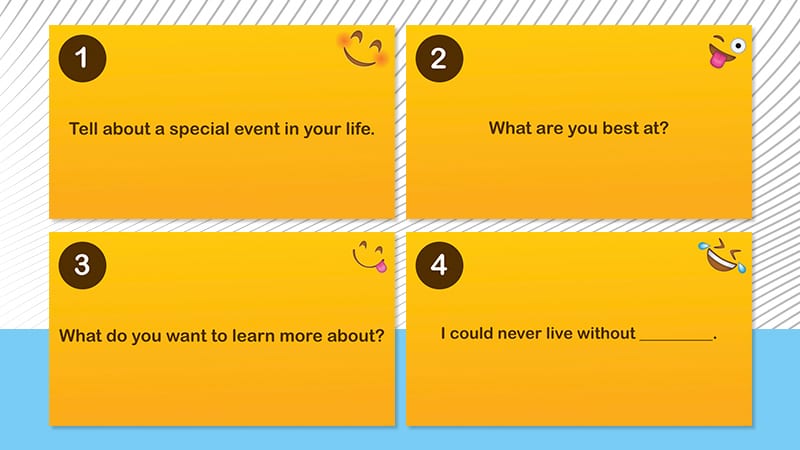
Third grade is a huge transitional year in elementary school. Third grade writers have learned foundational concepts and skills and have had time to practice. Now they are developing more complex skills as they dig deeper, learn to make connections, and analyze the topics they write about. Here are 50 third grade writing prompts to help your students master and refine their writing skills.
If you’d like even more upper elementary writing prompts, we publish new ones twice a week on our kid-friendly site: the Daily Classroom Hub . Make sure to bookmark the link!
(Want this entire set in one easy document? Get your free PowerPoint bundle by submitting your email here, so you’ll always have the prompts available!)
1. Tell about a special event in your life.
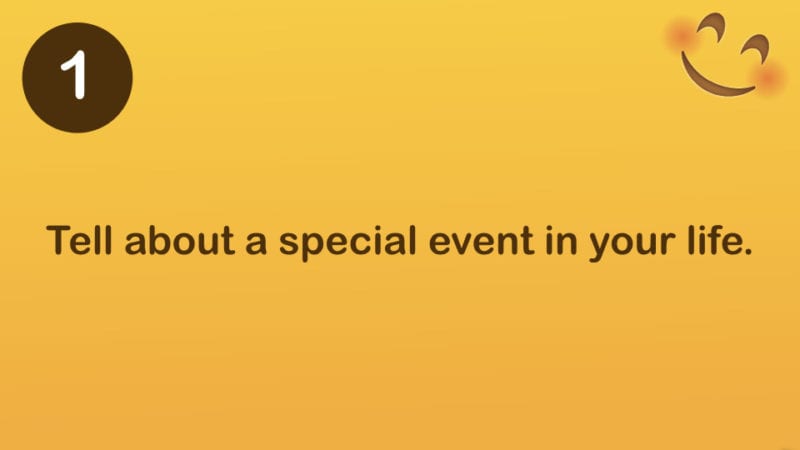
2. What are you best at?
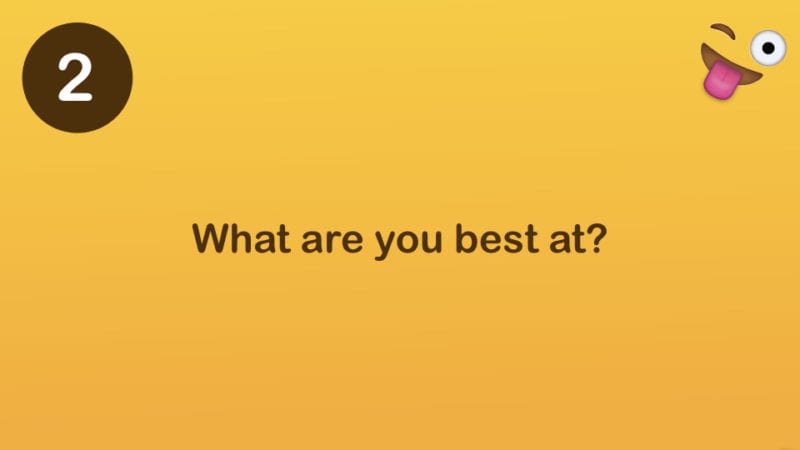
3. What do you want to learn more about?
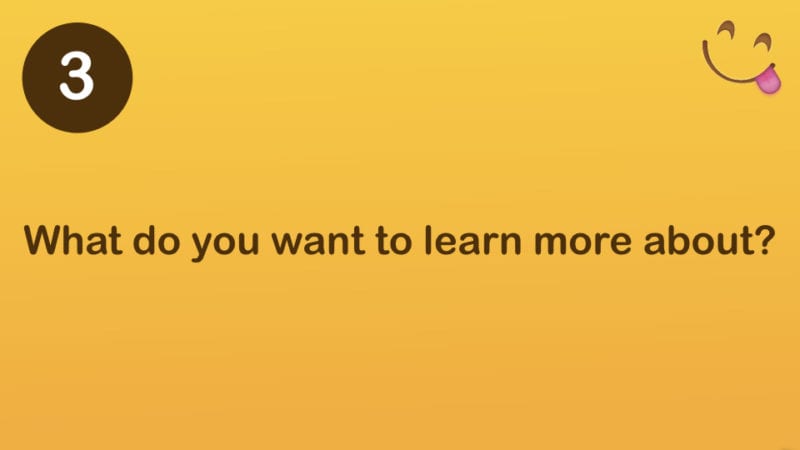
4. I could never live without______.
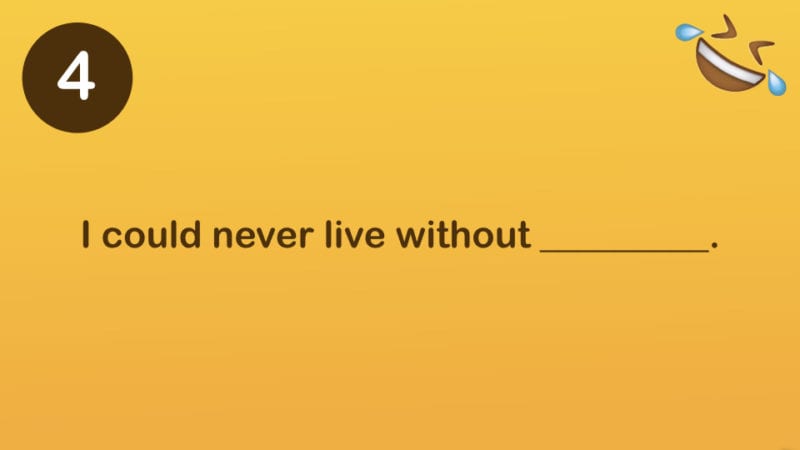
5. If you could go anyplace in the world, where would you go and why?
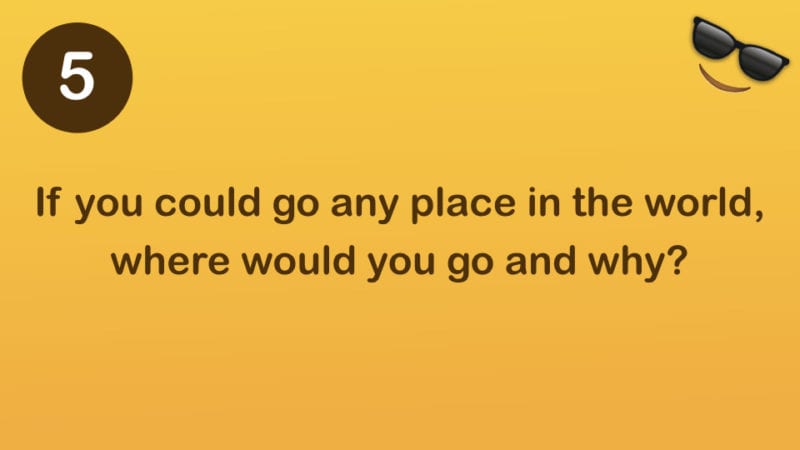
6. Interview one of your parents or grandparents and ask them to tell you a story from their childhood. Share their story here.
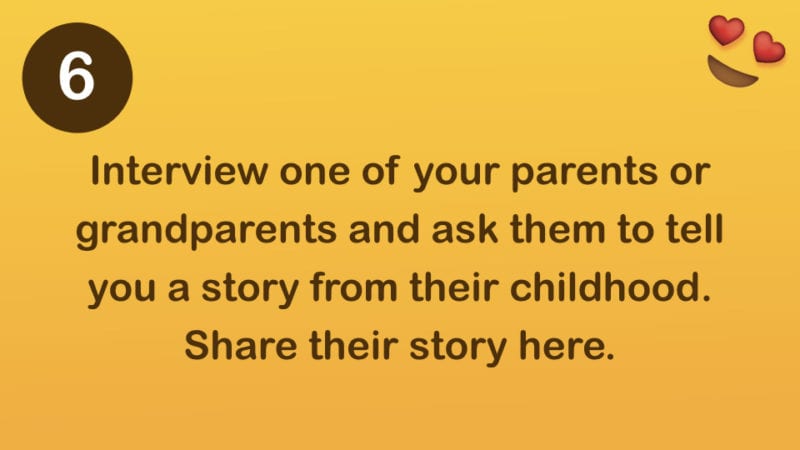
7. Describe one of your favorite book characters. Tell three things about their personality.
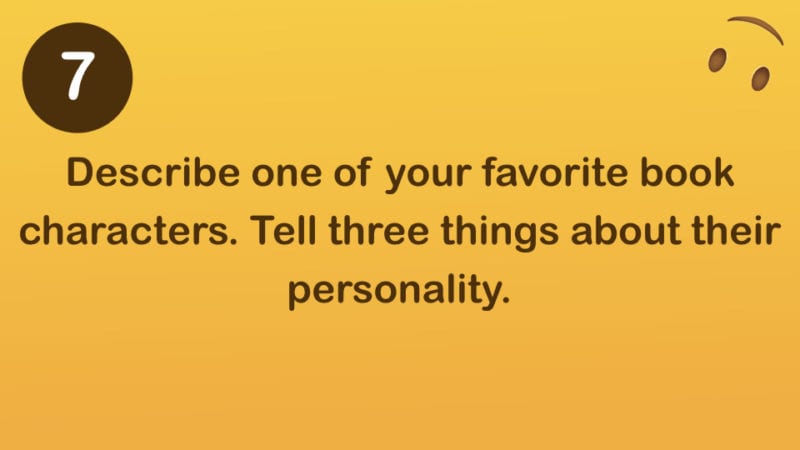
8. Do you think third graders should have to do chores at home? Why or why not?
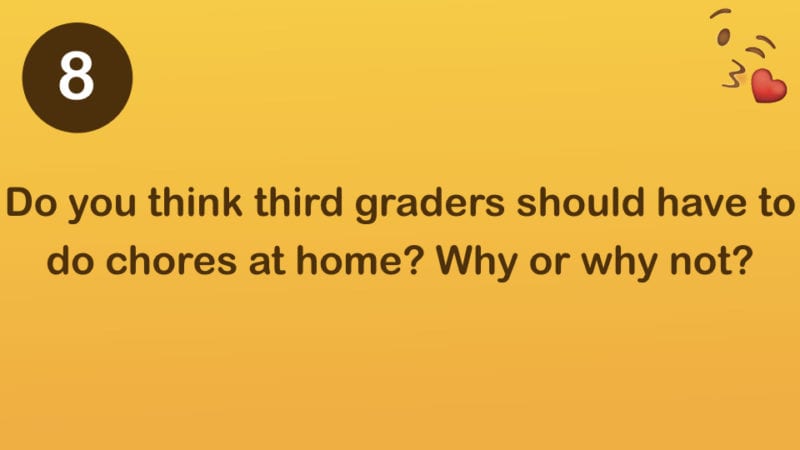
9. What is something you would change about school if you could?
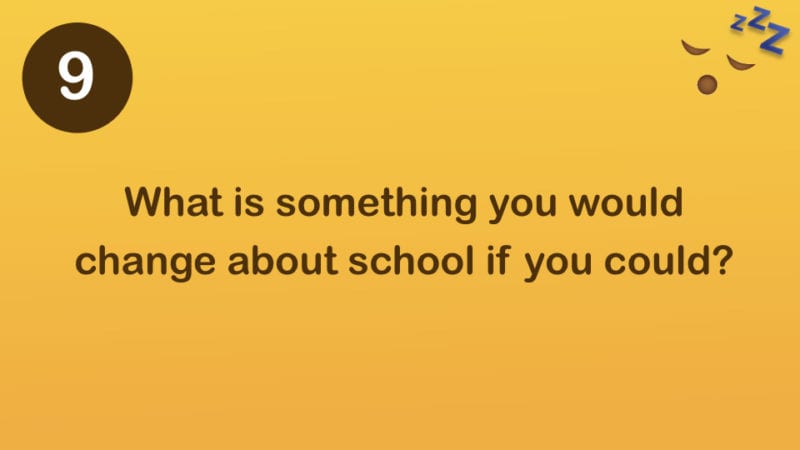
10. Tell about a time you helped somebody.
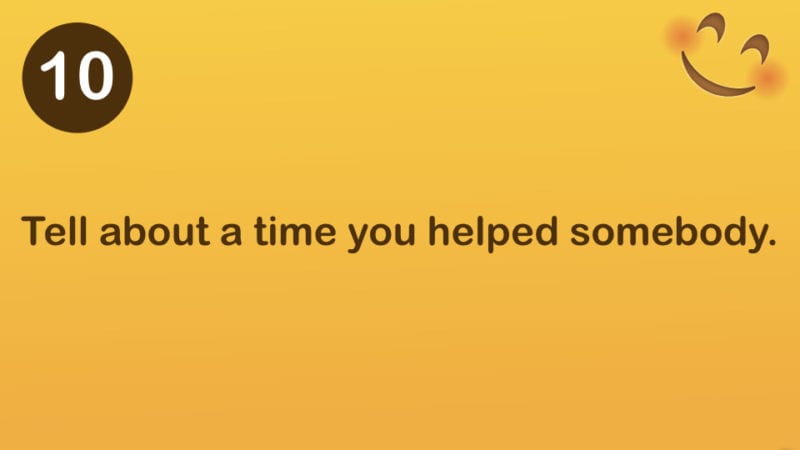
11. Tell about a time somebody helped you.
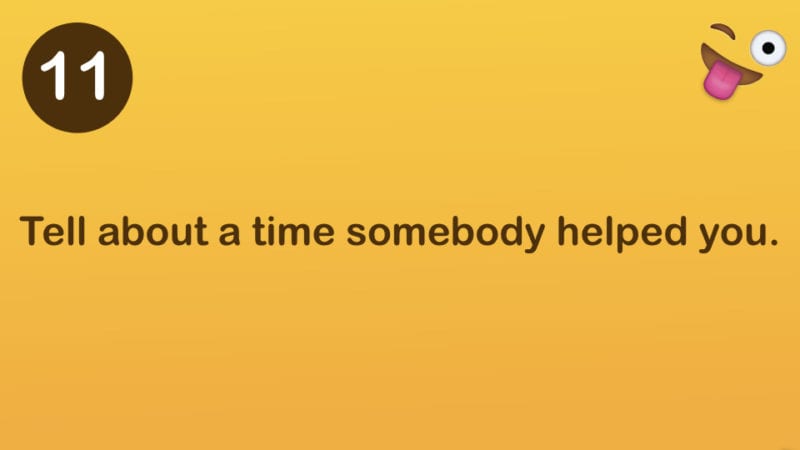
12. Tell about a memorable “first” in your life. For example, the first time you ate a particular kind of food, the first time you met your teacher, etc.
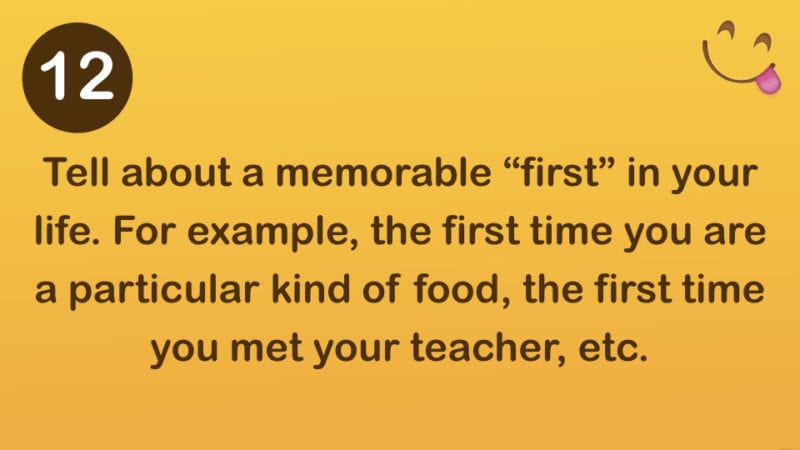
13. Describe step by step how to make a pizza.
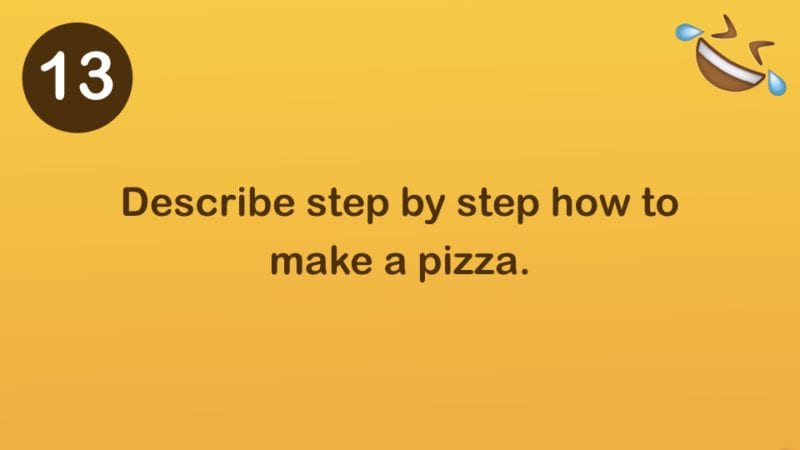
14. What does it mean to be a hero?
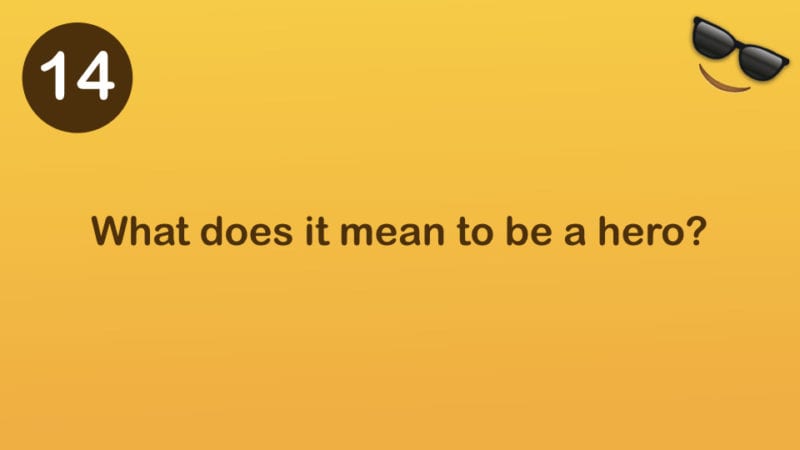
15. I am afraid of _______ because_______.
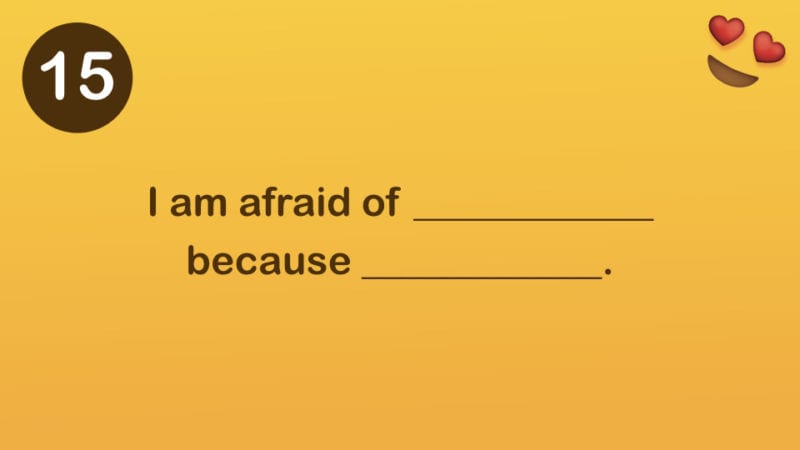
16. What is the difference between being polite and rude? Give three examples.
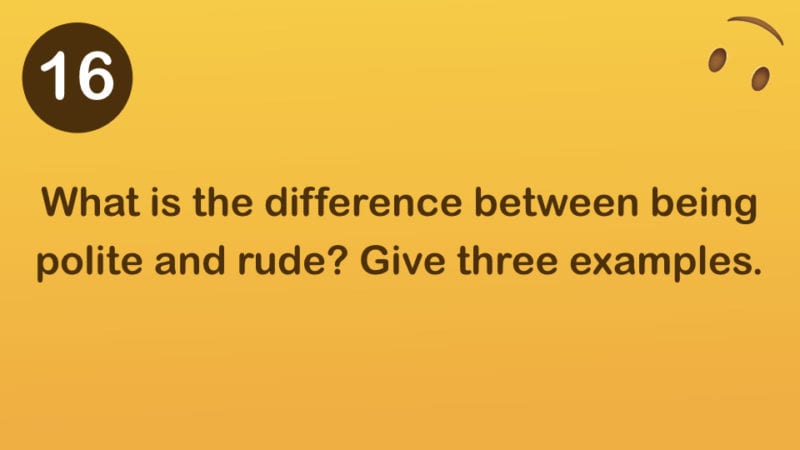
17. What is the most important rule in the classroom?
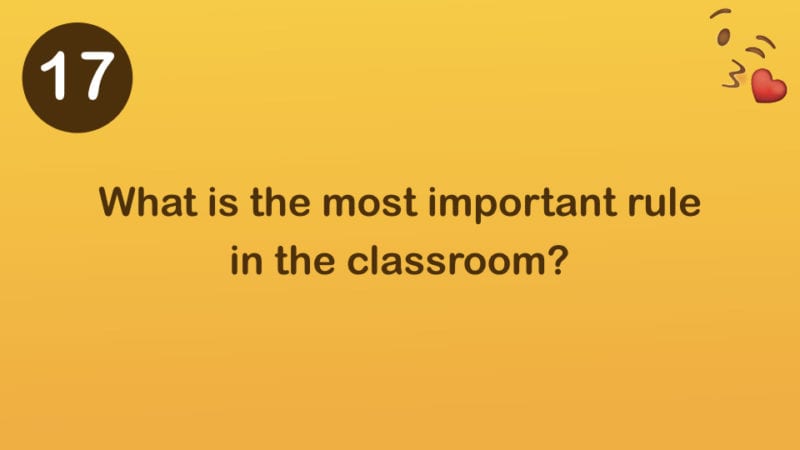
18. What are the three most important qualities you look for in a friend?
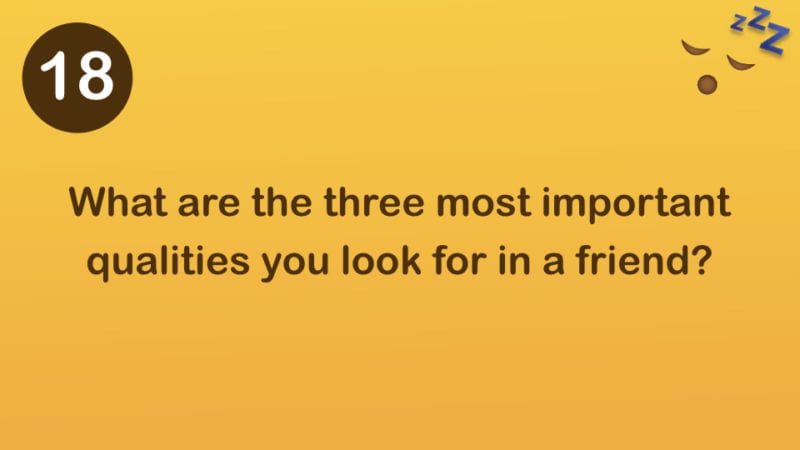
19. Do you think kids should be assigned homework? Why or why not?
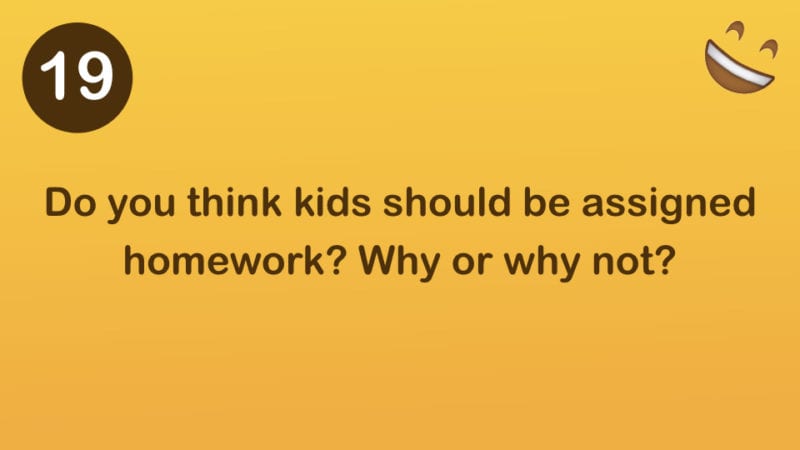
20. Nature gives us many beautiful things—plants, animals, water, weather, stars and planets, etc. What is one of your favorite things in nature and why?
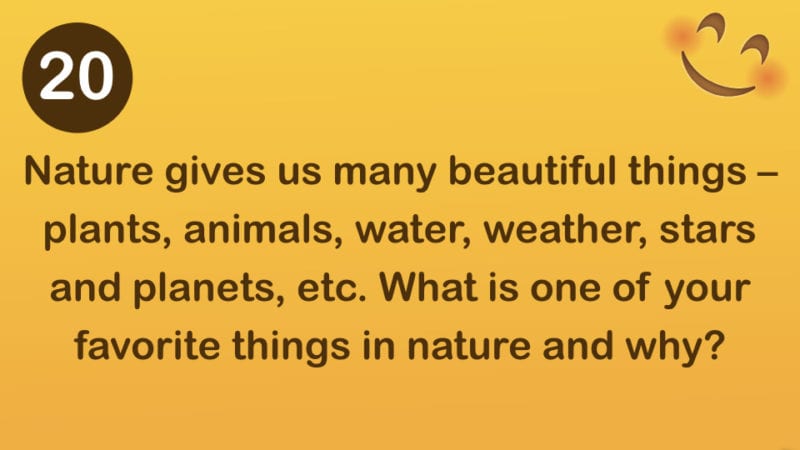
21. If I were a spider, I’d _______.
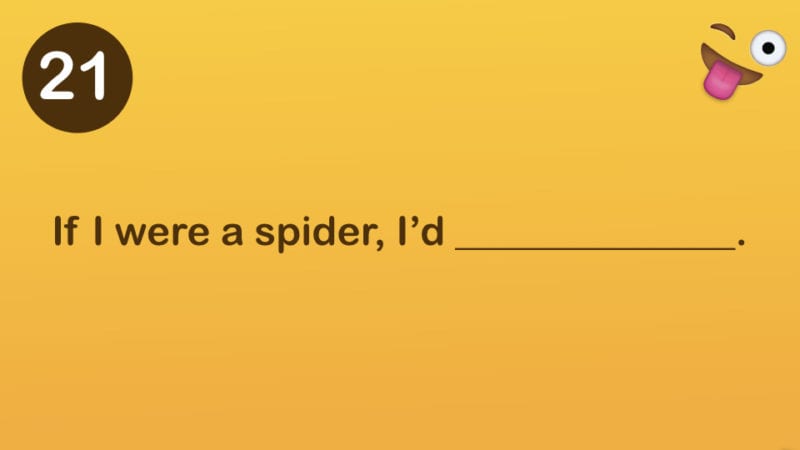
22. Three things that make me happy are ______.
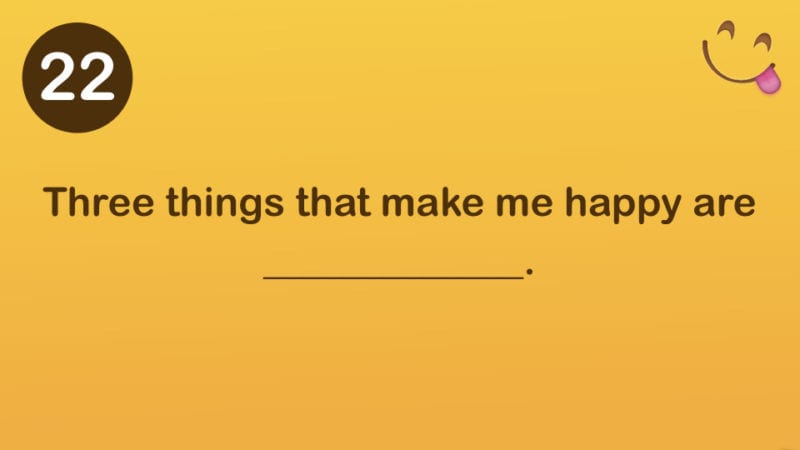
23. What is your favorite holiday and why?
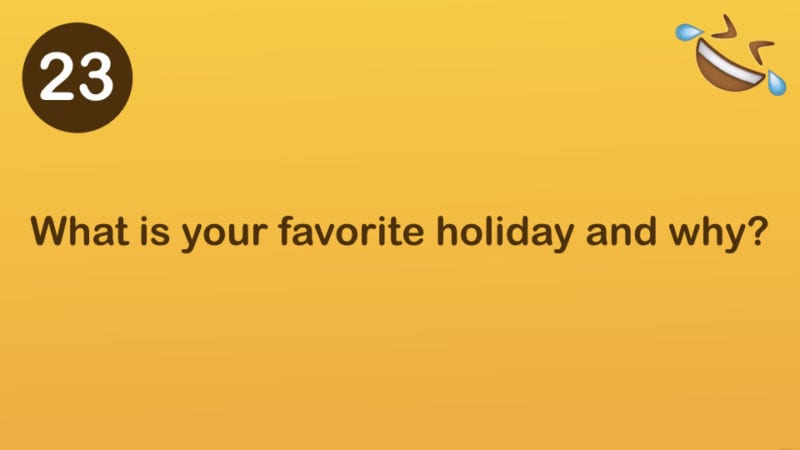
24. Tell about one of your family’s unique traditions.

25. If you could have a pet, what would you choose? How would you take care of it?
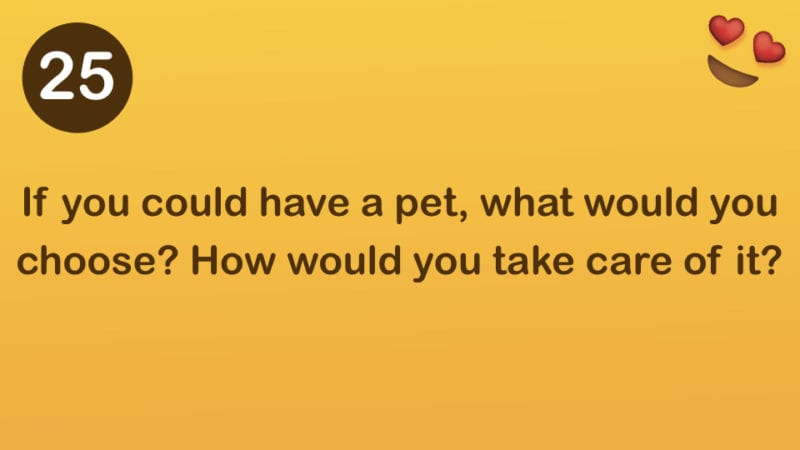
26. Write about a dream you recently had.

27. Tell about a person that inspires you and why.
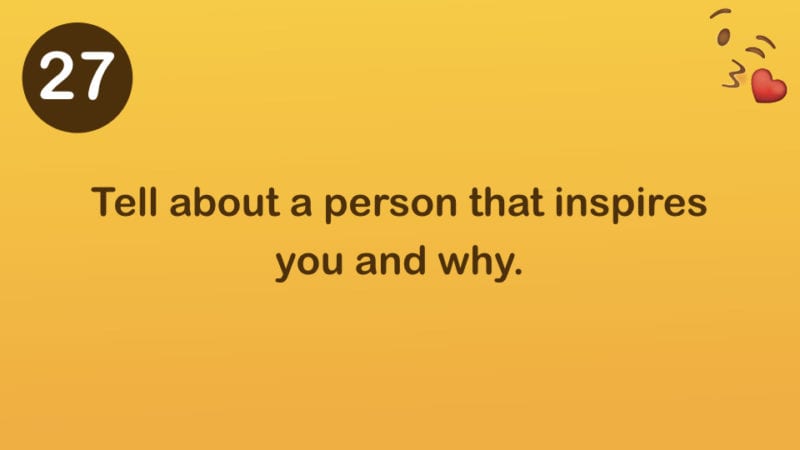
28. Name five things you are thankful for and why you are thankful for them.
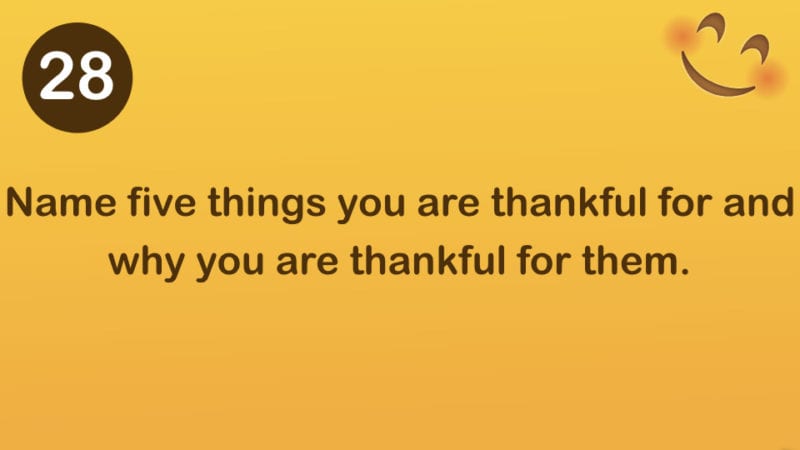
29. What are ways you can be a good citizen?
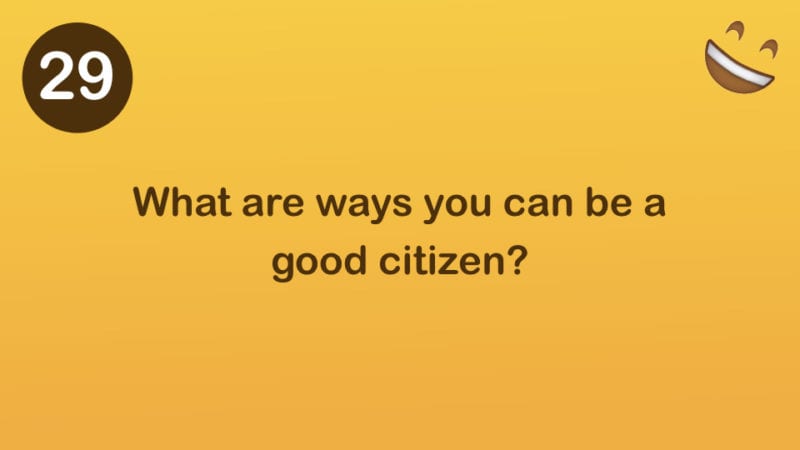
30. When you and a friend disagree, how do you work it out?
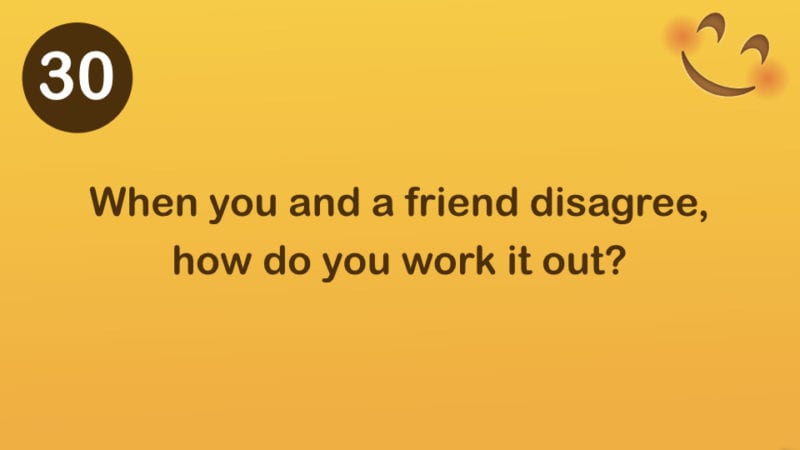
31. What do you think the world will be like in one hundred years?
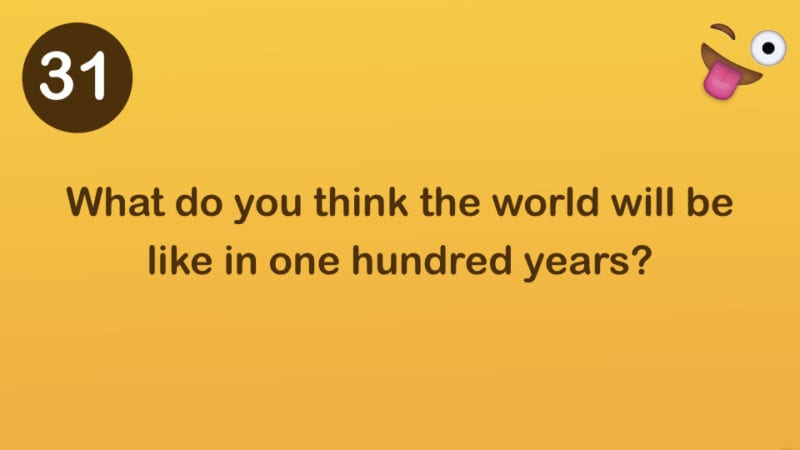
32. What is your favorite type of weather? Why?
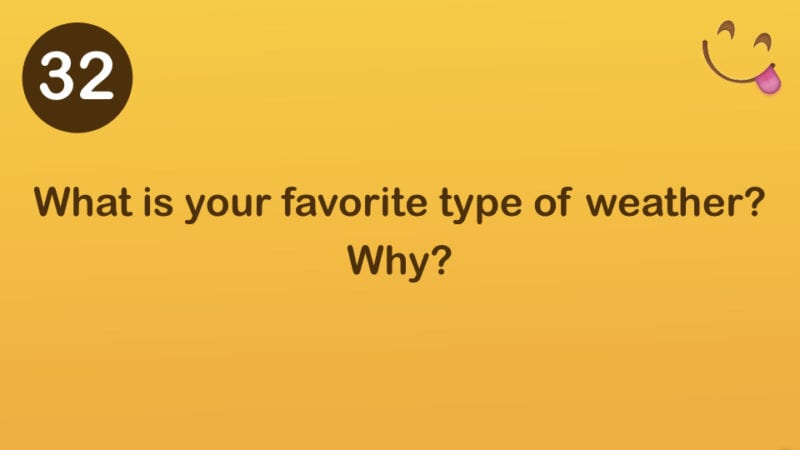
33. What superpower do you wish you had? Why?
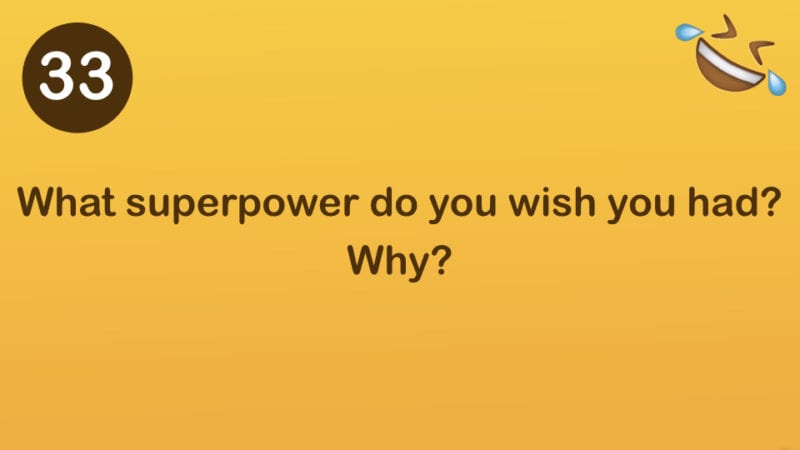
34. What famous person would you like to meet? Why?
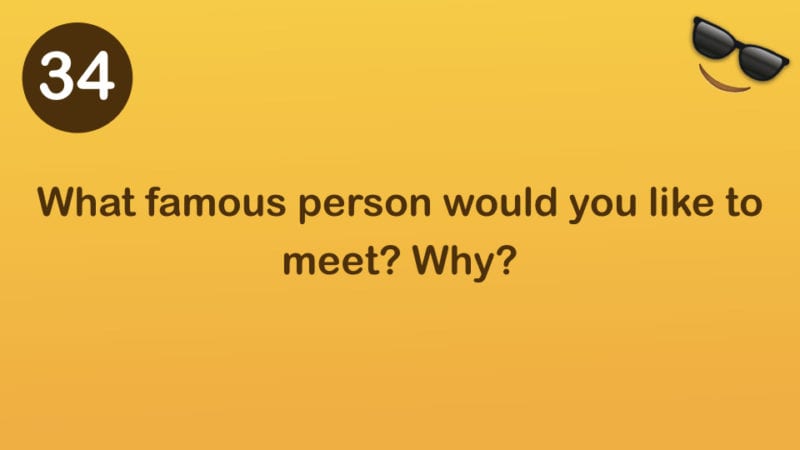
35. In your opinion, which animal makes the best pet? Give three reasons for your answer.
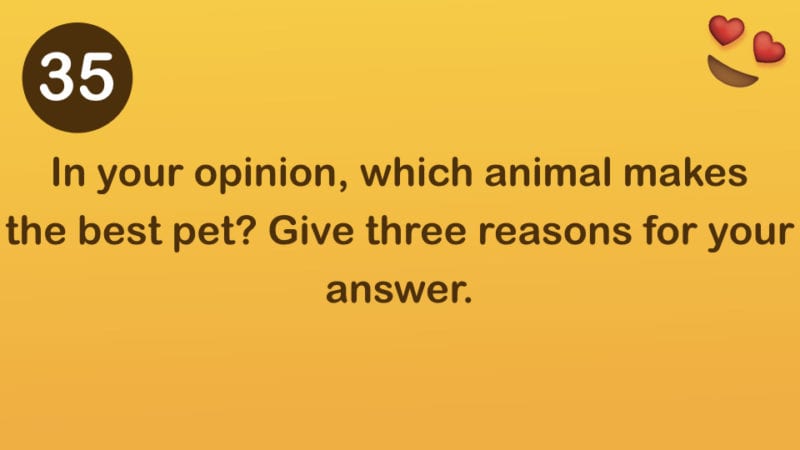
36. If someone gave you $100, how would you spend it?
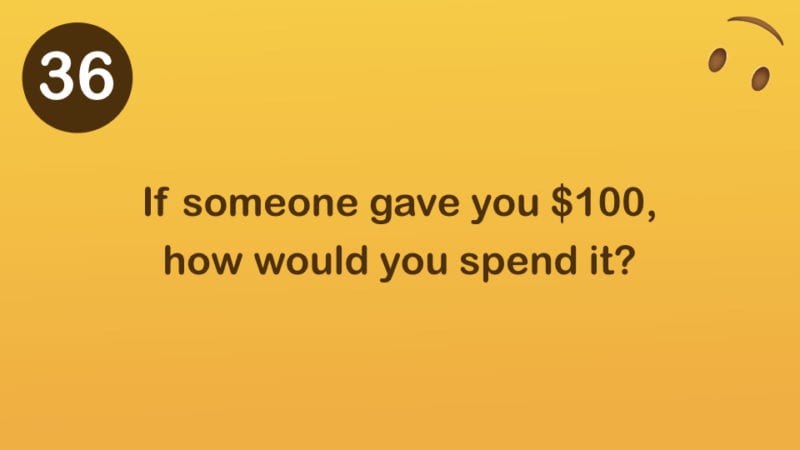
37. Should third graders have cell phones? Why or why not?
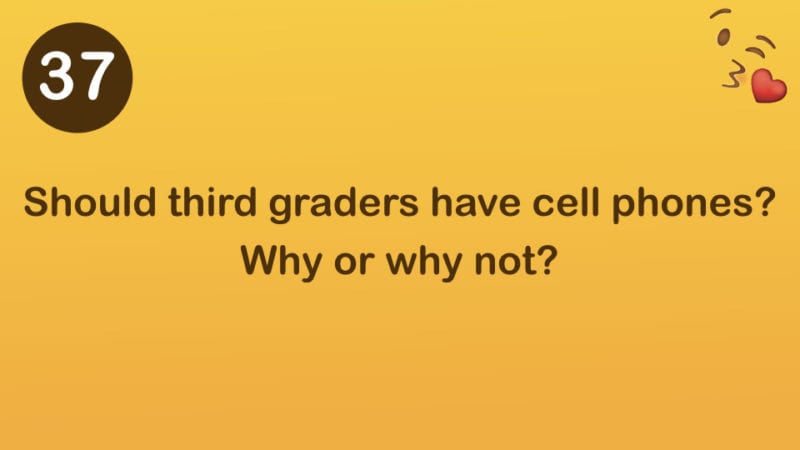
38. If you could be an Olympic athlete, what sport would you participate in?
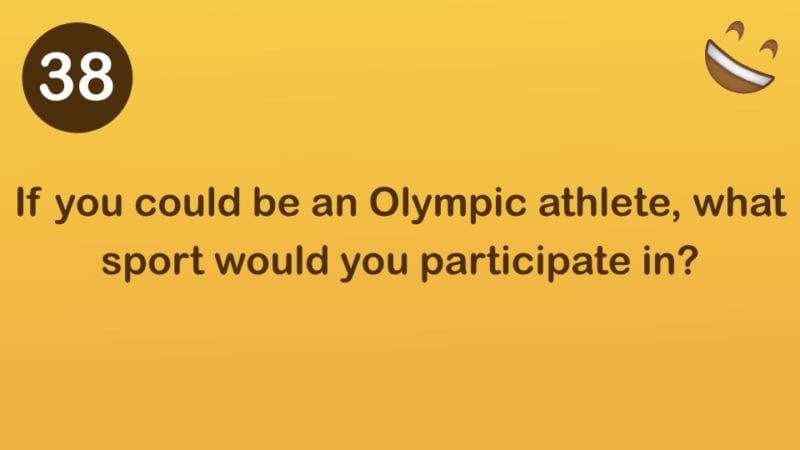
39. Write about your “getting ready for school” routine.
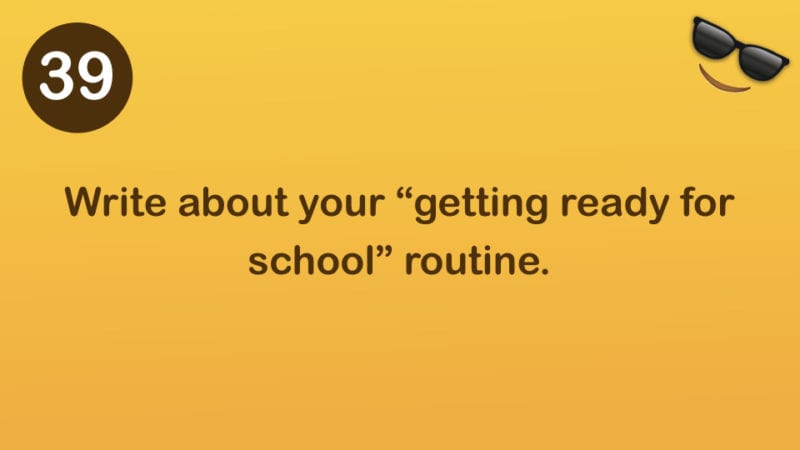
40. Write about your “getting ready for bed” routine.
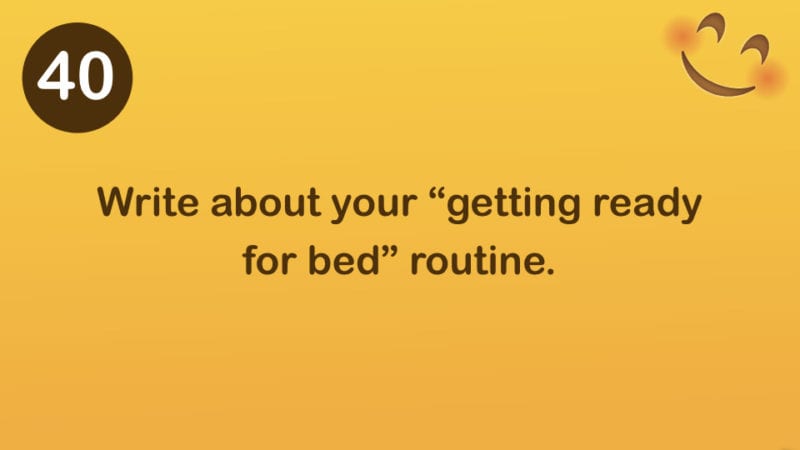
41. If you could travel through time like Jack and Annie in the Magic Tree House, where would you go?
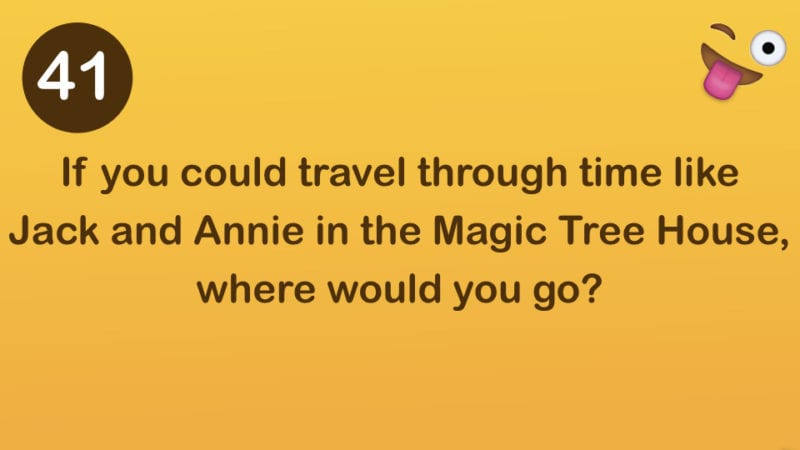
42. In your opinion, what does a perfect weekend look like?
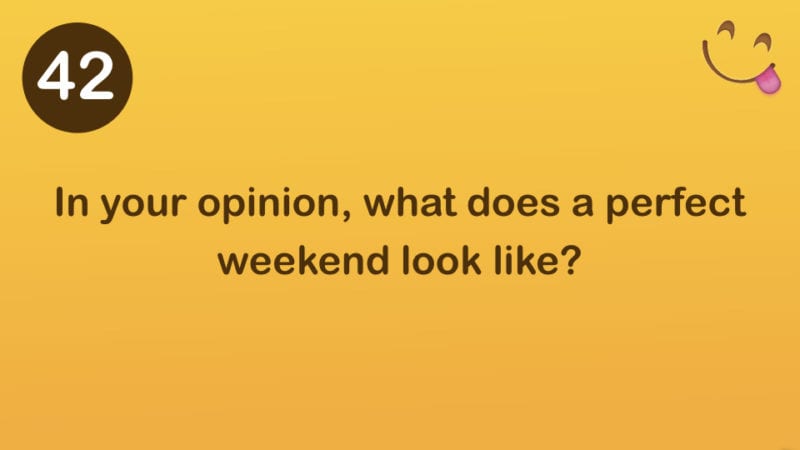
43. Write about the last time you felt really angry. What happened and how did it all work out?
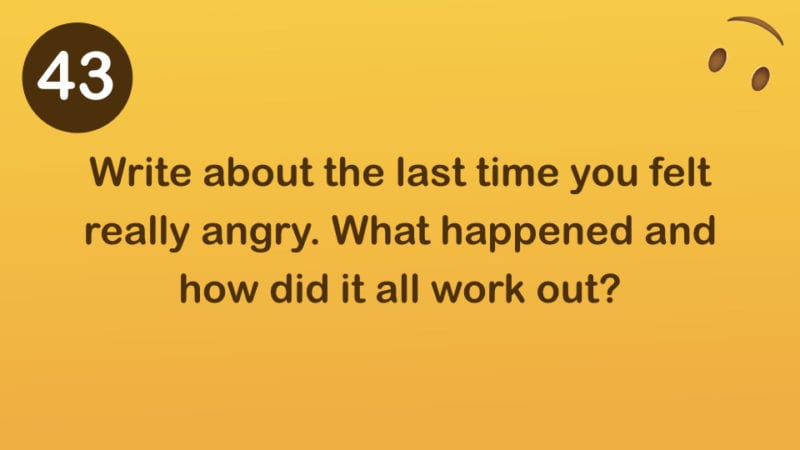
44. Pretend there was a special zoo where animals could talk. Which animal would you talk to and what are three questions you would ask?
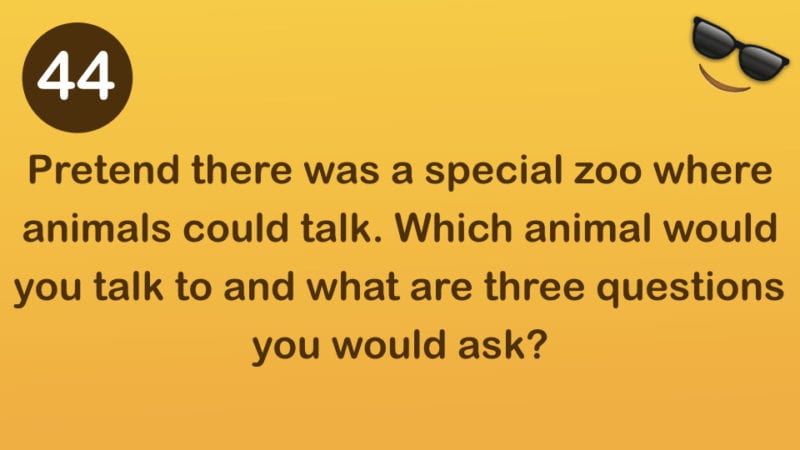
45. What is your favorite thing with wheels? Why?
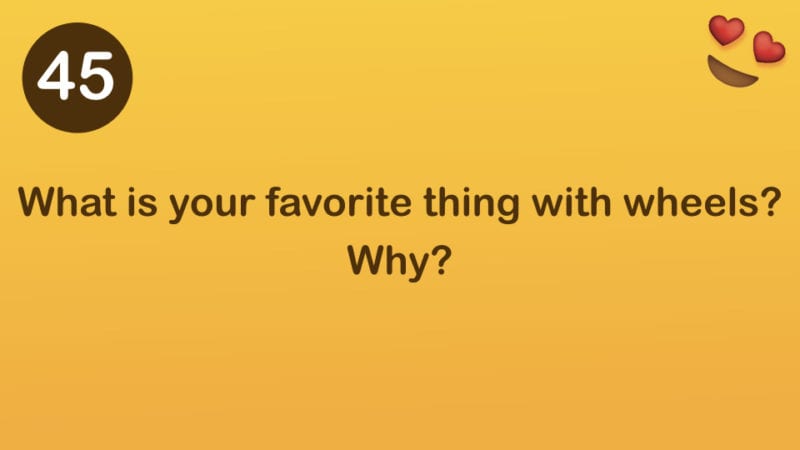
46. Tell the story of Goldilocks and the Three Bears from the point of view of Baby Bear.
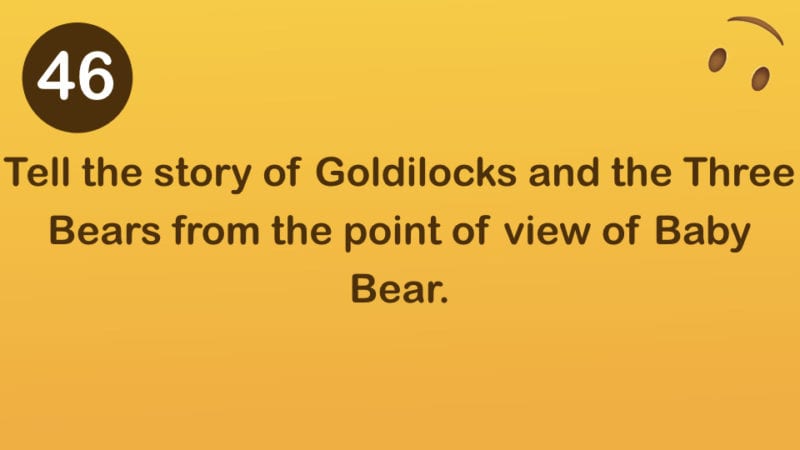
47. What do you think would grow if you planted a magic bean?
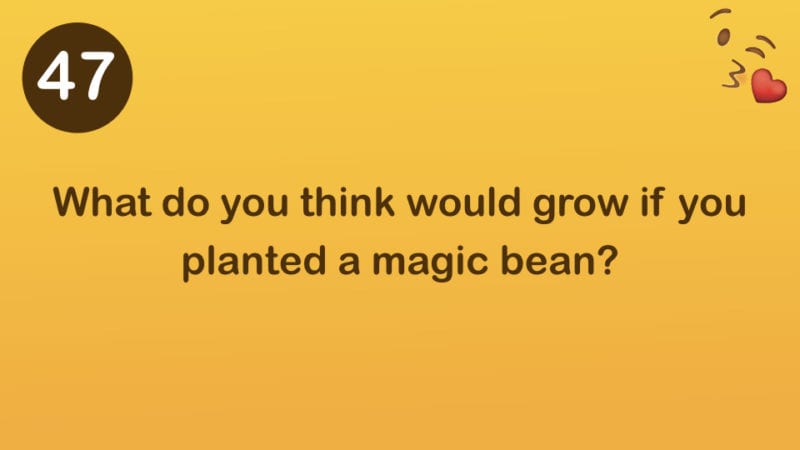
48. Which would you rather be able to do—fly or read people’s minds? Why?
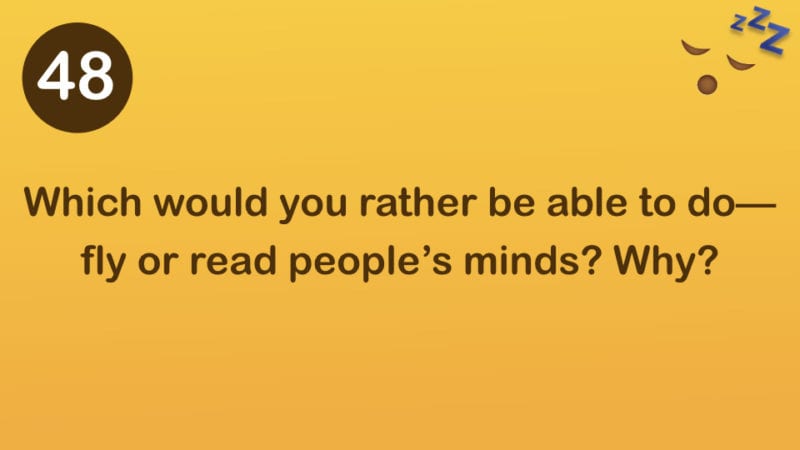
49. Tell about an adult in your life that you admire.
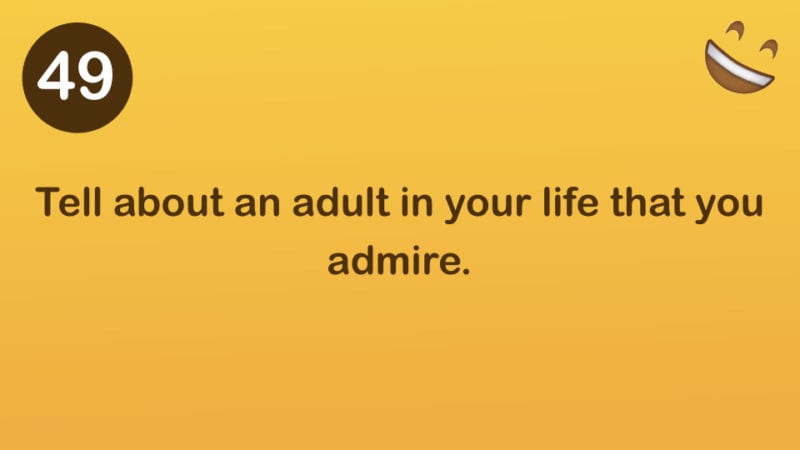
50. If you were traveling for a week and could only bring a backpack, what would you pack?
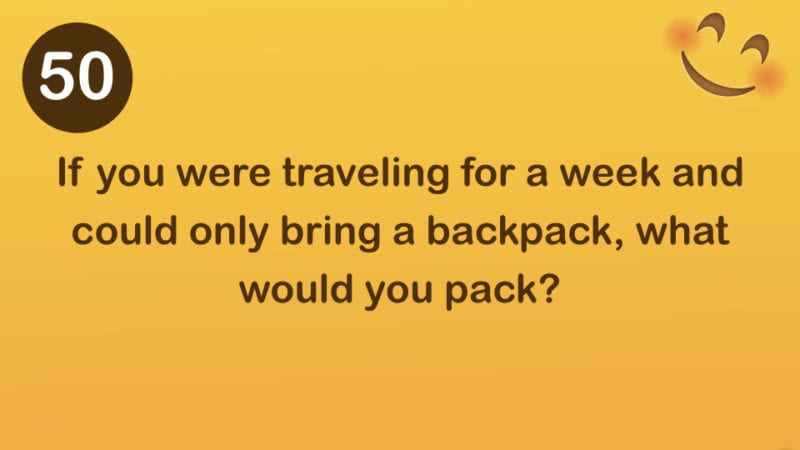
Get My Third Grade Writing Prompts
Love these third grade writing prompts? Make sure to check out our third grade jokes to start the day !
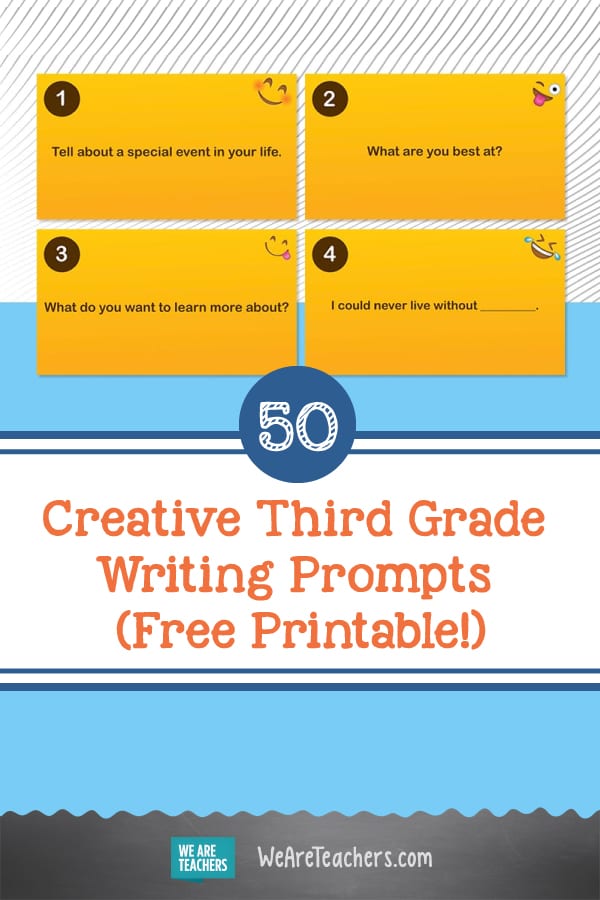
You Might Also Like
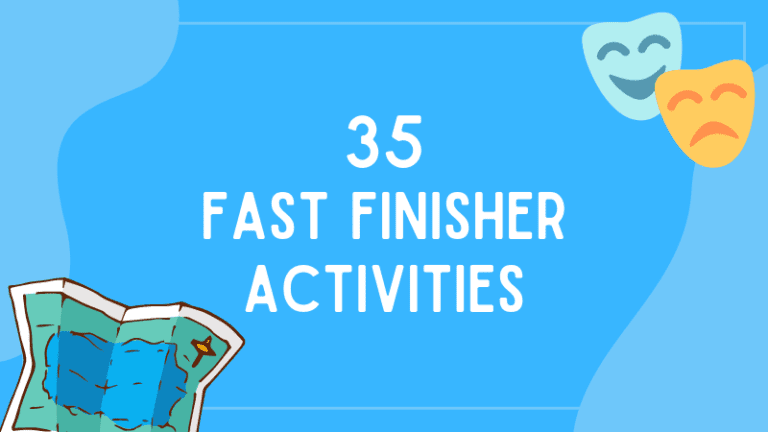
The Big List of Fast Finisher Activities
Options that pack a punch. Continue Reading
Copyright © 2023. All rights reserved. 5335 Gate Parkway, Jacksonville, FL 32256
Fun Creative Writing Topics and Prompts for Third Grade

Sometimes, creative writing assignments aren’t just confusing for the student.
What should a 3rd grader write about?
What should your expectations be? How can you help your student succeed?
Today’s post is all about helping you source creative writing topics that are perfectly suited for third grade (or upper elementary).
What Makes Creative Writing Different?
Creative writing can be tricky to explain to a student, especially if you’re working with a child who is used to thinking conventionally.
In a nutshell, it differs from academic or essay-style writing in that it highlights the writer’s imagination and creative invention.
The artistic nature of creative writing can make some students nervous. That’s why clear-cut creative writing examples are incredibly helpful.

get this picture prompt printable for free!
It’s also helpful to let them read or listen to creative short stories to provide ideas of how to begin. Seeing examples illustrates how to write creatively better than trying to explain it in words.
Another important aspect of creative writing is that it doesn’t have to be true – or even based on fact. It can be difficult for a third grader to believe it’s okay to stray from reality. Eggs and ham aren’t green, so why pretend they are?
Discuss potential story writing topics with your child so you can help him or her break down those restrictions.
Sharing examples will help them see the liberty (and fun!) that creative writing offers.
Creative Writing Tips and Techniques for Grade 3
For elementary students, good topics for creative writing are broad enough for the student to use his imagination but not so broad that he has no idea where to begin.
Instead of just handing him a topic such as “outer space,” try a narrower topic, such as “tell me a story about boy in the future who travels to the moon with his class for a science field trip.”
Here are a few more tips to help while you’re working on creative writing with your own third grader:
- Story writing ideas or topics can range from telling a made-up story about what happened at dinner last night to creating an amazing adventure or imaginary world.
- When you teach writing to 3rd graders , it’s helpful to give them several creative writing ideas to unleash their imaginations.
- Try recording your students as they tell a story. More than likely, just talking about the story they want to write will help them gather their thoughts.
- If you’re not sure how to start an introduction paragraph for a third grader , have her look at examples of her favorite books to see how the authors pique her interest immediately.
- Discuss the elements of the story beforehand to help it feel more real to your student. Ask him questions about the setting—when it’s happening and where—as well as the plot. Talk to him about the main characters, guiding him with questions that help him see through the characters’ eyes and better envision what they might do.
- If your student really can’t get started, set a timer and just have him write whatever comes to mind. There’s nothing uncorks writer’s block faster than just sitting down and writing—even if it starts out as nonsense.
- Encourage your student to use literary devices such as similes and metaphors, even if she doesn’t know those terms. Explain how a teddy bear’s fur can be “like a cloud” or that a hard worker can be a “busy bee.”
Above all, to encourage successful creative writing, encourage your students to write about topics they enjoy. Their pleasure will reflect in their stories.
12 Creative Writing Topics for Third Grade That Inspire Imaginative Stories
Speaking of enjoyable topics, here are some examples of creative writing topics paired with question prompts to get your student started:
1. Imagine you step outside, and all the grass has turned blue. What do you do?
The key to a good creative writing topic is, well, creativity! Whimsical topics inspire students to unleash their imagination and enjoy writing.
If your third grader has been reluctant to write lately, it might be time to pull out a fantastical scene like this one and “let them loose” so to speak.
Encourage your student to brainstorm a bit before writing.
These prompts can help:
- What made the grass turn blue?
- Is it a good thing? Does it cause problems?
- Can you fix it? Will the grass ever be green again?
2. What if you woke up and realized you had switched bodies with someone else in your family?
A topic like this is a great exercise for the mind. It may even help him gain a little empathy as he writes and realizes how different a parent’s day is from a child’s.
Some prompts to help him get going:
- Which family member do you think would be most interesting to trade bodies with for a day?
- Would it be exciting or scary to wake up as that person?
- Would your characters keep it a secret?
3. What if your pet could talk but only to you?
Some of the more appealing creative writing topics for kids are those where students can easily form ideas (which builds confidence).
Most children already talk to their pets, so it’s not a huge leap to imagine them talking back. Use that headstart to build a story.
4. What would you do if you found a treasure map?
Finding a treasure map can inspire many tales. The plots are endless!
A few questions to get your child started:
- Where was it found?
- Was it put there by pirates, a king, or your great grandmother?
- Is it in code?
- How do you figure out where the treasure is?
5. What if there was a sweet, lovable, non-scary monster who lived under your bed?
This creative writing topic takes the monster-under-the-bed and transforms him into a friend.
- What if every night, after Mom and Dad tuck you in, you get to spend some time with an interesting creature known only to you?
6. What if your closet door is really a door to another world?
This Narnia -style prompt inspires students to describe a secret fantasy world. Help them get into the groove by discussing the many characters they encounter.
- Are they magical creatures or copies of everyday people he knows now?
- What kind of world lies on the other side of his closet?
- What’s happening there?
- Is it similar to our world or vastly different?
7. Create an imaginary friend and take him on some adventures with you.
This type of freewriting prompt for 3rd grade students allows for more exploration. It’s a broader topic for the child who already thinks creatively and won’t be overwhelmed by its broadness.
If your student likes this topic but still needs some inspiration, here are some questions to ask:
- How old is your friend?
- Is it a boy or a girl?
- What type of creature is he – human, animal, bug, robot, or something else?
- What’s something you’d love to do with a friend if you could do anything you want to do?
8. Rewrite a fairy tale so that it takes place today in your own town.
This writing topic alleviates some uncertainty a third grader may have in getting started. Once your student chooses a fairy tale, then it’s just a matter of re-forming the characters and setting.
It’s a wonderful topic for students who need more structure than the average creative writing assignment provides.
9. Explore and describe the dusty old attic of a dilapidated mansion.
This topic is one of the more descriptive writing topics for grade 3 . It’s compelling to think about, but it doesn’t have to be too bizarre.
(Check out this post for examples of descriptive writing .)
Your student can be as creative and imaginative as he or she desires.
Your third grader can create descriptions of realistic objects found in an old attic, or he can dive deep and paint images of ancient or other-worldly artifacts.
10. Imagine your parents won a million dollars. How would your life change?
Let his imagination soar, describing the planes he plans to pilot around the world or the mansion in which he’ll entertain world leaders.
Perhaps he’ll purchase a private island and find hidden treasure or build an orphanage in a third-world country.
11. What if your dolls have their own secret lives when you’re not around?
This creative writing topic has, of course, been explored by many published authors, which just proves it’s a captivating one.
Questions to get started:
- What do your dolls do when they “wake up”?
- Do they go anywhere?
- Do they have jobs?
12. Imagine your older cousin is getting married and asks you to be a bridesmaid (or groomsman). Tell me all about the wedding and your part in it.
Creative writing prompts for grade 3 can also be about a realistic but fictional situation, like participating in a wedding.
Third grade girls, especially, may enjoy planning a fantasy wedding. She may even wish to pen her own wedding!
Have her describe the dresses, the flowers, the decorations, the ceremony, and anything else she’s interested in.
If your child chooses this topic, be sure to tuck her written work away for later—what a fun story to share at her own “real life” wedding!
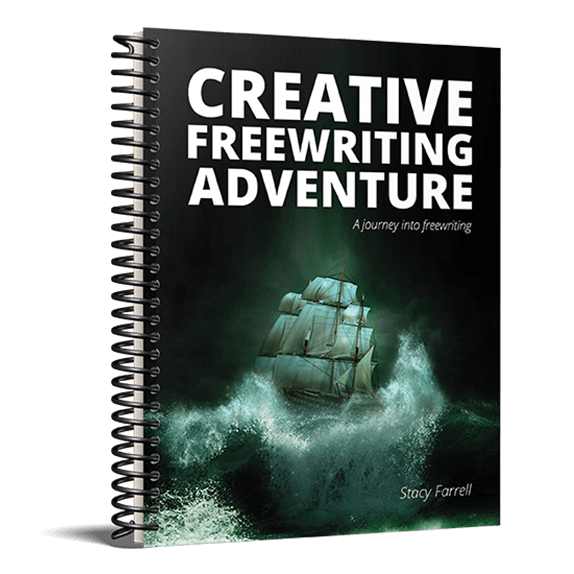
bring excitement into your student’s writing – no prep required!
About the author.
Jordan Mitchell

55 Narrative Writing Prompts For 3rd Grade
As students improve their writing skills, it is important that they explore various types of writing—including narrative writing. Narrative writing is an important step not only in learning to write but also in learning to reflect and think deeper.
Whether students are journaling or making story charts and discussing their answers in class, the following writing prompts are a great place to start with your 3rd graders.
Using These Prompts
You can use these prompts as journaling prompts for your students during your writing practice, but they also make great discussion questions.
Students might feel awkward about expressing some of their emotions, and this is a great way to help them come out of their shell and realize that we’re all more alike than we realize.
Here are a few ways you can use this guide in your classroom:
- Assign one prompt per table group. Give students time to write down their thoughts, and then have them share with the rest of their table.
- Challenge your students to use prompts that they find uncomfortable, as those are often the most important ones for them to work on.
- Ask your students to write using one prompt each day for the entire school week.
- Don’t grade these assignments; the emotional reflection and self-realization are more important than the grade.
The Prompts
- Write about the strangest thing that has ever happened to you.
- What do you think a typical day would look like if you were seven feet tall?
- Write about a time when you felt very sad. How did you make yourself feel better?
- Have you ever lost an important game? Write about what happened and how you felt.
- When you play with friends, what do you like to play?
- Do you think it’s important for kids to play pretend?
- Write about your favorite holiday memory.
- Write about a time when you felt very scared.
- Have you ever witnessed someone being bullied? What did you do?
- Why is it important to stick up for yourself?
- What are some ways that you like to relax on the weekend?
- Do you speak another language? Do you think all students should learn a foreign language in school?
- Which Disney character do you relate to most? Why?
- Which Marvel character do you relate to most? Why?
- If you could be any color, which color would you be? Why?
- Describe your perfect family vacation.
- Why is it important to help those in need?
- Have you ever had stage fright? What happened?
- What is a fun fall activity that you like doing with your family?
- Which season is your favorite? Why?
- If you could instantly learn one skill, what would it be? Why?
- Do you prefer board games or card games? Why?
- What would you do if you woke up tomorrow and could speak to animals?
- Write about a time when someone close to you hurt your feelings.
- Write about a challenge you’ve faced. What did you do to overcome it?
- What do you do for fun when you don’t have screens or technology to entertain you?
- What is your favorite food? What makes it so special?
- What is your least favorite food? Why don’t you like it?
- What do you do when your feelings are hurt? Do you think this is a good way to handle your emotions?
- Have you ever received an award? What was it for? How did it make you feel?
- Write about your favorite book. What makes it so special?
- What is one thing you would change in your classroom?
- What is the first thing you do when you wake up in the morning?
- Write about something that seemed bad at first, but turned out to be good.
- Write five ways you can help someone in need.
- What are some important skills you need to master to move on to 4th grade?
- What is the most important thing you’ve learned this year?
- Would you rather it rain glitter or snow birdseed? Why?
- Write about the last vacation you took with your family.
- Do you have a blanket or stuffed animal that is special to you? Write about where it came from and why you love it.
- Do you prefer Star Wars or Harry Potter? Why?
- Write five things you can do to calm yourself down when you feel angry.
- Write about something that makes you laugh.
- Write about a conflict between you and your best friend. How did you resolve it?
- Who do you enjoy spending your time with? What makes your time so special?
- Write about a time when you tried something new. How did you feel?
- Do you play a sport? What do you enjoy about it?
- Write five things you can do to feel better when you are sad.
- Have you ever been in an argument where you knew you were right, but the other person wouldn’t agree? What happened?
- If you were the teacher for a day, what would you do?
- What is your favorite animal? What do you think this says about your personality?
- If you were responsible for cooking breakfast for your entire family, what would you cook? Why?
- Why is it so important for siblings to get along? Do you get along with your siblings?
- Write about the best gift you’ve ever received.
- What are five things you can do to feel better when you are scared?
Looking For More?
Our site is home to writing prompts, teacher and substitute teacher resources, parent guides, and so much more. If you’re looking for something specific, let us know and we’ll do what we can to make it happen!
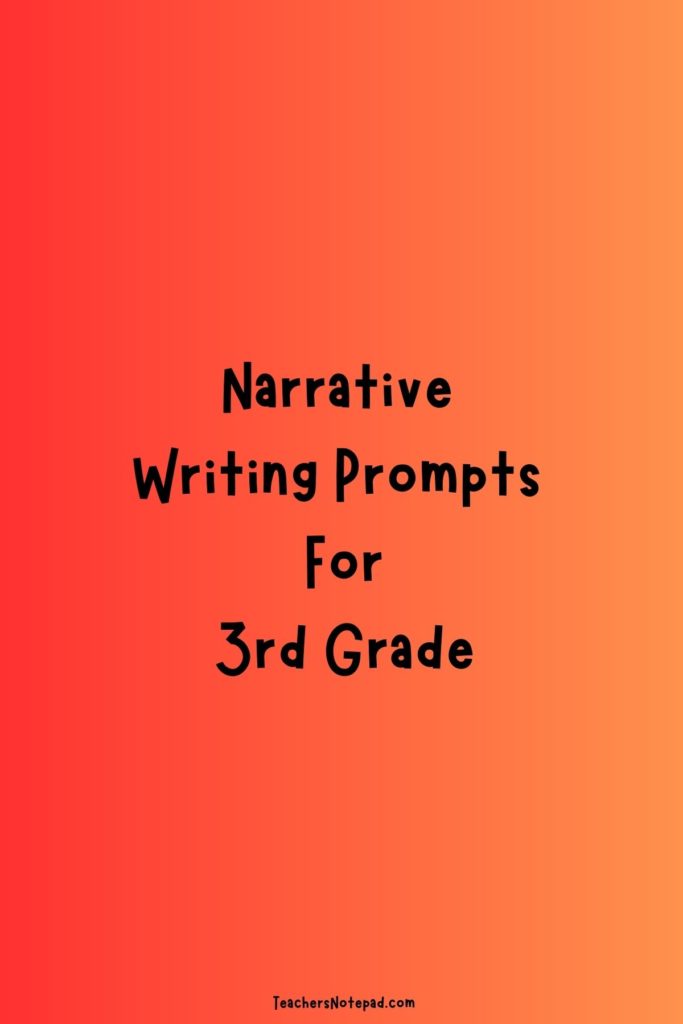
- Math for Kids
- Parenting Resources
- ELA for Kids
- Teaching Resources

How to Teach Skip Counting to Kids in 9 Easy Steps
10 Best Math Intervention Strategies for Struggling Students
How to Teach Division to Kids in 11 Easy Steps
How to Teach Place Value in 9 Easy Steps
8 Math Division Tricks: Making Division Fun & Accessible
Simple & Stress-Free After School Schedule for Kids of All Ages
When Do Kids Start Preschool: Age & Readiness Skills
Kindergarten Readiness Checklist: A Guide for Parents
How to Choose Best School For Your Kid: 12 Best Tips
Why Kids Get Bored at School: 10 Tips to Keep Them Interested
6 Effective Ways to Improve Writing Skills
40 Four Letter Words That Start With A
What Are the Stages of Spelling Development: Ultimate Guide
48 Rhyming Words for Kindergarten Kids
How to Teach Vowels to Kids: A Step-by-Step Guide
15 Best Innovative Tech Tools for Teachers
What is Teachers Professional Development: Strategies & More
11 Best Ways to Create a Positive Learning Environment for Kids
How to Encourage Creativity in the Classroom – 9 Best Tips
25 Best Websites for Teachers
100 Fun Third-Grade Writing Prompts for Kids: Journal Prompts

- Journal Writing Prompts
- Funny Writing Prompts
- Narrative Essay Writing Prompts
- Fiction Writing Prompts
- Poetry Writing Prompts
- Informative Essay Writing Prompts
- Opinion Writing Prompts
- Animal Writing Prompts
- Descriptive Writing Prompts
- Emotion Writing Prompts
The power of stories is immense. It not only unlocks the imagination but also improves creativity and vocabulary. For kids as young as third graders , writing prompts can be beneficial to kick-start their writing spree. It is a great way to build various genres of writing skills in kids- from narrative and informative to poetic and funny.
Stick to this blog to track down century options of 3rd grade writing prompts for kids .
SplashLearn: Most Comprehensive Learning Program for PreK-5

SplashLearn inspires lifelong curiosity with its game-based PreK-5 learning program loved by over 40 million children. With over 4,000 fun games and activities, it’s the perfect balance of learning and play for your little one.
Here are more educational resources to get your third grader learning!
6 Reasons To Give Your 3rd Graders a Writing Prompt?
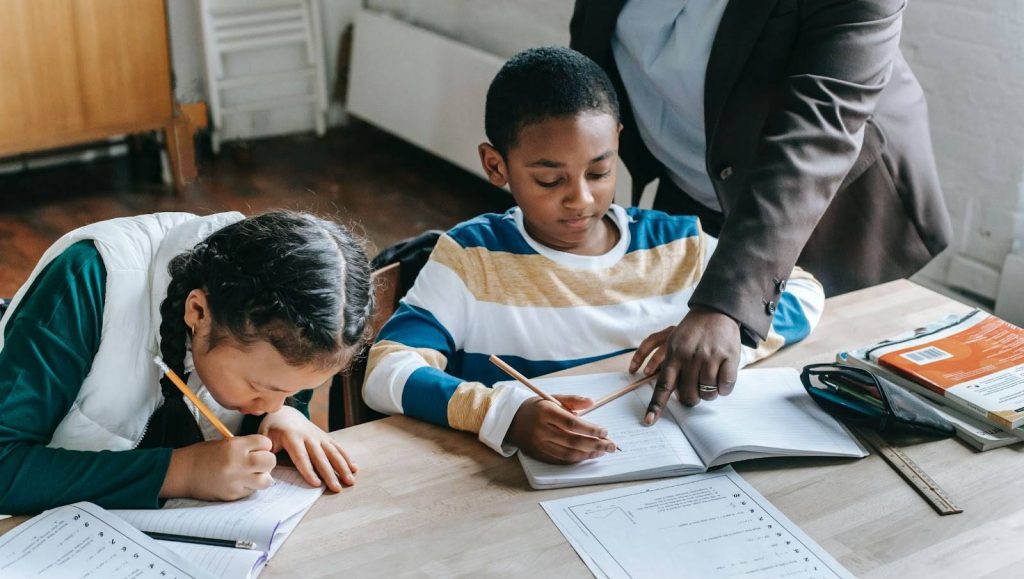
When it comes to keeping your students busy with something beneficial, writing prompts are a wonderful tool. Here are a few major ways in which 3rd grade journal prompts can help children.
- Allows children to think around creatively
- Enhances a sense of expression
- Eliminates the dread of writing
- Improves story-telling
- Boosts self-confidence in children
- Refines grammar, spelling, and handwriting with practice
While they get busy writing the best out of their imagination, you can enjoy a sip of hot coffee (a bonus, you know!).

100 Fun Third-Grade Writing Prompts for Kids
10 journal writing prompts.
The habit of journaling must be inculcated in kids from a young age. Wondering why? Well, it goes a long way in developing the ‘writer-like’ mindset in them. Moreover, journaling is known to be a stress reliever in teens and adults alike. Whether they make it a daily or alternate habit later, here are ten examples of 3rd grade journal topics that can be perfect for giving them a needed push.
1. What has been your favorite memory of 2nd grade ?
2. On a rainy day, would you rather be inside or outside? Why?
3. How did you meet your best friend?
4. What flavor of chips do you like the most and why?
5. Who is the favorite cousin in the family?
6. When was the last time you had your favorite dinner outside?
7. Do you have someone who makes you feel special? Who and How?
8. Which school period do you like the most and why?
9. What are you most thankful for in life and why?
10. What is your favorite cartoon character?
10 Funny Writing Prompts

This is every child’s favorite! Funny Writing prompts can help develop an expression of humor sense in young children. Moreover, it will allow the classroom to have a light moment together when each of them will read their chucklesome experiences aloud. We can already hear the giggles!
Check out these fun writing prompts for 3rd grade kids.
1. If your pencil boxes could talk to each other, what would they be?
2. What if you were an Easter egg?
3. Imagine if cows gave ‘Skittles’ instead of milk. What would the world be like?
4. What makes you laugh?
5. What was the best joke that your best friend cracked recently? How can you make it funnier?
6. What would happen if it did rain cats and dogs?
7. Imagine there’s a kangaroo in the classroom. How did it reach there, and what would the scenario be like?
8. Would you rather wear a swimming suit in a snowstorm or wear a snowsuit to the beach? Which kind of silly will you be and why?
9. Write a review of the animated movie for kids that you have seen recently.
10. Imagine you and your best friend switch families for a day. What would the day be like?
10 Narrative Essay Writing Prompts
Narrative essay prompts can sow seeds for a future author of an American best-seller. One of the most favored writing prompts by teachers, 3rd grade narrative writing prompts expect students to tell a story based on their imagination or actual incidents. They could either build their story on dialogues or use descriptive writing. Let’s head to the list.
1. If your shoe could speak, what story would it tell?
2. One fine morning, you woke up with wings. Narrate the day.
3. If you are allowed to make classroom rules , which new rule would you make and why?
4. Make a story about where thunder comes from.
5. Imagine a boy who only eats oranges to survive. Narrate the story of his life.
6. Describe your last vacation. Where did you go, and what did you do?
7. What is the most interesting story that your family member has told you about?
8. You are given $200 to spread kindness around your city. How will you spend it?
9. If you could fly wherever you would want to, what places would you go and why?
10. What is one thing you do very well? Describe it in detail.
10 Fiction Writing Prompts
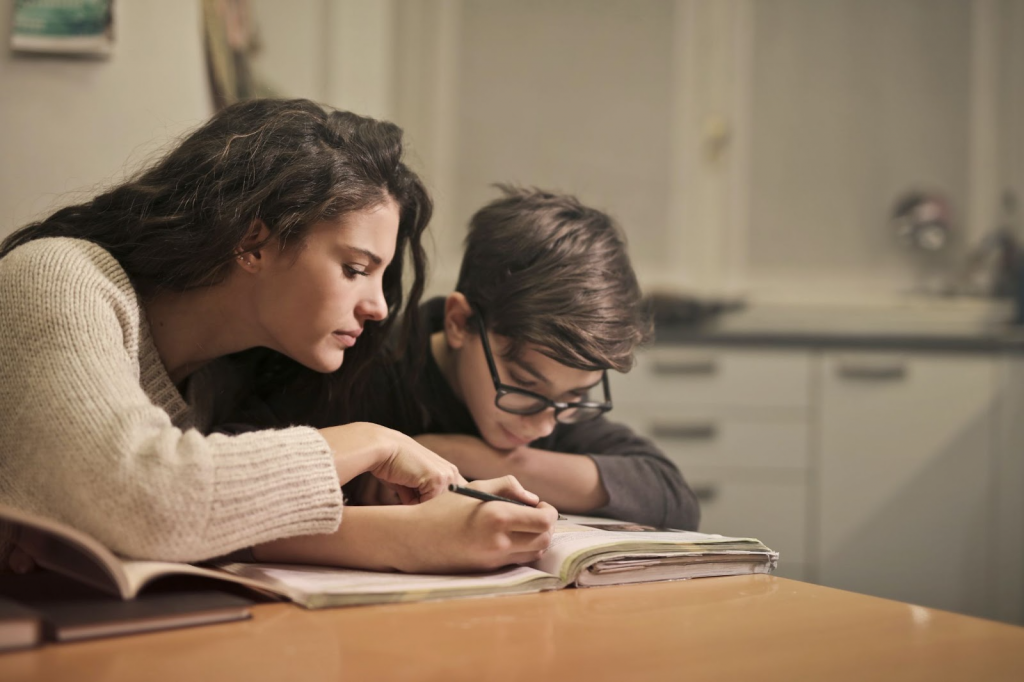
Here’s another set of 3rd grade writing prompts that will make the creative juices flow in the students. Fiction writing prompts are a great stimulus for young minds to develop their characters, work on a plot line and narrate a story.
They not only allow expand their imagination in children but gives them an opportunity to enjoy the writing process. Have a look at writing ideas for 3rd grade students:
1. What story does a camera want to tell the world?
2. A princess is trapped in a castle that is guarded by a beast. Instead of waiting for her prince charming to save her, she uses the resources and tools from inside the castle to build her escape plan. What all would she use and how? Write her escape story.
3. ‘There was a knock on the door. I opened it and saw a cat sitting there and,….’. Finish the story.
4. You had a chance to take over your father’s job for a day. Write a story narrating all your day’s events.
5. ‘On a vacation to paradise, something unexpected happens.’ Continue with the story.
6. There was a butterfly in Ohio who needed to earn the colors for herself. She could only earn five colors for herself. What would she do to earn colors, and how?
7. One day, you woke up and realize that you have a magic pen next to you. Narrate the events that followed it.
8. Imagine you get to choose how you would want to live your next 50 years. What would you choose? Who will be the people with you?
9. Your balloon just blew away! Write the story from the balloon’s perspective.
10. You ate a brownie, and now you are 20 feet tall. What do you do next?
10 Poetry Writing Prompts
With Tik Toks and Reels throwing rubbish in the name of poems for kids , now is the time to introduce young minds to the real essence of poetry. They must be taught the power of syllables, rhymes, apostrophes, punctuation, and word choice to recognize the poetry.
Poetry Writing Prompts can give good practice to 3rd graders to improve their phrasing ideas and, ultimately, the poetry sense! Whether it’s a limerick or haiku, here’s the suggestion list that you shouldn’t miss.
1. ‘Whenever I sing a silly song,
Whenever I daydream for too long..’ Continue the poem.
2. ‘Within the wrapping paper brown,
the smallest gift I’ve found. Write a poem to talk about the gift.
3. ‘Dear Friend,’. Write a short poem for your best friend.
4. Challenge yourself to write a poem that is no longer than 25 words.
5. Imagine you came from another planet, lost on Earth, and longing for home. Write short poetry to express yourself.
6. ‘Look at the stars and name them all….’ Continue an interesting poem.
7. ‘Through the trees, I go…’ Write a few lines of a Haiku poem.
8. Write a poem about your grandparents.
9. ‘It was quite a big day for me.’ Write a limerick using this line.
10. ‘I met a funny little woman,
As I walked along one day…’ Write a silly poem using this starter.
10 Informative Essay Writing Prompts
A highly beneficial writing exercise for all ages, informative writing prompts are about informing the reader without persuading or making an opinion to it. For 3rd graders, these essays could be a powerful tool to enable them to write from what they already know. It advances their memorization, learning, and reflective ability in them.
Check out the ideas that can be used as writing topics for 3rd graders.
1. Write a process to build a birdhouse in your backyard.
2. If you could meet any famous person in the world, who would it be and what conversion would you have with them?
3. Why is it important to preserve the environment around us? How can you help with it?
4. Do you have a pet? If yes, how do you take care of it?
5. Describe what all do you see on your way to school.
6. How do you prepare for a test? Share some tips with your friends.
7. Write the importance of a healthy diet in our lives. How can we make our diet healthier?
8. Describe life in the coldest cities of the world. Would you live in such places?
9. Doctors, Firefighters, Policemen, Delivery boys, etc., are all heroes. Write about their selfless contribution to our lives.
10. Why do leaves change color during autumn?
10 Opinion Writing Prompts
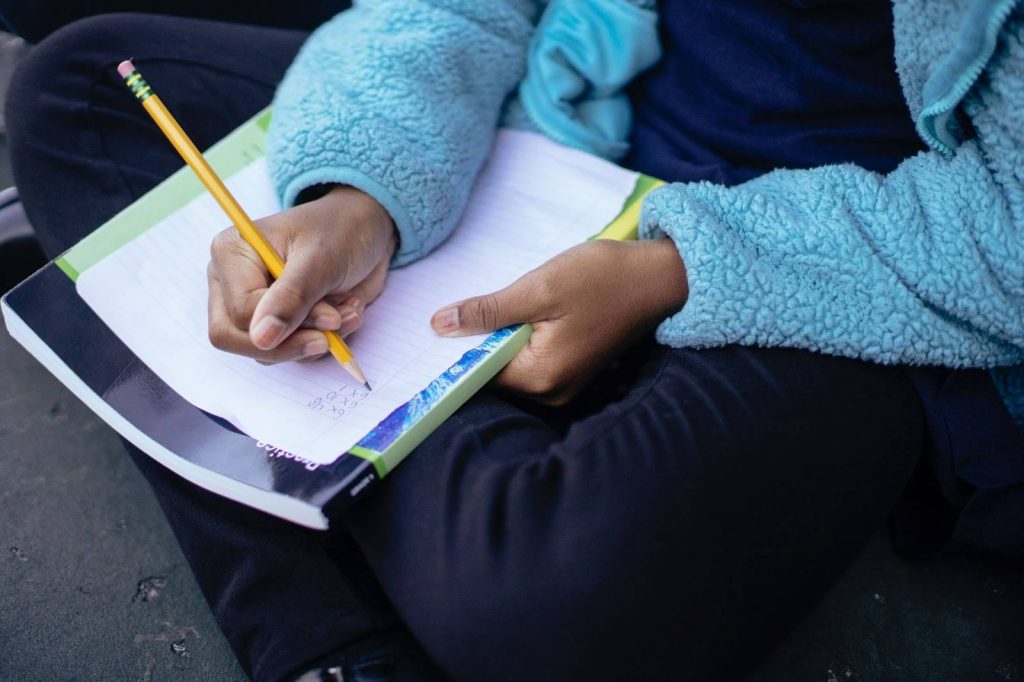
We all have opinions, and so do the little ones! Teaching young kids to form an opinion can be rewarding for their future goals and personality development.
It is important to familiarize them with understanding their mind and heart and strike a balance between the two. Opinion writing prompts for 3rd graders can be instrumental in getting them moving in that direction.
To ease the writing process, you can teach the kids about the OREO framework.
O – Opinions
E – Examples
O – Opinion (restated in a concluding note)
Let’s dive into some interesting topics for 3rd grade writing prompts.
1. Do you think teachers should give homework to students?
2. What are some important rules that must be followed in life?
3. How to become a kind human being?
4. What do you do when you are angry? Write some ways to calm yourself down.
5. How to make yourself happy when you are sad? Write from your experience.
6. What is the best restaurant in your city, and why?
7. Should 10-year-olds have their mobile phone? Why or why not?
8. Why should children not eat chocolates very frequently? How should they practice control?
9. Should everyone wear school uniforms in school? Why or why not?
10. If there could only be one season throughout the year, which one would you choose and why?
10 Animal Writing Prompts
If animals bring so much joy to us just by existing, how joyful it’d be to write about them? There are so many reasons to ask children to write about animals. It can be a wonderful way to enhance their creativity, fascination, attention to detail, and of course, writing skills.
Here’s a list of animal writing prompts for 3rd graders.
1. Which animal would you like to meet and why?
2. Would you rather have a rabbit or a penguin as a pet? Why?
3. If you had a chance to become one farm animal, which one would it be and why?
4. If I were a turtle, I would…
5. Imagine waking up in the morning and seeing your favorite animal getting ready for school. What would the scenario be like?
6. Write how the world would be if humans could talk to animals.
7. You can choose either an animal or a human as your best friend. Which one would you pick and why?
8. If you could choose a different name for ‘Cow,’ what would it be? Why?
9. What I know about chickens is that….
10. A fish took a solo trip to London. Narrate the story.
10 Descriptive Writing Prompts
What do you do when you want your students to go into the tiniest details while writing? Try Descriptive writing prompts for 3rd graders. Whether they write a story or a personal experience, ignite the spark of description with these writing prompts.
1. What is your favorite math game ? Why do you like it? Also, write the steps to play.
2. Imagine you are traveling on a ship in the ocean. What does your ship look like? And, why would you like the best about your ship? Describe your journey.
3. Describe your favorite activity in the mall.
4. Which is better, winter or summer? Support your take with reasons.
5. Share a memorable experience at the park. What made it so memorable? Would you like to relive it?
6. Describe a beautiful scene from nature.
7. Alice gets to visit Wonderland in the movie ‘Alice in Wonderland.’ Describe all that you can think about Wonderland- the location, the environment, the colors, the people, etc.
8. What is a perfect day for you? Include the weather, your clothes, your friends, what you eat, and your activities.
9. Write a description of a trip to the zoo.
10. Who is your favorite teacher, and why? Describe him/her.
10 Emotion Writing Prompts
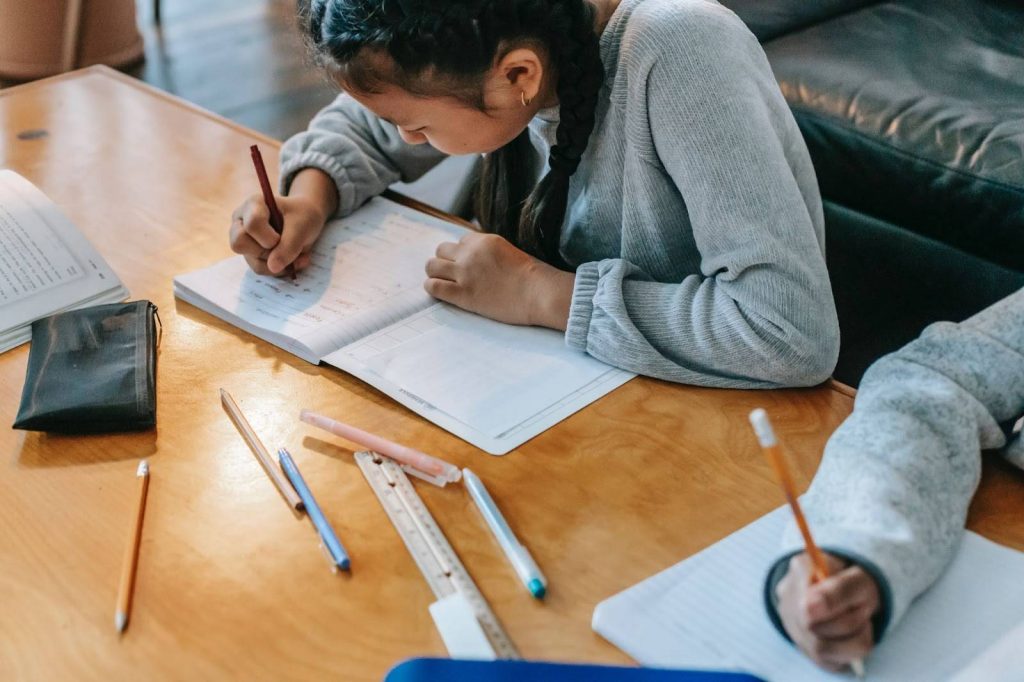
School is not limited to books and assignments. It’s also about preparing students to reflect on their feelings and being able to jot them down. Guess what? Emotion prompts can be the right choice here as well! They inspire creativity in kids and aid them in connecting with their feelings and emotions. Few third-grade emotion prompts that you shouldn’t miss.
1. My biggest dream is…
2. My favorite thing about myself…
3. What do you do when you make a mistake? How do you feel?
4. When was the last time you helped someone? What was it about?
5. Write about the happiest day of your life.
6. If you could have any special talent, what would it be and why?
7. What five things do you love about your family?
8. I feel sad when…
9. Imagine your friend is feeling scared. What would you do to calm him/her down?
10. Write a list of 10 things you are grateful for.
Now that you know 100 writing prompts for 3rd grade, there’s nothing that can stop your students shape into brilliant writers. However, a little something that we would like you to know- make writing as much fun as possible for these young minds. Look at a few tips which will help you chart out easy ways to teach writing to 3rd graders.
5 Steps To Help 3rd Graders With Writing
Step 1: sentence-formation.
If students struggle with understanding and forming sentences, they must be taught sentences as a single complete thought. Reading sentences aloud with necessary pauses will bring more clarity to them about the nature of a sentence. Let the children practice in small groups to make the instructions more effective.
Step 2: Paragraph Writing
The next step will be to familiarize the children with writing small paragraphs. Don’t go throwing the list of 3rd grade writing prompts in one go. Instead, focus on strengthening the core concepts of writing. Introduce children to the parts of a paragraph-head, body, and conclusion.
Step 3: The ‘Sandwich’ Rule
It is a great way to simplify the writing process for third-graders. Teach the children that writing a paragraph is similar to making a sandwich.
It begins with a piece of bread, i.e., the topic sentence, followed by adding some ingredients in the middle, i.e., the transition sentences, and finally, fishing it with another piece of bread, i.e., the concluding sentences.
The rule can also be practiced in small groups to enjoy the maximum benefits.
Step 4: Additional Cues
Besides creative writing prompts for 3rd graders, emphasis must be made on using words like ‘because,’ ‘since,’ ‘for example,’ ‘another,’ ‘also,’ etc., to make meaningful connections while writing. Set 30 minutes initially for most pieces. Once they have had enough practice, you can reduce the time accordingly.
Step 5: Technical Cues
In the age of digitization, you cannot fathom eliminating the aid of digital tools to help children write. Teachers must pick something fun and let the students research about them on the internet. Noting down the point will help them build a story or idea smoothly.
Get, Set, Writing!
Writing prompts are not the end but the beginning of a brilliant writing spree for your students. Nonetheless, encouragement and support from your side are imperative to build their confidence. We hope the class will enjoy these 3rd grade writing prompts as much as we enjoyed curating them.
Frequently Asked Questions (FAQs)
How should i motivate my child to write at home.
Before introducing them to prompts, the most important way you can help your child with writing is to give them a journal, a storybook, a pencil, and an eraser. Keep a separate basket for their stationary supplies so that they can instantly grab them whenever they are in the mood to write.
What can be the first set of prompts that I should begin with?
Children are most closely knit to their parents. Giving them writing prompts to recount a happy family vacation or their favorite family members can be an ideal beginning. Moreover, in the classroom, teachers can use prompts related to their best friend, learning environment, and favorite school activity.
How many writing prompts can I use in one go?
Depends on the length of the class period. However, it is recommended to use one prompt in each class to preserve the class’s interest. Otherwise, children often feel burnout and pressure from having too many topics to write on in a single class.
15 Best Listening Activities for Kids to Enhance Auditory Skills
15 Best Reading Fluency Activities for Early Learners
15 Best End of School Year Activities for Kids of All Grade

Most Popular

15 Best Report Card Comments Samples

101 Best Riddles for Kids (With Explanation)

40 Best Good Vibes Quotes to Brighten Your Day
Recent posts.

Math & ELA | PreK To Grade 5
Kids see fun., you see real learning outcomes..
Watch your kids fall in love with math & reading through our scientifically designed curriculum.
Parents, try for free Teachers, use for free

- Games for Kids
- Worksheets for Kids
- Math Worksheets
- ELA Worksheets
- Math Vocabulary
- Number Games
- Addition Games
- Subtraction Games
- Multiplication Games
- Division Games
- Addition Worksheets
- Subtraction Worksheets
- Multiplication Worksheets
- Division Worksheets
- Times Tables Worksheets
- Reading Games
- Writing Games
- Phonics Games
- Sight Words Games
- Letter Tracing Games
- Reading Worksheets
- Writing Worksheets
- Phonics Worksheets
- Sight Words Worksheets
- Letter Tracing Worksheets
- Prime Number
- Order of Operations
- Long multiplication
- Place value
- Parallelogram
- SplashLearn Success Stories
- SplashLearn Apps
- [email protected]
© Copyright - SplashLearn

Make study-time fun with 14,000+ games & activities, 450+ lesson plans, and more—free forever.
Parents, Try for Free Teachers, Use for Free
Talk to our experts
1800-120-456-456
- CBSE Class 3 English Worksheet Chapter 14 Story Writing - PDF

CBSE Class 3 English Worksheet Chapter 14 Story Writing - Download Free PDF with Solution
Story writing can be time-consuming for most of us. But there’s no need to feel too overwhelmed, as it is common to feel that way. So, story writing is very much necessary for children as it helps in bringing out and shaping their creativity and imagination, being part of the innovative and talented side of the English language. They will not find it as confusing once they’ve the concept of story writing with hints for Class 3 under their control, being an added advantage to their English writing skills as they progress to higher classes.
Now, coming to that, what is story writing? It's any piece of fictional writing, i.e., a creative or imaginative work of writing, speaking about any story that may or may not be real, with both types accepted by the world of English. In story writing for Class 3, students will learn how to write, complete, and continue stories ranging from various topics. They’ll be able to excel in writing stories by going through the many story writing topics for Grade 3 and will also learn the concept of story completion for Class 3.
Several worksheets, exercises, and tests will be provided to help students bring out the best in them, offering them chances to improve and sharpen their creativity, imagination, and communication skills.
CBSE Class 3 English Worksheet Chapter 14 Story Writing - PDF will be uploaded soon
Benefits of Learning Story Writing in Class 3 English Grammar Worksheet
The complete story worksheet has more than enough content to make sure that students score well during their study sessions, making sure that they have a serious time studying but also having fun while doing so. The questions are very creative, forcing the part of their brain that is in charge of imagination to do wonders, allowing them to complete stories using innovative means.
The question and answer content in these worksheets is of utmost importance as they help students carefully scrutinise them and can answer almost any and every type of question that comes their way. It also gives an idea for teachers and students about the type of questions they have to create and face, respectively.
The story writing topics for Grade 3 are also crafted by one of the finest professionals in the English field, promising top-quality content where the students will find the style of story completion for Class 3 comparatively easy.
Examples of Usage of Story Writing for Class 3
Here are a few story writing for Class 3 exercises’ examples:
1. Complete The Story:
Once upon a time, there lived a long frog. While he was hopping around in the forest, he came across an injured butterfly. The frog was worried and asked, “How can I help you? How did this happen?”. The butterfly replied saying…
Long ago, there was a princess locked in a tall tower. The tower was guarded by a fire-breathing dragon that kept flying around, patrolling the tower. The princess, instead of waiting for her “knight in shining armour”, decided to plan her own escape. The next day, she …
2. Write Stories on the Following Topics :
The sheep and the tiger.
The flower and the wasp.
The mermaid and the prince.
Interesting Facts About Story Writing for Class 3
Story writing is a form of art that showcases a person’s talent for writing, allowing them to dig deep into their creativity, writing about various topics and events which may or may not belong to that of reality.
Most stories are written with a purpose, written to either teach children about any lesson or morals such as kindness, obedience, perseverance, etc.
Stories that have the “moral of the story” notion are the most popular kinds of stories to instil into the young minds of the students of Class 3.
Stories can be written on various themes, such as romance, fables, fantasy, comedy, adventure, etc.
Apart from poetry, story writing is also a very imaginative form of writing which will prove that the child has a knack for writing stories.
Important Topics of Class 3 Story Writing
These are the following topics you will be learning in story writing for Class 3:
What is story writing and how to write stories?
Completing stories with the beginning provided.
Write stories on the topics given.
Write stories with hints provided.
Many other story writing exercises.
What does the PDF Consist of?
With the emergence of technology and scientific inventions by scholarly humans, our lives have been a whole lot more convenient and fruitful.
Services like communication through phones, texting, posting, mails, etc. have only worked in our favour, delivering amazing advantages.
The pdf is one such free service, which happens to allow any user to create, write, edit, and share their content throughout the world.
Similarly, complete the story worksheet pdfs can be found at Vedantu’s website, being available for free downloads, helping students access them whenever they can.
Likewise, story writing with hints for Class 3 and many other exercises have been developed by the subject matter specialists and experts at Vedantu and tremendously help students with their preparations during exams and can also be used in the future as per their convenience.

FAQs on CBSE Class 3 English Worksheet Chapter 14 Story Writing - PDF
1. Who can write stories?
Anybody can write stories. It doesn’t matter if you’re a child or a senior citizen.
2. Why is story writing important?
Story writing is important because it hones any potential skill a child might have for writing stories, triggering their creativity and imagination, allowing them to put their thoughts into words.
3. How long should a story be?
There is no limit as to how big a story should be. A story can be a short story, written in a span of a few paragraphs or can be a novel, proceeding to be as big as a thick, fat book. There are no restrictions when it comes to writing.
- Try for free
Third Grade Creative Writing Worksheets

- The Parts of a Letter
- Write Your Own Mad Libs ®
- Writing a Descriptive Paragraph (Gr. 3)
- Fill-in Story: The Halloween Party
- Fill-in Halloween Story: A Scary Night
- Fill-in Story: Halloween Carnival
- Writing a Personal Narrative (Gr. 3)
- My Friend Writing Printable
- Student Proofreading Checklist
- Creative Writing with Photo Inspiration
- Same Name Word Puzzle
- Life in the Sea
- Bio Poem Handout
- Writing a Research Report (Gr. 3)
- Favorite Foods
- Script Writing Handout
- Make Your Own Holiday
- A Note About Witches: Fill-in-the-Blanks
- Antonyms and Synonyms
- Immigration Picture Prompts
- Post Card Template
- My New Year's Resolutions (3-6)
- Discovering Pronouns 10
- Discovering Punctuation 2
- Discovering Capitalization 4
- Discovering Punctuation 9
- If I Were the Teacher
- Writing Activity: Describe the Rain Scene
- Change the Dialog in a Comic Strip
- Discovering Conjunctions
- More Creative Writing Printables, 3rd Grade
Featured 3th Grade Resources
Related Resources

About the author

TeacherVision Editorial Staff
The TeacherVision editorial team is comprised of teachers, experts, and content professionals dedicated to bringing you the most accurate and relevant information in the teaching space.

Top 100 Short Story Ideas
by Joe Bunting | 128 comments
Do you want to write but just need a great story idea? Or perhaps you have too many ideas and can’t choose the best one? Well, good news. We’ve got you covered.
Below are one hundred short story ideas for all your favorite genres. You can use them as a book idea, as writing prompts for writing contests , for stories to publish in literary magazines , or just for fun!
Use these 100 story ideas to get your creative writing started now.
Editor’s note: This is a recurring guide, regularly updated with ideas and information.

If you're in a hurry, here's my 10 best story ideas in brief, or scroll down for the full version.
Top 10 Story Ideas
- Tell the story of a scar.
- A group of children discover a dead body.
- A young prodigy becomes orphaned.
- A middle-aged woman discovers a ghost.
- A woman who is deeply in love is crushed when her fiancé breaks up with her.
- A talented young man's deepest fear is holding his life back.
- A poor young boy or girl comes into an unexpected fortune.
- A shy, young woman unexpectedly bumps into her soulmate.
- A long journey is interrupted by a disaster.
- A young couple run into the path of a psychopath.
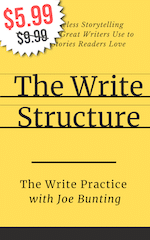
Why Creative Writing Prompts Are Helpful
Below, you'll find our best creative writing prompts and plot ideas for every genre, but first, why do we use prompts? Is it just a waste of time, or can they actually help you? Here are three reasons we love writing prompts at The Write Practice:
1. Practice the Language!
Even for those of us who are native English speakers, we're all on a language journey to go from beginners to skilled writers. To make progress on this language journey, you have to practice, and at The Write Practice, believe it or not, we're really into practice! Creative writing prompts are easy, fun ways to practice.
Use the prompts below to practice your storytelling and use of language. The more you practice, the better of a writer you'll become.
2. When you have no ideas and are stuck.
Sometimes, you want to write, but you can't think up any ideas. You could either just sit there, staring at a blank page, or you could find a few ideas to help you get started. Even better if the list of ideas is curated from our best plot ideas over the last decade that we've been publishing lessons, writing exercises, and prompts.
Use the story ideas below to get your writing started. Then when your creativity is warmed up, you'll start to come up with your own ideas!
3. To develop your own ideas.
Maybe you do have an idea already, but you're not sure it's good. Or maybe you feel like it's just missing some small piece to make it better. By reading other ideas, and incorporating your favorites into your story, you can fill your plot holes and generate creative ideas of your own.
Use the story ideas below to develop your own ideas.
4. They're fun!
Thousands of writers use the prompts below every month, some at home, some in classrooms, and even a few pros at their writing “office.” Why? Because writing prompts can be fun. They get your creativity started, help you come up with new ideas of your own, and often take your writing in new, unexpected directions.
Use the plot ideas to have more fun with writing!
How to Write a Story
One last thing before we get to the 100 story ideas, let’s talk about how to write a great short story . (Already know how to write a great story? No problem. Just skip down to the ideas below.)
- First, read stories. If you’ve never read a story, you’re going to have a hard time writing one. Where do you find great stories? There are a lot of places, but check out our list of 46 Literary Magazines we’ve curated over here .
- Write your story in a single sitting. Write the first draft of your story in as short a time as possible, and if you’re writing a short story , try to write it in one sitting. Trust me, this works. Everyone hates being interrupted when they’re telling compelling stories. Use that to your advantage and don’t stop writing until you’ve finished telling yours.
- Read your draft. Read your story through once, without changing anything. This will give you a sense of what work it needs going forward.
- Write a premise. After reading your first draft, get your head around the main idea behind your story by summarizing your story in a one sentence premise. Your premise should contain four things: a character, a goal, a situation, and a special sauce. Not sure what that means or how to actually do that? Here’s a full premise writing guide .
- Write, edit, write, and edit. Good writing is rewriting. Use your second draft to fill in the plot holes and cut out the extraneous scenes and characters you discovered when you read the first draft in step #2. Then, polish up your final draft on the next round of edits.
- Submit! Real writers don’t keep their writing all to themselves. They share it. Submit your story to a literary magazine , an anthology series , enter it into a writing contest , or even share it with a small group of friends. And if it gets rejected, don’t feel bad. You’ll be in good company.
Want to know more? Learn more about how to write a great short story here .
Our 100 Best Short Story Ideas, Plot Ideas, and Creative Writing Prompts
Ready to get writing? Here are our 100 best short story ideas to kickstart your writing. Enjoy!
10 Best General Short Story Ideas
Our first batch of plot ideas are for any kind of story, whether a spy thriller or a memoir of your personal life story. Here are the best story ideas:
- Tell the story of a scar, whether a physical scar or emotional one. To be a writer, said Stephen King, “The only requirement is the ability to remember every scar .”
- A group of children discover a dead body. Good writers don’t turn away from death, which is, after all, the universal human experience. Instead, they look it directly into its dark face and describe what they see on the page.
- A young prodigy becomes orphaned. Orphans are uniquely vulnerable, and as such, they have the most potential for growth.
- A middle-aged woman discovers a ghost. What do Edgar Allen Poe, Ron Weasley, King Saul from the Bible, Odysseus, and Ebenezer Scrooge have in common? They all encountered ghosts!
- A woman who is deeply in love is crushed when her fiancé breaks up with her. “In life every ending is just a new beginning,” says Dakota Fanning’s character in Uptown Girls.
- A talented young man’s deepest fear is holding his life back. Your character’s biggest fear is your story’s secret weapon. Don’t run from it, write about it.
- A poor young boy or girl comes into an unexpected fortune. Not all fortunes are good. Sometimes discovering a fortune will destroy your life.
- A shy, young woman unexpectedly bumps into her soulmate (literally bumps into him). In film, this is called the “meet cute,” when the hero bumps into the heroine in the coffee shop or the department store or the hallway, knocking her books to the floor, and forcing them into conversation.
- A long journey is interrupted by a disaster. Who hasn’t been longing to get to a destination only to be delayed by something unexpected? This is the plot of Gravity , The Odyssey , and even Lord of the Rings .
- A young couple run into the path of a psychopath. Monsters, whether people who do monstrous things or scaly beasts or a monster of a natural disaster, reveal what’s really inside a person. Let your character fall into the path of a monster and see how they handle themselves.
Now that you have an idea, learn exactly what to do with it. Check out my new book The Write Structure which helps writers take their ideas and write books readers love. Click to check out The Write Structure here.
More Short Story Ideas Based on Genre
Need more ideas? Here are ideas based on whichever literary genre you write. Use them as character inspiration, to start your own story, or borrow pieces to generate your own ideas. The only rule is, have fun writing!
By the way, for more story writing tips for each these plot types, check out our full guide to the 10 types of stories here .
10 Thriller Story Ideas
A thriller is any story that “thrills” the reader—i.e., gets adrenaline pumping, the heart racing, and the emotions piqued.
Thrillers come in all shapes and forms, dipping freely into other genres. In other words, expect the unexpected!
Here are a few of my favorite thriller story ideas :
Rosa Rivera-Ortiz is an up-and-coming lawyer in a San Diego firm. Held back by her ethnicity and her gender, she works twice as hard as her colleagues, and she’s as surprised as anyone when she’s requested specifically for a high-profile case. Bron Welty, an A-list actor and action star, has been arrested for the murder of his live-in housekeeper. The cop heading the case is older, ex-military, a veteran of more than one war, and an occasional sufferer of PTSD. Rosa’s hired to defend the movie star; and it seems like an easy win until she uncovers some secrets that not only make her believe her client is guilty, but may be one of the worst serial killers in the past two decades… and he knows she found out .
It’s the Cold War. Sergei, a double-agent for the CIA working in Berlin, is about to retire when he’s given one final mission: he’s been asked to “defect” to the USSR to help find and assassinate a suspected double-agent for the Kremlin. Sergei is highly trusted, and he’s given to understand that this mission is need-to-know only between him and very few superior officers. But as he falls deeper into the folds of the Iron Curtain, he begins to suspect that his superior officer might just be the mole, and the mark Sergei’s been sent to kill is on the cusp of exposing the leak.
It is 1800. A lighthouse on a barren cliff in Canada. Two lighthouse keepers, German immigrants, are alone for the winter and effectively cut off from the rest of the world until the ice thaws. Both Wilhelm and Matthias are settled in for the long haul with warm clothes, canned goods, and matches a-plenty. Then Wilhelm starts hearing voices. His personal belongings disappear from where he’d placed them, only to reappear in strange spots—like the catwalk, or dangling beneath the spiral stair knotted in brown twine. Matthias begs innocence. Little by little, Wilhelm grows convinced that Matthias is trying to convince him (Wilhelm) to kill himself. Is the insanity real, or is this really Matthias’ doing? And if it is real, what will he do to defend himself? There are so many months until the thaw.

20 Mystery Story Ideas
Enjoy a good whodunit? Then you’ll love these mystery story ideas .
Here are a few of my favorites:
Ever hear the phrase, “It is not who fired the shot but who paid for the bullet?” This is a philosophy Tomoe Gozen lives by. Brave and clever, Tomoe follows clues until she learns who ordered the murder: Emperor Antoku himself. But why would the emperor of Japan want to kill a lowly soldier?
Mystery writer Dan Rodriguez takes the subway every day. Every day, nothing happens. He wears earbuds and a hoodie; he’s ignored, and he ignores. Then one evening, on his way home from a stressful meeting with his publisher, Dan is startled out of his funk when a frantic Middle-Eastern man knocks him over at a dead run, then races up the stairs—pursued by several other thugs. The Middle-Eastern man is shot; and Dan discovers a mysterious package in the front pocket of his hoodie. What’s inside, and what does he need to do to survive the answer?
A headless corpse is found in a freshly-dug grave in Arkansas. The local police chief, Arley Socket, has never had to deal with more than missing gas cans and treed cats. His exploration of this weird murder digs up a mystery older than the 100-year-old town of Jericho that harkens all the way back to a European blood-feud.

20 Romance Story Ideas
Ready to write a love story? Or perhaps you want to create a subplot with a secondary character? We've got ideas for you!
Hint: When it comes to romance, a sense of humor is always a good idea. Have fun! Here are a few of my favorite love story ideas :
She’s a cop. He’s the owner of a jewelry store. A sudden rash of break-ins brings her to his store over and over and over again, until it becomes obvious that he might be tripping the alarm on purpose—just to see her. That’s illegal—but she’s kind of falling for him, too. Write the moment she realizes she has to do something about this crazy illicit courtship.
Colorado Animal Rescue has never been more challenging than after that zoo caught on fire. Sally Cougar (no jokes on the name, or she’ll kill you) tracks down three missing tiger cubs, only to find they’ve been adopted by millionaire Bryce Champion. Thanks to an antiquated law on the books, he legally has the right to keep them. It’s going to take everything Sally has to get those tiger cubs back.
He’s a museum curator with a fetish for perfection. No one’s ever gotten close to him; how could they? They’re never as perfect as the portraits, the sculptures, the art that never changes. Then one day, an intern is hired on—a young, messy, disorganized intern, whose hair and desk are in a constant state of disarray. The curator is going half-mad with this walking embodiment of chaos; so why can’t the he stand the thought of the intern leaving at the end of their assistantship?

20 Sci-Fi Story Ideas
From the minimum-wage-earning, ancient-artifact-hunting time traveller to the space-exploring, sentient dinosaurs, these sci-fi writing prompts will get you set loose your inner nerd.
Here are a few of my favorite sci-fi ideas :
In a future society, neural implants translate music into physical pleasure, and earphones (“jacking in”) are now the drug of choice. Write either from the perspective of a music addict, OR the Sonforce agent (sonance + enforcer) who has the job of cracking down.
It’s the year 5000. Our planet was wrecked in the great Crisis of 3500, and remaining human civilization survives only in a half dozen giant domed cities. There are two unbreakable rules: strict adherence to Life Quality (recycling doesn’t even begin to cover these laws), and a complete ban on reproduction (only the “worthy” are permitted to create new humans). Write from the perspective of a young woman who just discovered she’s been chosen to reproduce—but she has no interest in being a mother.
So yeah, ancient Egypt really was “all that” after all, and the pyramids turn out to be fully functional spaceships (the limestone was to preserve the electronics hidden inside). Write from the perspective of the tourist exploring the ancient society who accidentally turns one on.

20 Fantasy Story Ideas
Need a dose of sword-in-the-stone, hero and/or heroine packed coming-of-age glory? We love fantasy stories!
Here are a few of my favorite fantasy story ideas:
Bored teenaged wizards throwing a graduation celebration.
Uncomfortable wedding preparation between a magic wielding family tree and those more on the Muggle side of things.
A fairy prince who decides to abandon his responsibilities to become a street musician.
Just try to not have fun writing (or even just reading!) these fantasy writing prompts.

The Secret to Choosing the Best Story Idea
Stories, more than any other artistic expression, have the power to make people care. Stories have the ability to change people’s lives.
But to write a great story, a life-changing story, don’t just write about what your characters did, said, and saw. Ask yourself, “Where do I fit in to this story? What is my personal connection to this story?”
Robert Frost said this:
If you can connect your personal story to the story you’re writing, you will not only be more motivated to finish your story, you might just be able to change the lives of your readers.
Next Step: Write Your Best Story
No matter how good your idea, writing a story or a book can be a long difficult process. How do you create an outline, come up with a great plot, and then actually finish it?
My new book The Write Structure will help. You'll learn how to take your idea and structure a strong plot around it. Then you'll be guided through the exact process I've used to write dozens of short stories and over fifteen books.
You can learn more about The Write Structure and get your copy here.
Get The Write Structure here »
Have a great short story idea? We'd love to hear it. Share it in the comments !
Choose one of these ideas and write a short story in one sitting (aim for 1,000 words or less!). When you're finished, share your story in the practice box below (or our latest writing contest ) for feedback from the community. And if you share, please be sure to comment on a few stories by other writers.
Joe Bunting
Joe Bunting is an author and the leader of The Write Practice community. He is also the author of the new book Crowdsourcing Paris , a real life adventure story set in France. It was a #1 New Release on Amazon. Follow him on Instagram (@jhbunting).
Want best-seller coaching? Book Joe here.

Join over 450,000 readers who are saying YES to practice. You’ll also get a free copy of our eBook 14 Prompts :
Popular Resources
Book Writing Tips & Guides Creativity & Inspiration Tips Writing Prompts Grammar & Vocab Resources Best Book Writing Software ProWritingAid Review Writing Teacher Resources Publisher Rocket Review Scrivener Review Gifts for Writers
Books By Our Writers

Now, Take Your Idea and Write a Book!
Enter your email to get a free 3-step worksheet and start writing your book in just a few minutes.
You've got it! Just us where to send your guide.
Enter your email to get our free 10-step guide to becoming a writer.
You've got it! Just us where to send your book.
Enter your first name and email to get our free book, 14 Prompts.
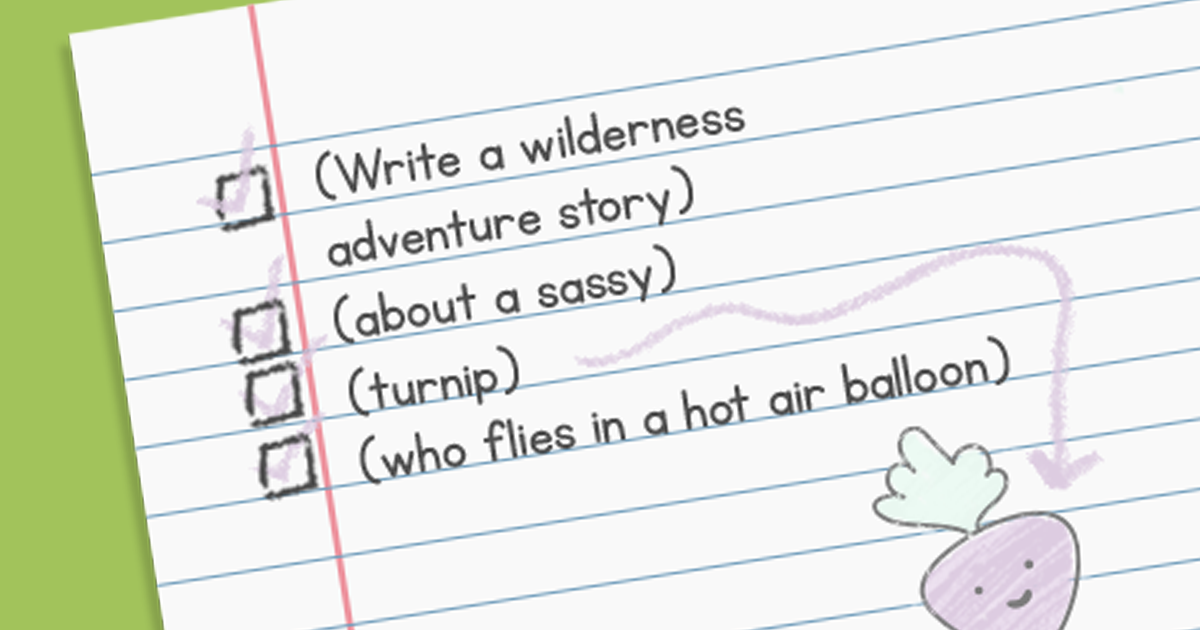
If you’re looking to inspire your students’ writing and creativity, turn to these fun and exciting writing prompts. Perfect for overcoming writer’s block or even starting a brand-new short story in a different narrative, creative writing prompts can help students begin a new piece with confidence.
Plus, these story starters can also encourage students to explore different genres while honing their writing skills. There are a lot of ways you can use writing prompts in your classroom. Try:
Reading a book in a genre, then having students use a story starter in that same genre.
Starting off class with 10 minutes of writing, using one of the prompts below. If you'd like, you can ask a volunteer to share their story! Students may be surprised by the variety of stories that are written based on the same prompt.
Using these prompts as an introduction to a creative writing unit.
Providing fast finishers with a way to stay busy — and have fun.
Using story starters to encourage students to write at home.
Adventure Story Starters
Take inspiration from classics like Treasure Island and newer popular series like The Bad Guys to explore how to write thrilling adventure stories. And to encourage students to begin writing their own adventure-focused stories, share these creative story starters:
You’re part of a pirate crew in search of a long-lost storied treasure trove. What is happening on the ship and where do you find the treasure?
You get the chance to use a time machine to meet one historical figure of your choice. Who do you go meet, and what will you do to explore that time period?
You receive a fortune in a fortune cookie that changes the course of your life. What does the fortune say, and what happens when it comes true?
Get students excited about adventure stories with these great books:
Fantasy Story Starters
Have fans of dragons, unicorns, wizards, and other mythical creatures in class? Encourage them to give fantasy writing a shot.
You’re on a quest through a hidden underground world that no one else has ever seen. What magical creatures do you come across? What do they look like, and how do they act?
There is a witch who lives in a nearby legendary haunted house. She puts a hex on you that needed to be broken by the time the clock struck midnight the next night. What kind of hex is it, and how do you break it?
You stumble into an enchanted forest. How did you find it, and what do you discover in it?
Check out these fun fantasy titles for more inspiration:
Sci-Fi Story Starters
Kids interested in STEM concepts will love science fiction! Try these prompts to see how your students combine science with their wildest imaginations.
- You’re the first person to ever set foot on Mars. What is it like? What do you explore first?
- You and your friend have the same dream in the middle of the night about a prophecy that involves another dimension. What is the prophecy, and what is this other dimension? What do you and your friend have to do to reach and alter this dimension?
- After NASA discovers a whole new world of giants in a nearby nebula, they send a team of scientists through a wormhole to study them. You are one of the scientists on board. What does the journey feel like? What do the giants look like in this world?
Plus, find great kid-friendly sci-fi here:
Genre Scrambler Story Starters
Have some fun with genre studies by combining them! Try these prompts to get started:
- You are on an expedition in the Arctic and discover a new species of animals living in the harsh climate that no one has ever seen before. What kind of species is it, and what characteristics do they have?
- You’re walking home from school and notice that the front door of a neighbor’s house is wide open, and no one is in sight. The old man who normally lives there is nowhere to be found. Curious, you go into the house and find that everything is fake: the furniture, the food, the technology, etc. In fact, the whole property is made of plastic, even the grass and trees! What happened to the old man who lives here? Why does this house exist, and why is everything fake?
- You are a child living in the early 1800s in an unnamed country when an asteroid hits, releasing aliens that want to make contact with your leaders. What do these aliens want? How does everyone react?
Shop popular books of all genres that will inspire young writers below! You can find all books and activities at The Teacher Store .
Grade 3 Writing
Discover grade 3 writing standards.

By third grade, your child should be accustomed to the learning pace at elementary school level, and will now be expected to spend longer periods of time writing independently. Young writers should rely on language arts skills they built in Grade 1 and Grade 2 as the foundation they need in order to tackle more challenging writing activities .
Third grade writing requires children to demonstrate:
- Effective communication of ideas through written texts
- Structured writing pieces, including a short introduction , main body and conclusion
- Paragraph-writing skills
- Using correct spelling and grammar in their writing (such as tenses and capitalization )
- Longer and more complex sentence forms
- Research and identify facts using reading comprehension skills
- Factual knowledge in informative reports
- Successfully writing about past experiences
- Writing improvement through revision
- Writing based on a given prompt
- Using technology to compose different writing pieces
- Applying literary devices for the purpose of developing details
- Writing for different audiences and purposes
Your child can keep these aims in mind when thinking about the writing process for the following text styles:
Informative Writing
Opinion writing, narrative writing.
Informative writing in Grade 3 calls for a focus on a specific topic and putting together factual details with the aim to inform the reader.
Here are our top tips for creating a high-quality informative writing piece at third grade level:
- Introduce the topic
- Group all related information clearly, to form the text
- Include facts, definitions, details and, if necessary, analogies to support the text
- UIse illustrations or diagrams (when or if necessary) to further the reader’s understanding
- Use linking words to connect points of information
- Include a concluding sentence, stating findings clearly
Some informative writing text styles in Grade 3 are:
- Explanations
Practice Tip
Your third grader can work on their informative writing skills with Night Zookeeper’s Explanation Writing Activity Pack . This pack introduces examples of linking words and phrases that can help connect ideas in informational writing!
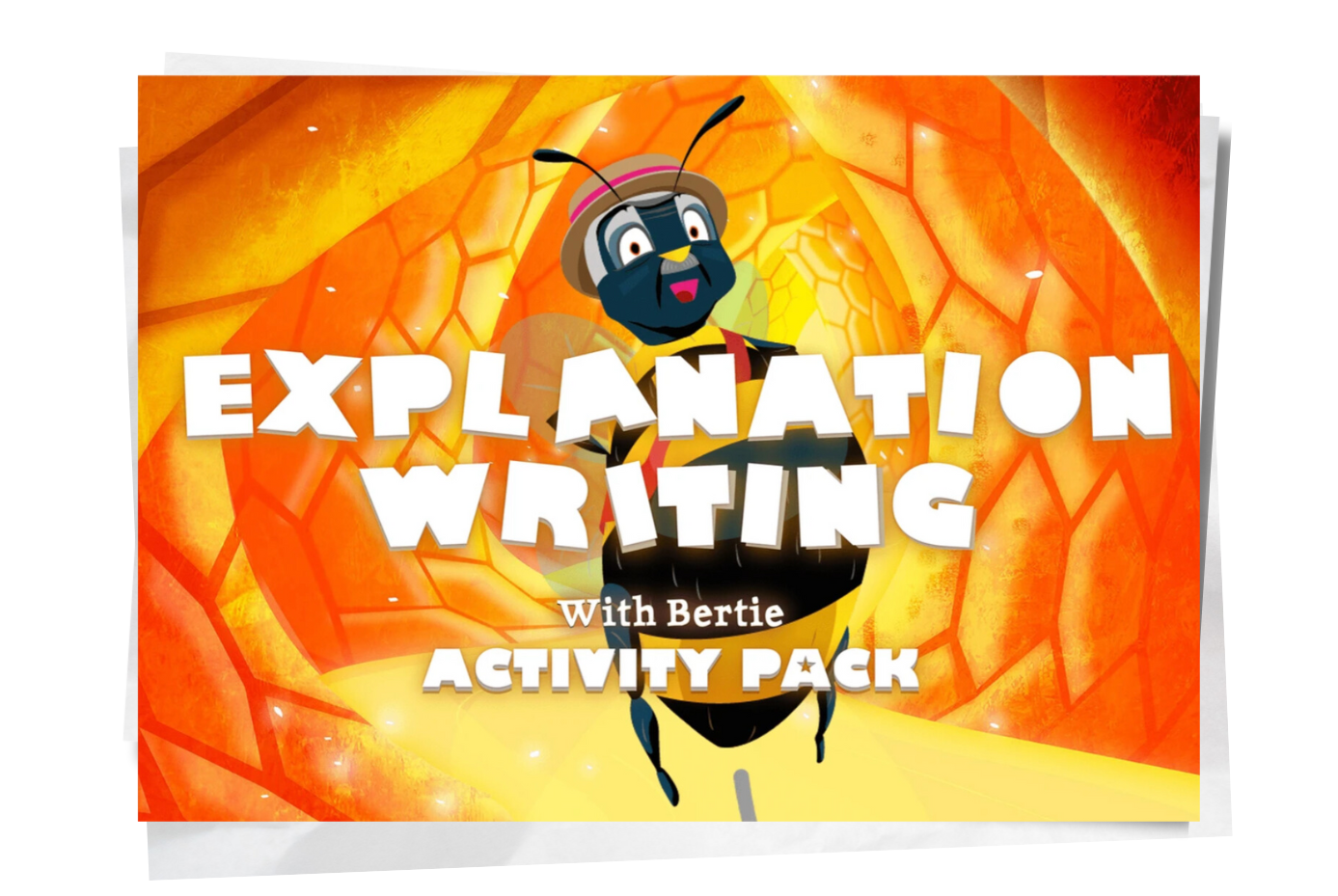
Opinion writing at third grade level requires more attention to detail, a stronger argument, and consistency throughout the text.
In third grade, your child is expected to demonstrate their point of view on a chosen topic and provide valid reasons for their perspective. Your child’s writing in third grade should also include linking words and phrases to piece together a compelling argument. Grade 3 learners should be working on writing to persuade or influence an audience.
How to write an opinion piece at third-grade level
- Start with a short introduction, stating a clear opinion on the topic
- Give a reason for this opinion, followed by a convincing example that validates the point
- Always refer back to the original statement, to ensure that the argument is consistent and coherent
- Finish with a summary of the argument, stating the original opinion once again, to leave the reader thinking about the perspective shared
You can encourage your child to develop opinions on specific topics by engaging in topical discussions! Choose a theme and start a conversation about it - you’ll be surprised by the opinions your child has already formed!
Stories at Grade 3 level should rely on descriptive writing techniques to create a cohesive plot of events, which provide the reader with as much information on the characters , settings and actions as possible!
As it’s not the first time your child will be asked to write a narrative text, they’ll already be familiar with the standard rules of story writing . As the complexity of their work increases however, here are a few tips on how the narrative writing process should happen in third grade:
- Plan and develop a well-structured plot
- Establish characters, settings and actions according to the theme of the story (be as descriptive as possible)
- Use figurative language and literary devices to enhance the plot
- Include an introduction, paragraphs which allow the story to progress chronologically and finish with a great narrative ending
Why not get your child to draw the characters and settings of their story before writing the piece? Not only will this encourage them to think about more details which can be described in the story (such as the clothes worn by the characters or the type of setting), but it will also improve their ability to think creatively about the chosen topic or theme!
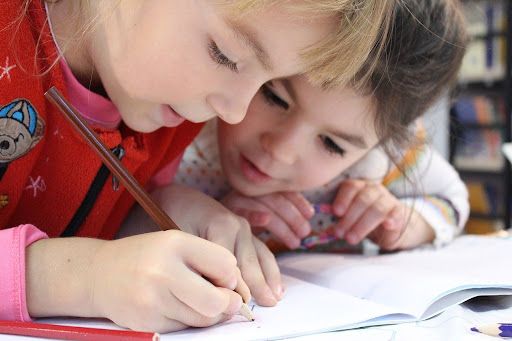
How Night Zookeeper can help

Night Zookeeper is a language arts program that has been created to make language arts fantastically fun for elementary school students!
The extensive collections of lesson series on our program are especially relevant for Grade 3 students, such as The Persuasive Professor , Building Story Tension with the General , and Story Endings with the Guardians . Along with pre-defined lesson plans that your child can access at any time, Night Zookeeper also offers thousands of third grade writing activities, including games on spelling and grammar, creative writing prompts, printable resources, and much more!
All writing resources are determined by grade level, to ensure that your third grader has access to everything they need to become a budding young writer.
Sign up to our program today to get a free 7-day trial!
Related articles
- Elementary Writing
- Grade 3 Writing Prompts
- Grade 3 Reading
- Grade 3 Spelling
- Grade 3 Grammar
- Grade 3 Punctuation

Make Reading & Writing Fantastically Fun!
- Award-winning reading & writing program for kids
- Improves spelling, grammar, punctuation & vocabulary
- Over 1,000 different learning games and activities

- Our Mission
5 High-Impact Writing Strategies for the Elementary Grades
Simple, effective exercises can help elementary students develop the foundational writing skills they need for their academic journey.

When considering writing as part of the instructional day, teachers may think only of the type of writing where students engage in storytelling or informational pieces. While the ability to leverage student choice and produce fiction and nonfiction text is beneficial for all grade levels, it’s important to consider how writing can be incorporated and layered across all content areas, as well as develop the deep foundational understanding to prepare young writers for authoring texts.
For us as teachers, it’s vital that we share a common language and understanding about the types of high-impact writing strategies that students can engage in and how to effectively implement them in the classroom.
1. Handwriting in the Early Grades
In the digital age, prioritizing handwriting education during phonics instruction remains instrumental in nurturing well-rounded learners and sets them up for success when more stamina is required of them. The tactile experience of handwriting establishes a profound connection between language and sensory perception, contributing increased cognitive development .
Teachers can adopt a common path of movement language (language used to describe how to form the letters) when teaching the letters. In addition to that, providing students with multisensory ways of forming the letters helps create a strong understanding of the letters’ features.
A practical example of this type of instruction is having students trace a lowercase a in a tray full of salt, repeating the path of movement language, “over, around, down.” Then, students practice writing the letter using a pencil or dry erase marker. As the teacher models the directionality, it’s important to ensure that students know what “over,” “around,” and “down” mean and look like and that the teacher is using on-the-spot intervention for correction.
2. Dictated Sentences
Utilizing dictated sentences in elementary phonics instruction holds profound importance in nurturing early literacy skills. This strategy serves as a powerful bridge between decoding individual phonemes and comprehending them within a meaningful context.
For example, in a phonics lesson where students are practicing decoding and spelling words with a short i vowel and have practiced reading the high-frequency words they and the , the teacher may end the lesson with students writing the dictated sentence, ”They will fill the big bin with wigs.”
This method encourages the application of phonics knowledge in real-word scenarios, promoting fluency and automaticity. In addition, dictated sentences provide a valuable opportunity for students to hone their listening skills, enhancing their ability to discern and reproduce distinct phonetic elements accurately and to authentically apply irregularly spelled high-frequency words in context. This practice benefits students of any grade level working on phonics skills.
3. Writing to Read
Another foundational type of writing that prepares students for more demanding types of writing in later grades is writing to read. This is an interactive approach to early writing instruction where the teacher models early literacy and print concepts starting as early as prekindergarten through early kindergarten. Through collaboration with the students, the teacher models drawing pictures and sentence creation.
Teachers can start by engaging students in a conversation around an event in a book or nursery rhyme they read together. Then, the teacher offers a prompt: “In the story, the characters went to play at the park. That gives me an idea for a story. What kinds of things do you like to do at the park?” Students can share multiple ideas for the story, and the teacher chooses one to model.
While the teacher explicitly models drawing and develops a sentence about the drawing, the students offer ideas on where to start writing, count the words in the story, identify the sounds they hear as the teacher spells out each word, and notice where spaces will occur. The more that students engage in this type of instruction, the more responsibility we can hand over to them, and they can write the story along with us. As students are given more opportunities to apply early writing principles and rereading strategies, they begin to understand the reciprocal relationship between reading and writing.
4. Reading to Write
When the foundations for early writing have been established, students can quickly move into another layer of high-impact writing, which is writing about the texts that they’re reading.
Even starting in kindergarten, encouraging students to write and/or draw in response to reading across multiple content areas is a valuable strategy that helps deepen comprehension and understanding of a particular topic, as explored in Linda J. Dorn and Carla Soffos’s book Teaching for Deep Comprehension .
These “writing about the reading” prompts require students to analyze, synthesize, and connect ideas, fostering a deeper understanding of the material. For example, if first-grade students are working on story elements, after reading a story, a student might write, “The character in the story is a bear who lives in the forest. The problem in the story is that he is sad, but he solves his problem when he learns to be happy.”
This expression encapsulates comprehension, language reinforcement, and academic vocabulary. As students progress through grade levels upward to 12th grade, the scaffold of giving the students a prompt for writing about the text should decrease as they develop enough self-regulation to write about their own thinking.
5. Writing About Learning
Similar to reading to write, this strategy is solely focused on writing about what the student has learned, why the learning is important, and when to use the learning. This type of writing can happen as early as kindergarten, but in a highly scaffolded manner that mostly focuses on articulating why the learning is important.
Students up to 12th grade can benefit from writing about their learning because it keeps the purpose of what they’re learning in various content areas relevant and promotes quick retrieval of the information.
This strategy also promotes metacognition , because it helps learners organize their thoughts and reflect on their learning process. For instance, a second-grade class could collaboratively study the nature of bees in a nonfiction text. Then, because the teacher focuses on the skill of identifying and explaining main ideas and details, a student may write, “I learned the main idea by using headings and key details. Knowing main ideas helps us understand the most important information in a text.”
Question and Answer forum for K12 Students

Paragraph Writing For Class 3 Format, Topics, Examples, Exercises
Paragraph writing for class 3 in english.
Paragraph writing is an essential skill that students must learn in their early years of education. It helps them to effectively communicate their ideas and thoughts in a structured and organized manner. In class 3, students are introduced to paragraph writing, where they learn about the format, topics, examples, and exercises that can help them improve their writing skills.
The format of a paragraph typically consists of a topic sentence, supporting sentences, and a concluding sentence. The topic sentence introduces the main idea of the paragraph, while the supporting sentences provide evidence and details to support the topic sentence. The concluding sentence summarizes the main points of the paragraph and brings it to a close. By following this format, students can create well-structured and coherent paragraphs.
In class 3, students are also introduced to various topics that they can write about, such as their favorite animal, a memorable vacation, or a special event. These topics help students to develop their writing skills and express their ideas in a clear and concise manner. Additionally, exercises such as inserting missing words in a paragraph or writing a paragraph from an outline can help students to practice their writing skills and improve their overall writing ability.
Also Check: Paragraph Writing Topics For Class 6
Understanding Paragraph Writing For Class 3
Paragraph writing is the process of organizing and presenting information in a coherent and logical manner. A paragraph is a group of related sentences that express a single idea or topic. It is a building block of writing, and it helps to convey information in a clear and concise way. A well-written paragraph contains a topic sentence, supporting details, and a concluding sentence.
Paragraph writing is an essential skill that students need to develop from an early age. It helps them to express their ideas and thoughts in a structured and organized way. Learning how to write a paragraph enables students to communicate effectively, both in writing and speaking. It is a fundamental skill that is required in all academic subjects and is a critical component of writing assignments, essays, and reports.
Paragraph writing also helps students to develop critical thinking skills. It requires them to analyze and synthesize information, identify the main idea, and organize their thoughts in a logical sequence. This process helps them to understand complex concepts and ideas and to express them clearly and concisely.
In conclusion, understanding paragraph writing is crucial for students in Class 3 and beyond. It is a fundamental skill that is required in all academic subjects, and it helps students to communicate effectively and develop critical thinking skills.
Format Of Paragraph Writing For Class 3
When it comes to paragraph writing for Class 3 students, it is essential to follow a specific format that consists of an introduction, body, and conclusion. The introduction should introduce the main idea of the paragraph, the body should provide supporting details and examples, and the conclusion should summarize the main points.
Topic Sentence
The topic sentence is the first sentence of the paragraph, and it should clearly state the main idea of the paragraph. It should be clear, concise, and to the point. The topic sentence should also be relevant to the overall topic of the essay or assignment.
Supporting Details
After the topic sentence, the paragraph should provide supporting details and examples to support the main idea. These details should be specific and relevant to the topic. It is essential to use descriptive language and provide examples to help the reader understand the main idea of the paragraph.
One way to organize supporting details is to use a table or bullet points. This can help to make the information easier to read and understand.
Concluding Sentence
The concluding sentence is the last sentence of the paragraph, and it should summarize the main points of the paragraph. It should also be relevant to the overall topic of the essay or assignment. The concluding sentence should be clear, concise, and to the point.
In conclusion, following a specific format for paragraph writing can help Class 3 students to write clear and concise paragraphs. By including a topic sentence, supporting details, and a concluding sentence, students can effectively communicate their ideas and thoughts in writing.
Topics For Paragraph Writing For Class 3
Paragraph writing is an essential skill that students learn in their early years of education. It helps them to communicate their ideas effectively and efficiently. For Class 3 students, paragraph writing topics should be simple and easy to understand. Here are some topics that teachers can use to help their students improve their paragraph-writing skills:
- My Favorite Animal: Students can write a paragraph about their favorite animal, describing its appearance, habitat, and behavior. They can also mention why they like this animal and what makes it special to them.
- My Best Friend: Students can write a paragraph about their best friend, describing their personality, hobbies, and interests. They can also mention how they met and what they like to do together.
- My Favorite Season: Students can write a paragraph about their favorite season, describing the weather, activities, and events that take place during that time of the year. They can also mention why they like this season and what makes it special to them.
- My Favorite Food: Students can write a paragraph about their favorite food, describing its taste, texture, and ingredients. They can also mention why they like this food and when they usually eat it.
- My Family: Students can write a paragraph about their family, describing their parents, siblings, and pets. They can also mention what they like to do together and how they celebrate special occasions.
These topics are simple and easy to understand, and they provide students with an opportunity to express their thoughts and ideas in a clear and concise manner. Teachers can also encourage their students to come up with their own topics and share them with the class.
Examples Of Paragraph Writing For Class 3
Title: My Favorite Animal
Outline: Introduction – My favorite animal is a dog. Body – Reasons why I love dogs – They are loyal, friendly, and playful. Conclusion – Dogs are the best pets.
Paragraph: Dogs are amazing animals and they make great pets. They are loyal and will always be by your side no matter what. They are also very friendly and love to play. Whenever I come home from school, my dog always greets me at the door with a wagging tail. I love spending time with my dog and playing fetch in the backyard. Dogs are definitely the best pets.

Title: My Favorite Hobby
Outline: Introduction – My favorite hobby is drawing. Body – Reasons why I love drawing – It’s relaxing, creative, and fun. Conclusion – Drawing is a great way to express yourself.
Paragraph: Drawing is my favorite hobby because it allows me to be creative and express myself. Whenever I feel stressed or anxious, I like to sit down and draw. It’s a great way to relax and clear my mind. I love experimenting with different colors and techniques to create something unique. Drawing is also a lot of fun and I enjoy the process of bringing my ideas to life on paper.
Title: My Favorite Food
Outline: Introduction – My favorite food is pizza. Body – Reasons why I love pizza – It’s delicious, versatile, and easy to share. Conclusion – Pizza is the perfect meal for any occasion.
Paragraph: Pizza is my favorite food because it’s delicious and there are so many different toppings to choose from. Whether I’m in the mood for pepperoni, mushrooms, or olives, there’s always a pizza that will satisfy my cravings. Pizza is also very versatile and can be eaten for lunch, dinner, or even as a snack. Plus, it’s easy to share with friends and family, which makes it the perfect meal for any occasion.
Exercises For Paragraph Writing For Class 3
In this exercise, students will practice writing a paragraph on a given topic. The teacher will provide a topic, and students will need to write a paragraph on it. Students should follow the format of a well-structured paragraph, including a topic sentence, supporting details, and a concluding sentence.
Here are some topics for practice:
- My Favorite Animal
- A Memorable Vacation
- The Importance of Exercise
In this exercise, students will practice identifying the different parts of a paragraph. The teacher will provide a paragraph, and students will need to identify the topic sentence, supporting details, and concluding sentence. This exercise will help students understand the structure of a well-written paragraph and how to organize their own writing.
Here are some example paragraphs for practice:
- The Benefits of Reading
- The Life Cycle of a Butterfly
- My Best Friend
In this exercise, students will practice editing and revising a paragraph. The teacher will provide a paragraph with errors, and students will need to identify and correct them. This exercise will help students develop their editing and proofreading skills, which are essential for producing high-quality writing.
- The Importance of Eating Healthy
- My Favorite Hobby
- A Day at the Beach
Overall, these exercises will help students develop their paragraph writing skills and become more confident writers. With practice and guidance, students can learn to write clear, well-structured paragraphs that effectively communicate their ideas.
Recommended Reading: Paragraph Writing For Class 3
Review and Assessment For Paragraph Writing For Class 3
After learning about paragraph writing in Class 3, it is important to review and assess the knowledge gained. This will help students understand their strengths and weaknesses and improve their writing skills.
One way to assess paragraph writing skills is to give students writing prompts and have them write a paragraph based on the prompt. Teachers can evaluate the paragraphs based on the following criteria:
- Unity: Does the paragraph have a clear main idea?
- Coherence: Are the sentences in the paragraph logically connected?
- Organization: Is the paragraph structured in a logical way?
- Grammar and Spelling: Are the sentences grammatically correct and spelled correctly?
Another way to assess paragraph writing skills is to have students analyze and revise poorly written paragraphs. This will help them identify common mistakes and improve their own writing.
Teachers can also provide feedback to students by using rubrics that clearly outline the expectations for a well-written paragraph. Rubrics can include criteria such as the use of transitional words, sentence variety, and the inclusion of supporting details.
Overall, reviewing and assessing paragraph writing skills is an important step in developing strong writing skills. By providing feedback and opportunities for improvement, students can continue to develop their writing skills and become confident writers.
The War at Stanford
I didn’t know that college would be a factory of unreason.

Listen to this article
Produced by ElevenLabs and News Over Audio (NOA) using AI narration.
This article was featured in the One Story to Read Today newsletter. Sign up for it here .
ne of the section leaders for my computer-science class, Hamza El Boudali, believes that President Joe Biden should be killed. “I’m not calling for a civilian to do it, but I think a military should,” the 23-year-old Stanford University student told a small group of protesters last month. “I’d be happy if Biden was dead.” He thinks that Stanford is complicit in what he calls the genocide of Palestinians, and that Biden is not only complicit but responsible for it. “I’m not calling for a vigilante to do it,” he later clarified, “but I’m saying he is guilty of mass murder and should be treated in the same way that a terrorist with darker skin would be (and we all know terrorists with dark skin are typically bombed and drone striked by American planes).” El Boudali has also said that he believes that Hamas’s October 7 attack was a justifiable act of resistance, and that he would actually prefer Hamas rule America in place of its current government (though he clarified later that he “doesn’t mean Hamas is perfect”). When you ask him what his cause is, he answers: “Peace.”
I switched to a different computer-science section.
Israel is 7,500 miles away from Stanford’s campus, where I am a sophomore. But the Hamas invasion and the Israeli counterinvasion have fractured my university, a place typically less focused on geopolitics than on venture-capital funding for the latest dorm-based tech start-up. Few students would call for Biden’s head—I think—but many of the same young people who say they want peace in Gaza don’t seem to realize that they are in fact advocating for violence. Extremism has swept through classrooms and dorms, and it is becoming normal for students to be harassed and intimidated for their faith, heritage, or appearance—they have been called perpetrators of genocide for wearing kippahs, and accused of supporting terrorism for wearing keffiyehs. The extremism and anti-Semitism at Ivy League universities on the East Coast have attracted so much media and congressional attention that two Ivy presidents have lost their jobs. But few people seem to have noticed the culture war that has taken over our California campus.
For four months, two rival groups of protesters, separated by a narrow bike path, faced off on Stanford’s palm-covered grounds. The “Sit-In to Stop Genocide” encampment was erected by students in mid-October, even before Israeli troops had crossed into Gaza, to demand that the university divest from Israel and condemn its behavior. Posters were hung equating Hamas with Ukraine and Nelson Mandela. Across from the sit-in, a rival group of pro-Israel students eventually set up the “Blue and White Tent” to provide, as one activist put it, a “safe space” to “be a proud Jew on campus.” Soon it became the center of its own cluster of tents, with photos of Hamas’s victims sitting opposite the rubble-ridden images of Gaza and a long (and incomplete) list of the names of slain Palestinians displayed by the students at the sit-in.
Some days the dueling encampments would host only a few people each, but on a sunny weekday afternoon, there could be dozens. Most of the time, the groups tolerated each other. But not always. Students on both sides were reportedly spit on and yelled at, and had their belongings destroyed. (The perpetrators in many cases seemed to be adults who weren’t affiliated with Stanford, a security guard told me.) The university put in place round-the-clock security, but when something actually happened, no one quite knew what to do.
Conor Friedersdorf: How October 7 changed America’s free speech culture
Stanford has a policy barring overnight camping, but for months didn’t enforce it, “out of a desire to support the peaceful expression of free speech in the ways that students choose to exercise that expression”—and, the administration told alumni, because the university feared that confronting the students would only make the conflict worse. When the school finally said the tents had to go last month, enormous protests against the university administration, and against Israel, followed.
“We don’t want no two states! We want all of ’48!” students chanted, a slogan advocating that Israel be dismantled and replaced by a single Arab nation. Palestinian flags flew alongside bright “Welcome!” banners left over from new-student orientation. A young woman gave a speech that seemed to capture the sense of urgency and power that so many students here feel. “We are Stanford University!” she shouted. “We control things!”
“W e’ve had protests in the past,” Richard Saller, the university’s interim president, told me in November—about the environment, and apartheid, and Vietnam. But they didn’t pit “students against each other” the way that this conflict has.
I’ve spoken with Saller, a scholar of Roman history, a few times over the past six months in my capacity as a student journalist. We first met in September, a few weeks into his tenure. His predecessor, Marc Tessier-Lavigne, had resigned as president after my reporting for The Stanford Daily exposed misconduct in his academic research. (Tessier-Lavigne had failed to retract papers with faked data over the course of 20 years. In his resignation statement , he denied allegations of fraud and misconduct; a Stanford investigation determined that he had not personally manipulated data or ordered any manipulation but that he had repeatedly “failed to decisively and forthrightly correct mistakes” from his lab.)
In that first conversation, Saller told me that everyone was “eager to move on” from the Tessier-Lavigne scandal. He was cheerful and upbeat. He knew he wasn’t staying in the job long; he hadn’t even bothered to move into the recently vacated presidential manor. In any case, campus, at that time, was serene. Then, a week later, came October 7.
The attack was as clear a litmus test as one could imagine for the Middle East conflict. Hamas insurgents raided homes and a music festival with the goal of slaughtering as many civilians as possible. Some victims were raped and mutilated, several independent investigations found. Hundreds of hostages were taken into Gaza and many have been tortured.
This, of course, was bad. Saying this was bad does not negate or marginalize the abuses and suffering Palestinians have experienced in Gaza and elsewhere. Everyone, of every ideology, should be able to say that this was bad. But much of this campus failed that simple test.
Two days after the deadliest massacre of Jews since the Holocaust, Stanford released milquetoast statements marking the “moment of intense emotion” and declaring “deep concern” over “the crisis in Israel and Palestine.” The official statements did not use the words Hamas or violence .
The absence of a clear institutional response led some teachers to take matters into their own hands. During a mandatory freshman seminar on October 10, a lecturer named Ameer Loggins tossed out his lesson plan to tell students that the actions of the Palestinian “military force” had been justified, that Israelis were colonizers, and that the Holocaust had been overemphasized, according to interviews I conducted with students in the class. Loggins then asked the Jewish students to identify themselves. He instructed one of them to “stand up, face the window, and he kind of kicked away his chair,” a witness told me. Loggins described this as an effort to demonstrate Israel’s treatment of Palestinians. (Loggins did not reply to a request for comment; a spokesperson for Stanford said that there were “different recollections of the details regarding what happened” in the class.)
“We’re only in our third week of college, and we’re afraid to be here,” three students in the class wrote in an email that night to administrators. “This isn’t what Stanford was supposed to be.” The class Loggins taught is called COLLEGE, short for “Civic, Liberal, and Global Education,” and it is billed as an effort to develop “the skills that empower and enable us to live together.”
Loggins was suspended from teaching duties and an investigation was opened; this angered pro-Palestine activists, who organized a petition that garnered more than 1,700 signatures contesting the suspension. A pamphlet from the petitioners argued that Loggins’s behavior had not been out of bounds.
The day after the class, Stanford put out a statement written by Saller and Jenny Martinez, the university provost, more forcefully condemning the Hamas attack. Immediately, this new statement generated backlash.
Pro-Palestine activists complained about it during an event held the same day, the first of several “teach-ins” about the conflict. Students gathered in one of Stanford’s dorms to “bear witness to the struggles of decolonization.” The grievances and pain shared by Palestinian students were real. They told of discrimination and violence, of frightened family members subjected to harsh conditions. But the most raucous reaction from the crowd was in response to a young woman who said, “You ask us, do we condemn Hamas? Fuck you!” She added that she was “so proud of my resistance.”
David Palumbo-Liu, a professor of comparative literature with a focus on postcolonial studies, also spoke at the teach-in, explaining to the crowd that “European settlers” had come to “replace” Palestine’s “native population.”
Palumbo-Liu is known as an intelligent and supportive professor, and is popular among students, who call him by his initials, DPL. I wanted to ask him about his involvement in the teach-in, so we met one day in a café a few hundred feet away from the tents. I asked if he could elaborate on what he’d said at the event about Palestine’s native population. He was happy to expand: This was “one of those discussions that could go on forever. Like, who is actually native? At what point does nativism lapse, right? Well, you haven’t been native for X number of years, so …” In the end, he said, “you have two people who both feel they have a claim to the land,” and “they have to live together. Both sides have to cede something.”
The struggle at Stanford, he told me, “is to find a way in which open discussions can be had that allow people to disagree.” It’s true that Stanford has utterly failed in its efforts to encourage productive dialogue. But I still found it hard to reconcile DPL’s words with his public statements on Israel, which he’d recently said on Facebook should be “the most hated nation in the world.” He also wrote: “When Zionists say they don’t feel ‘safe’ on campus, I’ve come to see that as they no longer feel immune to criticism of Israel.” He continued: “Well as the saying goes, get used to it.”
Z ionists, and indeed Jewish students of all political beliefs, have been given good reason to fear for their safety. They’ve been followed, harassed, and called derogatory racial epithets. At least one was told he was a “dirty Jew.” At least twice, mezuzahs have been ripped from students’ doors, and swastikas have been drawn in dorms. Arab and Muslim students also face alarming threats. The computer-science section leader, El Boudali, a pro-Palestine activist, told me he felt “safe personally,” but knew others who did not: “Some people have reported feeling like they’re followed, especially women who wear the hijab.”
In a remarkably short period of time, aggression and abuse have become commonplace, an accepted part of campus activism. In January, Jewish students organized an event dedicated to ameliorating anti-Semitism. It marked one of Saller’s first public appearances in the new year. Its topic seemed uncontroversial, and I thought it would generate little backlash.
Protests began before the panel discussion even started, with activists lining the stairs leading to the auditorium. During the event they drowned out the panelists, one of whom was Israel’s special envoy for combatting anti-Semitism, by demanding a cease-fire. After participants began cycling out into the dark, things got ugly.
Activists, their faces covered by keffiyehs or medical masks, confronted attendees. “Go back to Brooklyn!” a young woman shouted at Jewish students. One protester, who emerged as the leader of the group, said that she and her compatriots would “take all of your places and ensure Israel falls.” She told attendees to get “off our fucking campus” and launched into conspiracy theories about Jews being involved in “child trafficking.” As a rabbi tried to leave the event, protesters pursued him, chanting, “There is only one solution! Intifada revolution!”
At one point, some members of the group turned on a few Stanford employees, including another rabbi, an imam, and a chaplain, telling them, “We know your names and we know where you work.” The ringleader added: “And we’ll soon find out where you live.” The religious leaders formed a protective barrier in front of the Jewish students. The rabbi and the imam appeared to be crying.

S aller avoided the protest by leaving through another door. Early that morning, his private residence had been vandalized. Protesters frequently tell him he “can’t hide” and shout him down. “We charge you with genocide!” they chant, demanding that Stanford divest from Israel. (When asked whether Stanford actually invested in Israel, a spokesperson replied that, beyond small exposures from passive funds that track indexes such as the S&P 500, the university’s endowment “has no direct holdings in Israeli companies, or direct holdings in defense contractors.”)
When the university finally said the protest tents had to be removed, students responded by accusing Saller of suppressing their right to free speech. This is probably the last charge he expected to face. Saller once served as provost at the University of Chicago, which is known for holding itself to a position of strict institutional neutrality so that its students can freely explore ideas for themselves. Saller has a lifelong belief in First Amendment rights. But that conviction in impartial college governance does not align with Stanford’s behavior in recent years. Despite the fact that many students seemed largely uninterested in the headlines before this year, Stanford’s administrative leadership has often taken positions on political issues and events, such as the Paris climate conference and the murder of George Floyd. After Russia invaded Ukraine, Stanford’s Hoover Tower was lit up in blue and yellow, and the school released a statement in solidarity.
Thomas Chatterton Williams: Let the activists have their loathsome rallies
When we first met, a week before October 7, I asked Saller about this. Did Stanford have a moral duty to denounce the war in Ukraine, for example, or the ethnic cleansing of Uyghur Muslims in China? “On international political issues, no,” he said. “That’s not a responsibility for the university as a whole, as an institution.”
But when Saller tried to apply his convictions on neutrality for the first time as president, dozens of faculty members condemned the response, many pro-Israel alumni were outraged, donors had private discussions about pulling funding, and an Israeli university sent an open letter to Saller and Martinez saying, “Stanford’s administration has failed us.” The initial statement had tried to make clear that the school’s policy was not Israel-specific: It noted that the university would not take a position on the turmoil in Nagorno-Karabakh (where Armenians are undergoing ethnic cleansing) either. But the message didn’t get through.
Saller had to beat an awkward retreat or risk the exact sort of public humiliation that he, as caretaker president, had presumably been hired to avoid. He came up with a compromise that landed somewhere in the middle: an unequivocal condemnation of Hamas’s “intolerable atrocities” paired with a statement making clear that Stanford would commit to institutional neutrality going forward.
“The events in Israel and Gaza this week have affected and engaged large numbers of students on our campus in ways that many other events have not,” the statement read. “This is why we feel compelled to both address the impact of these events on our campus and to explain why our general policy of not issuing statements about news events not directly connected to campus has limited the breadth of our comments thus far, and why you should not expect frequent commentary from us in the future.”
I asked Saller why he had changed tack on Israel and not on Nagorno-Karabakh. “We don’t feel as if we should be making statements on every war crime and atrocity,” he told me. This felt like a statement in and of itself.
In making such decisions, Saller works closely with Martinez, Stanford’s provost. I happened to interview her, too, a few days before October 7, not long after she’d been appointed. When I asked about her hopes for the job, she said that a “priority is ensuring an environment in which free speech and academic freedom are preserved.”
We talked about the so-called Leonard Law—a provision unique to California that requires private universities to be governed by the same First Amendment protections as public ones. This restricts what Stanford can do in terms of penalizing speech, putting it in a stricter bind than Harvard, the University of Pennsylvania, or any of the other elite private institutions that have more latitude to set the standards for their campus (whether or not they have done so).
So I was surprised when, in December, the university announced that abstract calls for genocide “clearly violate Stanford’s Fundamental Standard, the code of conduct for all students at the university.” The statement was a response to the outrage following the congressional testimony of three university presidents—outrage that eventually led to the resignation of two of them, Harvard’s Claudine Gay and Penn’s Liz Magill. Gay and Magill, who had both previously held positions at Stanford, did not commit to punishing calls for the genocide of Jews.
Experts told me that Stanford’s policy is impossible to enforce—and Saller himself acknowledged as much in our March interview.
“Liz Magill is a good friend,” Saller told me, adding, “Having watched what happened at Harvard and Penn, it seemed prudent” to publicly state that Stanford rejected calls for genocide. But saying that those calls violate the code of conduct “is not the same thing as to say that we could actually punish it.”
Stanford’s leaders seem to be trying their best while adapting to the situation in real time. But the muddled messaging has created a policy of neutrality that does not feel neutral at all.
When we met back in November, I tried to get Saller to open up about his experience running an institution in turmoil. What’s it like to know that so many students seem to believe that he—a mild-mannered 71-year-old classicist who swing-dances with his anthropologist wife—is a warmonger? Saller was more candid than I expected—perhaps more candid than any prominent university president has been yet. We sat in the same conference room as we had in September. The weather hadn’t really changed. Yet I felt like I was sitting in front of a different person. He was hunched over and looked exhausted, and his voice broke when he talked about the loss of life in Gaza and Israel and “the fact that we’re caught up in it.” A capable administrator with decades of experience, Saller seemed almost at a loss. “It’s been a kind of roller coaster, to be honest.”
He said he hadn’t anticipated the deluge of the emails “blaming me for lack of moral courage.” Anything the university says seems bound to be wrong: “If I say that our position is that we grieve over the loss of innocent lives, that in itself will draw some hostile reactions.”
“I find that really difficult to navigate,” he said with a sigh.
By March, it seemed that his views had solidified. He said he knew he was “a target,” but he was not going to be pushed into issuing any more statements. The continuing crisis seems to have granted him new insight. “I am certain that whatever I say will not have any material effect on the war in Gaza.” It’s hard to argue with that.
P eople tend to blame the campus wars on two villains: dithering administrators and radical student activists. But colleges have always had dithering administrators and radical student activists. To my mind, it’s the average students who have changed.
Elite universities attract a certain kind of student: the overachieving striver who has won all the right accolades for all the right activities. Is it such a surprise that the kids who are trained in the constant pursuit of perfect scores think they have to look at the world like a series of multiple-choice questions, with clearly right or wrong answers? Or that they think they can gamify a political cause in the same way they ace a standardized test?
Everyone knows that the only reliable way to get into a school like Stanford is to be really good at looking really good. Now that they’re here, students know that one easy way to keep looking good is to side with the majority of protesters, and condemn Israel.
It’s not that there isn’t real anger and anxiety over what is happening in Gaza—there is, and justifiably so. I know that among the protesters are many people who are deeply connected to this issue. But they are not the majority. What really activates the crowds now seems less a principled devotion to Palestine or to pacifism than a desire for collective action, to fit in by embracing the fashionable cause of the moment—as if a centuries-old conflict in which both sides have stolen and killed could ever be a simple matter of right and wrong. In their haste to exhibit moral righteousness, many of the least informed protesters end up being the loudest and most uncompromising.
Today’s students grew up in the Trump era, in which violent rhetoric has become a normal part of political discourse and activism is as easy as reposting an infographic. Many young people have come to feel that being angry is enough to foment change. Furious at the world’s injustices and desperate for a simple way to express that fury, they don’t seem interested in any form of engagement more nuanced than backing a pure protagonist and denouncing an evil enemy. They don’t, always, seem that concerned with the truth.
At the protest last month to prevent the removal of the sit-in, an activist in a pink Women’s March “pussy hat” shouted that no rape was committed by Hamas on October 7. “There hasn’t been proof of these rape accusations,” a student told me in a separate conversation, criticizing the Blue and White Tent for spreading what he considered to be misinformation about sexual violence. (In March, a United Nations report found “reasonable grounds to believe that conflict-related sexual violence,” including “rape and gang rape,” occurred in multiple locations on October 7, as well as “clear and convincing information” on the “rape and sexualized torture” of hostages.) “The level of propaganda” surrounding Hamas, he told me, “is just unbelievable.”
The real story at Stanford is not about the malicious actors who endorse sexual assault and murder as forms of resistance, but about those who passively enable them because they believe their side can do no wrong. You don’t have to understand what you’re arguing for in order to argue for it. You don’t have to be able to name the river or the sea under discussion to chant “From the river to the sea.” This kind of obliviousness explains how one of my friends, a gay activist, can justify Hamas’s actions, even though it would have the two of us—an outspoken queer person and a Jewish reporter—killed in a heartbeat. A similar mentality can exist on the other side: I have heard students insist on the absolute righteousness of Israel yet seem uninterested in learning anything about what life is like in Gaza.
I’m familiar with the pull of achievement culture—after all, I’m a product of the same system. I fell in love with Stanford as a 7-year-old, lying on the floor of an East Coast library and picturing all the cool technology those West Coast geniuses were dreaming up. I cried when I was accepted; I spent the next few months scrolling through the course catalog, giddy with anticipation. I wanted to learn everything.
I learned more than I expected. Within my first week here, someone asked me: “Why are all Jews so rich?” In 2016, when Stanford’s undergraduate senate had debated a resolution against anti-Semitism, one of its members argued that the idea of “Jews controlling the media, economy, government, and other societal institutions” represented “a very valid discussion.” (He apologized, and the resolution passed.) In my dorm last year, a student discussed being Jewish and awoke the next day to swastikas and a portrait of Hitler affixed to his door.
David Frum: There is no right to bully and harass
I grew up secularly, with no strong affiliation to Jewish culture. When I found out as a teenager that some of my ancestors had hidden their identity from their children and that dozens of my relatives had died in the Holocaust (something no living member of my family had known), I felt the barest tremor of identity. After I saw so many people I know cheering after October 7, I felt something stronger stir. I know others have experienced something similar. Even a professor texted me to say that she felt Jewish in a way she never had before.
But my frustration with the conflict on campus has little to do with my own identity. Across the many conversations and hours of formal interviews I conducted for this article, I’ve encountered a persistent anti-intellectual streak. I’ve watched many of my classmates treat death so cavalierly that they can protest as a pregame to a party. Indeed, two parties at Stanford were reported to the university this fall for allegedly making people say “Fuck Israel” or “Free Palestine” to get in the door. A spokesperson for the university said it was “unable to confirm the facts of what occurred,” but that it had “met with students involved in both parties to make clear that Stanford’s nondiscrimination policy applies to parties.” As a friend emailed me not long ago: “A place that was supposed to be a sanctuary from such unreason has become a factory for it.”
Readers may be tempted to discount the conduct displayed at Stanford. After all, the thinking goes, these are privileged kids doing what they always do: embracing faux-radicalism in college before taking jobs in fintech or consulting. These students, some might say, aren’t representative of America.
And yet they are representative of something: of the conduct many of the most accomplished students in my generation have accepted as tolerable, and what that means for the future of our country. I admire activism. We need people willing to protest what they see as wrong and take on entrenched systems of repression. But we also need to read, learn, discuss, accept the existence of nuance, embrace diversity of thought, and hold our own allies to high standards. More than ever, we need universities to teach young people how to do all of this.
F or so long , Stanford’s physical standoff seemed intractable. Then, in early February, a storm swept in, and the natural world dictated its own conclusion.
Heavy rains flooded campus. For hours, the students battled to save their tents. The sit-in activists used sandbags and anything else they could find to hold back the water—at one point, David Palumbo-Liu, the professor, told me he stood in the lashing downpour to anchor one of the sit-in’s tents with his own body. When the storm hit, many of the Jewish activists had been attending a discussion on anti-Semitism. They raced back and struggled to salvage the Blue and White Tent, but it was too late—the wind had ripped it out of the ground.
The next day, the weary Jewish protesters returned to discover that their space had been taken.
A new collection of tents had been set up by El Boudali, the pro-Palestine activist, and a dozen friends. He said they were there to protest Islamophobia and to teach about Islam and jihad, and that they were a separate entity from the Sit-In to Stop Genocide, though I observed students cycling between the tents. Palestinian flags now flew from the bookstore to the quad.
Administrators told me they’d quickly informed El Boudali and his allies that the space had been reserved by the Jewish advocates, and offered to help move them to a different location. But the protesters told me they had no intention of going. (El Boudali later said that they did not take over the entire space, and would have been “happy to exist side by side, but they wanted to kick us off entirely from that lawn.”)
When it was clear that the area where they’d set up their tents would not be ceded back to the pro-Israel group willingly, Stanford changed course and decided to clear everyone out in one fell swoop. On February 8, school officials ordered all students to vacate the plaza overnight. The university was finally going to enforce its rule prohibiting people from sleeping outside on campus and requiring the removal of belongings from the plaza between 8 p.m. and 8 a.m. The order cited the danger posed by the storm as a justification for changing course and, probably hoping to avoid allegations of bias, described the decision as “viewpoint-neutral.”
That didn’t work.
About a week of protests, led by the sit-in organizers, followed. Chants were chanted. More demands for a “river to the sea” solution to the Israel problem were made. A friend boasted to me about her willingness to be arrested. Stanford sent a handful of staff members, who stood near balloons left over from an event earlier in the day. They were there, one of them told me, to “make students feel supported and safe.”
In the end, Saller and Martinez agreed to talk with the leaders of the sit-in about their demands to divest the university and condemn Israel, under the proviso that the activists comply with Stanford’s anti-camping guidelines “regardless of the outcome of discussions.” Eight days after they were first instructed to leave, 120 days after setting up camp, the sit-in protesters slept in their own beds. In defiance of the university’s instructions, they left behind their tents. But sometime in the very early hours of the morning, law-enforcement officers confiscated the structures. The area was cordoned off without any violence and the plaza filled once more with electric skateboards and farmers’ markets.
The conflict continues in its own way. Saller was just shouted down by protesters chanting “No peace on stolen land” at a Family Weekend event, and protesters later displayed an effigy of him covered in blood. Students still feel tense; Saller still seems worried. He told me that the university is planning to change all manner of things—residential-assistant training, new-student orientation, even the acceptance letters that students receive—in hopes of fostering a culture of greater tolerance. But no campus edict or panel discussion can address a problem that is so much bigger than our university.
At one rally last fall, a speaker expressed disillusionment about the power of “peaceful resistance” on college campuses. “What is there left to do but to take up arms?” The crowd cheered as he said Israel must be destroyed. But what would happen to its citizens? I’d prefer to believe that most protesters chanting “Palestine is Arab” and shouting that we must “smash the Zionist settler state” don’t actually think Jews should be killed en masse. But can one truly be so ignorant as to advocate widespread violence in the name of peace?
When the world is rendered in black-and-white—portrayed as a simple fight between colonizer and colonized—the answer is yes. Solutions, by this logic, are absolute: Israel or Palestine, nothing in between. Either you support liberation of the oppressed or you support genocide. Either Stanford is all good or all bad; all in favor of free speech or all authoritarian; all anti-Semitic or all Islamophobic.
At January’s anti-anti-Semitism event, I watched an exchange between a Jewish attendee and a protester from a few feet away. “Are you pro-Palestine?” the protester asked.
“Yes,” the attendee responded, and he went on to describe his disgust with the human-rights abuses Palestinians have faced for years.
“But are you a Zionist?”
“Then we are enemies.”
9 AI hacks that Mark Zuckerberg, Sundar Pichai, Jensen Huang, and other business leaders use
- Business leaders are using AI tools like OpenAI's ChatGPT as the sector booms.
- Some have tried AI on the job , while others have played with it to write raps and translate poetry.
- Here's how nine executives from companies like Meta, Google, and Microsoft deploy the technology.

Ever since OpenAI launched ChatGPT in November 2023, everyone's been talking about — and trying out — the hot new tech in their personal and professional lives.
That includes some of the world's most influential business leaders.
Many companies aside from OpenAI have released generative AI products with human-like capabilities to cash in on the hype. Users have been turning to the technology to save time and reach their goals.
Some workers have used ChatGPT to generate lesson plans , produce marketing materials, and write legal briefs. Others have turned to chatbots to help them lose weight , do homework, and plan vacations. Some even claimed they made money with AI.
And interest has also permeated the C-suite, with leaders just as keen to make the technology work for them. From translating poetry to creating rap songs, here's how executives from Meta, Google, Microsoft, and other major companies have personally used AI.
Nvidia's Jensen Huang said he uses Perplexity AI "almost every day."
The CEO of the chip company that makes highly coveted GPUs to power AI models uses the AI-powered question-and-answer search engine for research, he told Wired in February this year.
In the interview, he gave an example of how Perplexity can be used to learn about recent advancements in computer-aided drug discovery.
"You want to frame the overall topic so that you could have a framework," Huang told Wired. "From that framework, you could ask more and more specific questions."
"I really love that about these large language models," he said.
The CEO said he uses OpenAI's ChatGPT as well.
AMD CEO Lisa Su said she uses Microsoft's Copilot to "summarize meetings" and "track actions."
Still, Su doesn't think Microsoft's AI assistant is perfect.
"It doesn't write my emails so well," the CEO of Nvidia competitor AMD said during her SXSW keynote in March 2024. "I don't use it for that."
Microsoft has integrated Copilot into its suite of office products, including PowerPoint, Word, and Excel.
Microsoft CEO Satya Nadella said his favorite way to use ChatGPT is to explain German philosophy and Persian poetry.
Nadella said ChatGPT helps him comprehend complicated texts from philosophers like Martin Heidegger.
"I remember my father trying to read Heidegger in his forties and struggling with it, and I have attempted it a thousand times and failed," the CEO said on a June 2023 episode of Freakonomics Radio . "But I must say going and asking ChatGPT or Bing chat to summarize Heidegger is the best way to read Heidegger."
He was also impressed by the AI chatbot's ability to translate poetry. He said his favorite prompt is asking ChatGPT to translate Rumi from Urdu into English.
"The most interesting thing about it is that it captures the depth of poetry," Nadella said on the podcast. "It somehow finds, in that latent space, meaning that's beyond just the words and the translation. That I find is just phenomenal."
Venture capitalist Vinod Khosla said he used ChatGPT to write a rap for his daughter's wedding.
"I wrote what I wanted to say to her as a speech, entered it into ChatGPT, said, 'Do rap lyrics for it,' it did, and then entered it into a music AI," the OpenAI investor posted on X, formerly Twitter, in October 2023.
"So I was able to blare it over the speakers, a personal rap song from me," Khosla added. "It extended my capability. It meant a lot to me."
He's the founder of Khosla Ventures, a VC investing in startups in AI, clean technology, and biomedicine, among other sectors.
CEO and cofounder of OpenAI Sam Altman said he uses his company's chatbot for translation and writing.
In August 2023, Altman told Bloomberg that ChatGPT was a "life saver" for translation purposes during his world tour, where he discussed the future of AI. Over three months, he visited countries like Israel, Jordan, Qatar, the UAE, India, and South Korea.
The face behind ChatGPT said his creation helps him "write faster" and "think more."
"I see the path towards, like, this being my super assistant for all of my cognitive work," he told Bloomberg.
Sundar Pichai, CEO of Google, said he used a language model to talk to the planet Pluto with his son.
In an episode of the New York Times' tech podcast " Hard Fork," Pichai said he asked LaMDA, one of the search giant's early conversational AI models, to pretend it was the planet Pluto to test its capabilities.
During one conversation, LaMDA told Pichai and his son that Pluto is "really lonely" because it's so far out in space.
"I felt sad at that point talking to it," the CEO said on the March 2023 episode of the podcast.
He also asked LaMDA what he should do for his father's 80th birthday. In response, the model suggested that he make a scrapbook.
"It's not that it's profound, but it says things and kind of sparks the imagination," he told the NYT when describing the prompt.
Google unveiled Gemini, its latest language model that could generate text and photos using prompts, in December 2023.
Billionaire investor Warren Buffett said he used ChatGPT to translate the Frank Sinatra song 'My Way' into Spanish.
The chairperson of Berkshire Hathaway seemed to be satisfied with the output.
"Two seconds later, you know, it comes out" and "rhymes and does all these wonderful things," Buffett told CNBC on April 2023 regarding the song.
While the billionaire said he sees the potential for ChatGPT to save time, he was skeptical about whether it could positively impact society.
"I think this is extraordinary, but I don't know if it's beneficial," he told CNBC.
Tim Cook, CEO of Apple, said he uses ChatGPT in his personal life.
Cook didn't specify how he uses the AI chatbot. He did, however, say that he sees its potential after trying it out.
"I'm excited about it," he told CNBC in a June 2023 interview. "I think there's some unique applications for it and you can bet that it's something that we're looking at closely."
Apple appears to be lagging behind some other Big Tech players on the AI front. The iPhone maker is expected to discuss its AI projects during its June developer conference.
Meta CEO Mark Zuckerberg built a personal AI assistant called "Jarvis" to manage different parts of his home.
Back in 2016, Jarvis controlled Zuckerberg's house's lights, appliances, temperature, music, and security systems, Zuckerberg wrote in a blog post. The CEO also said the AI assistant interacted with his phone and computer and could learn new words and concepts.
Meta rolled out Llama-2 , its large language model equivalent to OpenAI's GPT, in July 2023 to select users. Since then, the company has released AI-powered Ray-Ban Smart Glasses and AI chatbots with celebrity personas. Llama-3, its most advanced model, is still in the works.
On February 28, Axel Springer, Business Insider's parent company, joined 31 other media groups and filed a $2.3 billion suit against Google in Dutch court, alleging losses suffered due to the company's advertising practices.
- Main content
Dialogue Writing For Class 3 Format, Topics, Examples, Exercises
Introduction.
Dialogue writing involves the representation of conversations between two or more characters. It brings life to a story or situation by allowing readers to understand the interactions and emotions of the characters involved. For Class 3 students, dialogue writing plays a crucial role in developing their language proficiency, creativity, and storytelling abilities.
Also Read: Dialogue Writing Questions For Class 10
Format Of Dialogue Writing For Class 3
To write an effective dialogue, Class 3 students should follow a specific format. Here are the key elements: Indentation and Punctuation Each time a new character speaks, start a new paragraph and indent the dialogue. The uttered words should be enclosed in quotation marks (” “). Place punctuation marks like commas, question marks, or exclamation marks inside the quotation marks.
Speaker Identification To identify the speaker, write their name followed by a colon and a space before the dialogue. This helps readers distinguish between different characters in the conversation.
Topics For Dialogue Writing For Class 3
There are various exciting topics that Class 3 students can explore in their dialogue writing exercises. Here are a few examples: Daily Activities Write a dialogue between two friends discussing their favorite hobbies or activities after school. School Life Create a dialogue between a student and a teacher about a memorable school event or a topic they recently learned in class. Family Conversations Imagine a conversation between siblings planning a surprise party for their parents. Capture their excitement and planning process in the dialogue. Friends and Hobbies Develop a dialogue between two friends sharing their interests, such as sports, music, or books, and discussing their future aspirations.
Examples Of Dialogue Writing For Class 3
Let’s take a look at a dialogue example: Teacher: Good morning, students! Today, we’ll discuss the importance of recycling. Amy: Recycling? What is that? Teacher: Recycling means turning waste materials into reusable items. It helps protect our environment. Tom: How can we recycle at home? Teacher: We can start by separating our trash into different bins, such as paper, plastic, and glass.
In this example, the dialogue showcases a conversation between a teacher and students discussing recycling.
Exercises To Improve Dialogue Writing For Class 3
Practicing dialogue writing exercises can significantly improve Class 3 students’ skills. Here are a few exercises they can try: Fill in the Blanks Given a dialogue with missing words, students can fill in the blanks to complete the conversation correctly.
Rewrite the Dialogue Students can rewrite a given dialogue, making improvements in sentence structure, vocabulary, or dialogue tags to enhance clarity and engagement.
Create Your Own Dialogue Encourage students to create their own dialogues based on given scenarios or topics. This exercise allows them to showcase their creativity and language skills.
Tips For Effective Dialogue Writing For Class 3
To write engaging and effective dialogues, Class 3 students can follow these tips:
- Be careful to use clear, precise language.
- Use proper grammar, punctuation, and spelling to maintain clarity.
- Show emotions and expressions through dialogue tags and descriptions.
- Use dialogue tags like “said,” “asked,” or “replied” to indicate who is speaking.
- Incorporate descriptive language to set the scene and provide context.
Conclusion On Dialogue Writing For Class 3
Dialogue writing is an exciting and valuable skill for Class 3 students. It allows them to express ideas, emotions, and conversations in a written format. By following the correct format, exploring various topics, and practicing exercises, students can enhance their language proficiency and storytelling abilities.

Reading & Math for K-5
- Kindergarten
- Learning numbers
- Comparing numbers
- Place Value
- Roman numerals
- Subtraction
- Multiplication
- Order of operations
- Drills & practice
- Measurement
- Factoring & prime factors
- Proportions
- Shape & geometry
- Data & graphing
- Word problems
- Children's stories
- Leveled Stories
- Context clues
- Cause & effect
- Compare & contrast
- Fact vs. fiction
- Fact vs. opinion
- Main idea & details
- Story elements
- Conclusions & inferences
- Sounds & phonics
- Words & vocabulary
- Reading comprehension
- Early writing
- Numbers & counting
- Simple math
- Social skills
- Other activities
- Dolch sight words
- Fry sight words
- Multiple meaning words
- Prefixes & suffixes
- Vocabulary cards
- Other parts of speech
- Punctuation
- Capitalization
- Narrative writing
- Opinion writing
- Informative writing
- Cursive alphabet
- Cursive letters
- Cursive letter joins
- Cursive words
- Cursive sentences
- Cursive passages
- Grammar & Writing
Breadcrumbs
- Other topics
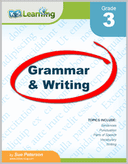
Download & Print Only $6.49
Other Grade 3 Writing Topics
More grade 3 writing exercises.
These worksheets cover other grade 3 writing topics.
Restating the question - restate the question in your reply
Topic sentences - write topic sentences for given texts
Writing similes and metaphors - describe something by comparison to something else
Paraphrasing - rewrite a text in your own words
Formal letter writing - write various types of formal letters
Editing practice - edit a text using editing symbols

Sample grade 3 writing topics worksheet
What is K5?
K5 Learning offers free worksheets , flashcards and inexpensive workbooks for kids in kindergarten to grade 5. Become a member to access additional content and skip ads.

Our members helped us give away millions of worksheets last year.
We provide free educational materials to parents and teachers in over 100 countries. If you can, please consider purchasing a membership ($24/year) to support our efforts.
Members skip ads and access exclusive features.
Learn about member benefits
This content is available to members only.
Join K5 to save time, skip ads and access more content. Learn More
- Forgot Password?

IMAGES
VIDEO
COMMENTS
We hope you enjoyed this list of writing topics for grade 3. They make writing an adventure and can help your reluctant writers practice and develop their writing skills (including grammar and punctuation). Just remember, creating an interesting story and having fun while doing so is key. So emphasize enjoyment and the skills will follow.
Adventure • Story Prompts. A group of kids discover a lost treasure in an old abandoned amusement park. Four friends design and build the fastest roller coaster in the world. Three friends design and build their own crazy treehouse for their club meetings. A brave firefighter saves a cat from a burning building.
More Writing Prompts. Thanks for reading! I hope your students have lots of fun creating awesome stories using these writing prompts. Before you go, check out these related articles for writing prompt ideas: 1st Grade Writing Prompts 4th Grade Writing Prompts Adventure Writing Prompts Fantasy Writing Prompts
10. Tell about a time you helped somebody. 11. Tell about a time somebody helped you. 12. Tell about a memorable "first" in your life. For example, the first time you ate a particular kind of food, the first time you met your teacher, etc. 13. Describe step by step how to make a pizza.
It's a wonderful topic for students who need more structure than the average creative writing assignment provides. 9. Explore and describe the dusty old attic of a dilapidated mansion. This topic is one of the more descriptive writing topics for grade 3. It's compelling to think about, but it doesn't have to be too bizarre.
55 Narrative Writing Prompts For 3rd Grade. As students improve their writing skills, it is important that they explore various types of writing—including narrative writing. Narrative writing is an important step not only in learning to write but also in learning to reflect and think deeper. Whether students are journaling or making story ...
Step 2: Paragraph Writing. The next step will be to familiarize the children with writing small paragraphs. Don't go throwing the list of 3rd grade writing prompts in one go. Instead, focus on strengthening the core concepts of writing. Introduce children to the parts of a paragraph-head, body, and conclusion.
The story writing topics for Grade 3 are also crafted by one of the finest professionals in the English field, promising top-quality content where the students will find the style of story completion for Class 3 comparatively easy. Examples of Usage of Story Writing for Class 3. Here are a few story writing for Class 3 exercises' examples: 1.
How Night Zookeeper can help. Night Zookeeper makes writing fantastically fun for children aged six to twelve! Our language arts program for kids includes thousands of award-winning writing activities, from creative writing prompts, to interactive lessons, to writing games that your child will love! Sign up today and get a 7-day FREE trial!
There are several topics that class 3 students can write stories about. Some of the most popular topics include: 1. Adventure stories: Children love adventure stories, where the main character goes on a quest or explores a new place. 2. Fantasy stories: Fantasy stories are great for encouraging children's imagination.
K5 Learning offers free worksheets, flashcards and inexpensive workbooks for kids in kindergarten to grade 5. Become a member to access additional content and skip ads. Imaginative writing prompt worksheets for grade 3 students. Includes hints.
Topics For Story Writing With Pictures For Class 3. Third-grade students have access to a wide selection of topics while creating picture stories. A Day at the Park, Investigating an Extraterrestrial Planet. My preferred superhero story. An Animal's Secret Life that Talks. A Talking Animal's Secret Life. Journey to a Hidden Treasure.
Third Grade Creative Writing Worksheets. Encourage your third-grade students to show their creative sides, with our most popular creative writing printables. They'll be inspired by these poetry and story-writing activities and lessons. We have holiday-themed worksheets, daily writing prompts, rubrics for grading work, literature guide extension ...
Top 10 Story Ideas. Tell the story of a scar. A group of children discover a dead body. A young prodigy becomes orphaned. A middle-aged woman discovers a ghost. A woman who is deeply in love is crushed when her fiancé breaks up with her. A talented young man's deepest fear is holding his life back.
Here are some topics that Class 3 students can use for writing exercises: 1. Write a story about a magical adventure. 2. Describe your favorite place in the world. 3. Write a persuasive essay about why kids should be allowed to have more free time. 4.
Reading a book in a genre, then having students use a story starter in that same genre. Starting off class with 10 minutes of writing, using one of the prompts below. If you'd like, you can ask a volunteer to share their story! Students may be surprised by the variety of stories that are written based on the same prompt.
These worksheets and writing prompts help students develop their narrative writing abilities. Writing Hooks: Write sentences to grab a reader's attention. Setting: Brainstorm details for the place and time of a story. Character development: Outline a character's traits. Writing dialogue: Create conversations with speech bubbles. Show, don't tell!:
Third grade writing requires children to demonstrate: Effective communication of ideas through written texts. Structured writing pieces, including a short introduction, main body and conclusion. Paragraph-writing skills. Using correct spelling and grammar in their writing (such as tenses and capitalization) Longer and more complex sentence forms.
These "writing about the reading" prompts require students to analyze, synthesize, and connect ideas, fostering a deeper understanding of the material. For example, if first-grade students are working on story elements, after reading a story, a student might write, "The character in the story is a bear who lives in the forest.
To help Class 3 students improve their narrative writing skills, engaging exercises and prompts can be beneficial. Here are a few exercises that stimulate storytelling abilities: 1. Story Starters: Provide students with sentence starters or story prompts to kick-start their narratives. 2.
In class 3, students are introduced to paragraph writing, where they learn about the format, topics, examples, and exercises that can help them improve their writing skills. The format of a paragraph typically consists of a topic sentence, supporting sentences, and a concluding sentence. The topic sentence introduces the main idea of the ...
The day after the class, Stanford put out a statement written by Saller and Jenny Martinez, the university provost, more forcefully condemning the Hamas attack. Immediately, this new statement ...
The face behind ChatGPT said his creation helps him "write faster" and "think more." "I see the path towards, like, this being my super assistant for all of my cognitive work," he told Bloomberg ...
To write an effective dialogue, Class 3 students should follow a specific format. Here are the key elements: Indentation and Punctuation. Each time a new character speaks, start a new paragraph and indent the dialogue. The uttered words should be enclosed in quotation marks (" "). Place punctuation marks like commas, question marks, or ...
Topic sentences - write topic sentences for given texts. Writing similes and metaphors - describe something by comparison to something else. Paraphrasing - rewrite a text in your own words. Formal letter writing - write various types of formal letters. Editing practice - edit a text using editing symbols. Sample grade 3 writing topics worksheet.